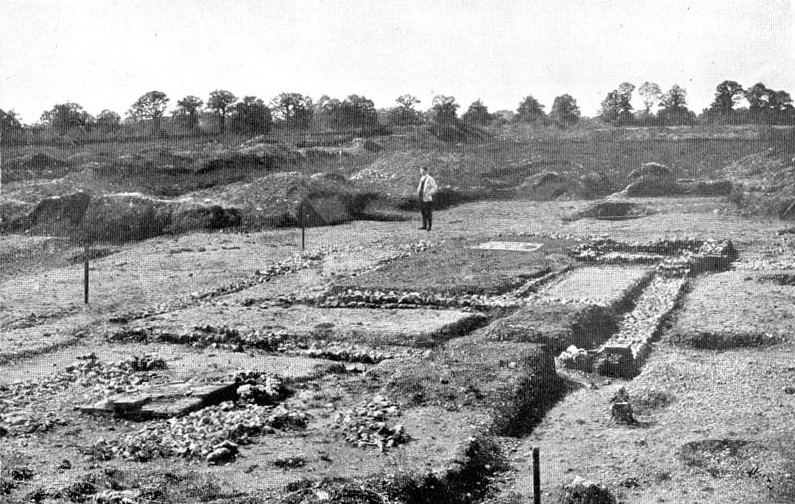
|
|
The Foundations of a Romano-British Church. Uncovered at Silchester. Photograph S. Vidor White & Co. Click to ENLARGE |

|
|
The Foundations of a Romano-British Church. Uncovered at Silchester. Photograph S. Vidor White & Co. Click to ENLARGE |
The Homeland Handbooks—No. 55.
With a view to making future Editions of this Handbook as accurate and comprehensive as possible, suggestions for its improvement are cordially invited. If sent to The Editors, The Homeland Association, Association House, 22, Bride Lane, Fleet Street, E.C., they will be gratefully acknowledged.
COPYRIGHT.
This Book as a whole, with its contents, both Literary and Pictorial, is Copyrighted in Great Britain.
ADVERTISING.
Local.—Terms for Advertising in future issues of this Handbook will be forwarded on application to the General Manager of the Homeland Association, at the above address.
General.—Contracts for the insertion of Advertisements through the whole series of Homeland Handbooks, more than fifty volumes, circulating through the country, can be arranged on application to the General Manager.
| Author's Preface | |
| Dedication | |
| Introduction | |
| Chapter I. | Early British Churches |
| Chapter II. | Early Church Architecture |
| Chapter III. | The Saxon and Norman Styles |
| Chapter IV. | The Early English Style |
| Chapter V. | The Decorated Style |
| Chapter VI. | The Perpendicular Style |
| Chapter VII. | The Renaissance and Later |
| Chapter VIII. | Church Furniture and Ornaments |
| Chapter IX. | Bells and Belfries |
| Chapter X. | The Spire: Its Origin and Development |
| Chapter XI. | Stained Glass |
| Chapter XII. | Crypts |
| Chapter XIII. | How to describe an Old Church |
| Appendix | A Glossary of the Principal Terms used in Ecclesiastical Architecture |
| Bibliography | |
| Index |
The following periods of architectural style may be of use for the purpose of reference, but it must be borne in mind that they are more or less approximate, as each style merged by slow degrees into the next.
| Norman: | William I. to Stephen. | 1066-1154. |
| Transition Norman. | Henry II. | 1154-1189. |
| Early English Gothic. | Richard I. to Henry III. | 1189-1272. |
| Decorated. | Edward I., II., III. | 1272-1377. |
| Perpendicular. | Richard II. to Henry VII. | 1377-1485. |
| Tudor. | Henry VIII. to Elizabeth. | 1485-1600. |
Sharpe gives seven periods of English architecture up to the time of the Reformation, and dates them as follows:—
| ROMANESQUE. | |||
| I. | Saxon | from —— to 1066 | |
| II. | Norman | from 1066 to 1145 | 79 years |
| III. | Transitional | from 1145 to 1190 | 45 years |
| GOTHIC. | |||
| IV. | Lancet | from 1190 to 1245 | 55 years |
| V. | Geometrical | from 1245 to 1315 | 70 years |
| VI. | Curvilinear | from 1315 to 1360 | 45 years |
| VII. | Rectilinear | from 1360 to 1550 | 190 years |
It is a truism that the history of building is the history of the civilized world, for of all the arts practised by man, there is none which conveys to us a clearer conception of the religion, history, manners, customs, ideals and follies of past ages, than the art of building. This applies in a special sense to cathedrals and churches, which glorious relics reflect and perpetuate the noble aim, the delicate thought, the refined and exquisite taste, the patient and painstaking toil which have been expended upon them by the devout and earnest craftsmen of the past.
There are very few of our ancient churches in village, town or city which do not offer some feature of interest to the visitor, and in the absence of anything more important, there is sure to be some door, window, font, screen, or other detail which will amply repay him for the small amount of time spent in seeing it.
The aim of the author of this little volume has been to indicate the symbolism and meaning attaching to the various portions of our churches and cathedrals, and to endeavour briefly to describe, in language as simple as the subject will allow, the various styles of ecclesiastical architecture with their distinctive characteristics in such a way as will enable the reader to assign each portion and detail of a church to its respective period with an approximate degree of accuracy.
He does not claim to be original, but endeavours to be useful and interesting. The best authorities have been consulted and freely drawn upon, but with the object in view of writing a book at once thus useful and interesting, no attempt has been made to deal with the subject in a strictly architectural, or a purely scientific manner.
Weymouth, 1906.
To all those who love old buildings—cathedrals, abbeys, and village churches, which breathe the spirit of an age with which we have entirely broken—and who would fain hand down to posterity, unmutilated, the great building achievements of our forefathers, which we, with all our science, wealth, and means of curtailing labour, can no more imitate than we can reproduce the language of a Chaucer or a Shakespeare; this book is respectfully dedicated.
S. H.
| "Firm was their faith, the ancient bands, |
| The wise of heart in wood and stone, |
| Who reared with stern and trusting hands |
| Those dark grey towers of days unknown; |
| They filled the aisles with many a thought, |
| They bade each nook some truth recall |
| The pillared arch its legend brought, |
| A doctrine came with roof and wall." |
| —Hawker of Morwenstow. |
However much we may admire, considered purely as art, the Pagan temples of the Greeks and Romans, we must confess that they are lacking in those high ideals and those sustained and inspired motives which seem to penetrate and permeate the buildings and churches of the Christian era. Perfect as is Greek art within its somewhat narrow limits, it is, nevertheless, cold, precise and lifeless. The Gothic buildings on the contrary are pregnant with the very spirit of life.
Prompted by a deep and fervent faith in their religion, the Gothic builders and sculptors unconsciously wove into the humblest of their architectural enrichments some portion of their daily life and personality. The slave-built temples of the Greeks offered no scope for the exercise of individual expression—such, in fact, would have been strongly resented—whereas the early Christian craftsman, revelling in his freedom, seized every opportunity of expressing in his work his joy, fear and hope of immortality.
This is made apparent in the study of an old church, whereof every portion—door, window, bench-end, carving, gargoyle—has hidden about it some suggestion of beautiful thought, or some distinct and appropriate symbolism. The fact that symbolism underlies almost every[10] such indication of mediæval thought is made abundantly manifest in the study of mediæval literature. Open any 12th century treatise on morals, science or history, and you become aware of the fact at once.

|

|

|
| Norman. | Stilted. | Horse Shoe. |
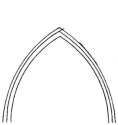
|
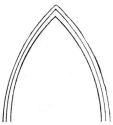
|
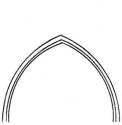
|
| Equilateral. | Lancet. | Drop. |
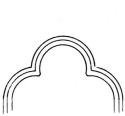
|
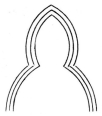
|
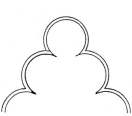
|
| Trefoil. | Trefoil. | Cinquefoil. |

|

|

|
| Ogee. | Four Centered. | Tudor. |
|
The Various Forms of Arches |
||
The main-spring of this symbolism, of all Christian symbolism, turns on the parabolic meaning in the scheme of Creation. The early writers were far less concerned with recording the plain objective facts of history, than in pursuing the[11] allegory and the love of the marvellous, and showing all those characteristics of what we now term an unscientific attitude of mind.
In its widest sense, symbolism means the expression of belief, and if we would interpret history aright, we must grasp the fact that the key to the character and disposition of peoples of all ages lies in the knowledge of their beliefs; for out of the beliefs of one age most surely grow the beliefs of its successors, and in no work of man's hand are the beliefs held by various peoples in past ages more clearly defined than in our cathedrals and churches, which noble buildings in every civilized country indicate principles as well as facts, influences as well as results; and while presenting the finest materials for æsthetic study, are no less useful as indicating the psychological peculiarities of those builders of old to whose condition they bear witness.
In our grand specimens of ecclesiastical architecture, we may read the world's later history, and to-day they breathe the sombre reverential influence of a faith which sought to satisfy itself with the visible symbolizing of those half-poetical, half-superstitious conceptions with which the religion of the Middle Ages was so deeply imbued.
An early development of decorative symbolic art, known as Celtic, of which we have examples on old Irish crosses, and particularly on illuminated MSS. was wrought by the Christian monks of the 7th and 8th centuries, but what is generally understood as Christian symbolic art had its finest development about the 13th century. Gothic art is essentially symbolic and in many instances, its individual forms have specific significance. Thus the common equilateral triangle was used to symbolize the Holy Trinity, as are the two entwined triangles. Other symbols employed at this period setting forth the mystery of the Unity of the Trinity, without beginning and without end, are three interlaced circles, and a very curious one is that in which three faces are so combined as to form an ornamental figure. Baptism under the immediate sanction of the Divine Trinity was represented by three[12] fishes placed together in the form of a triangle.
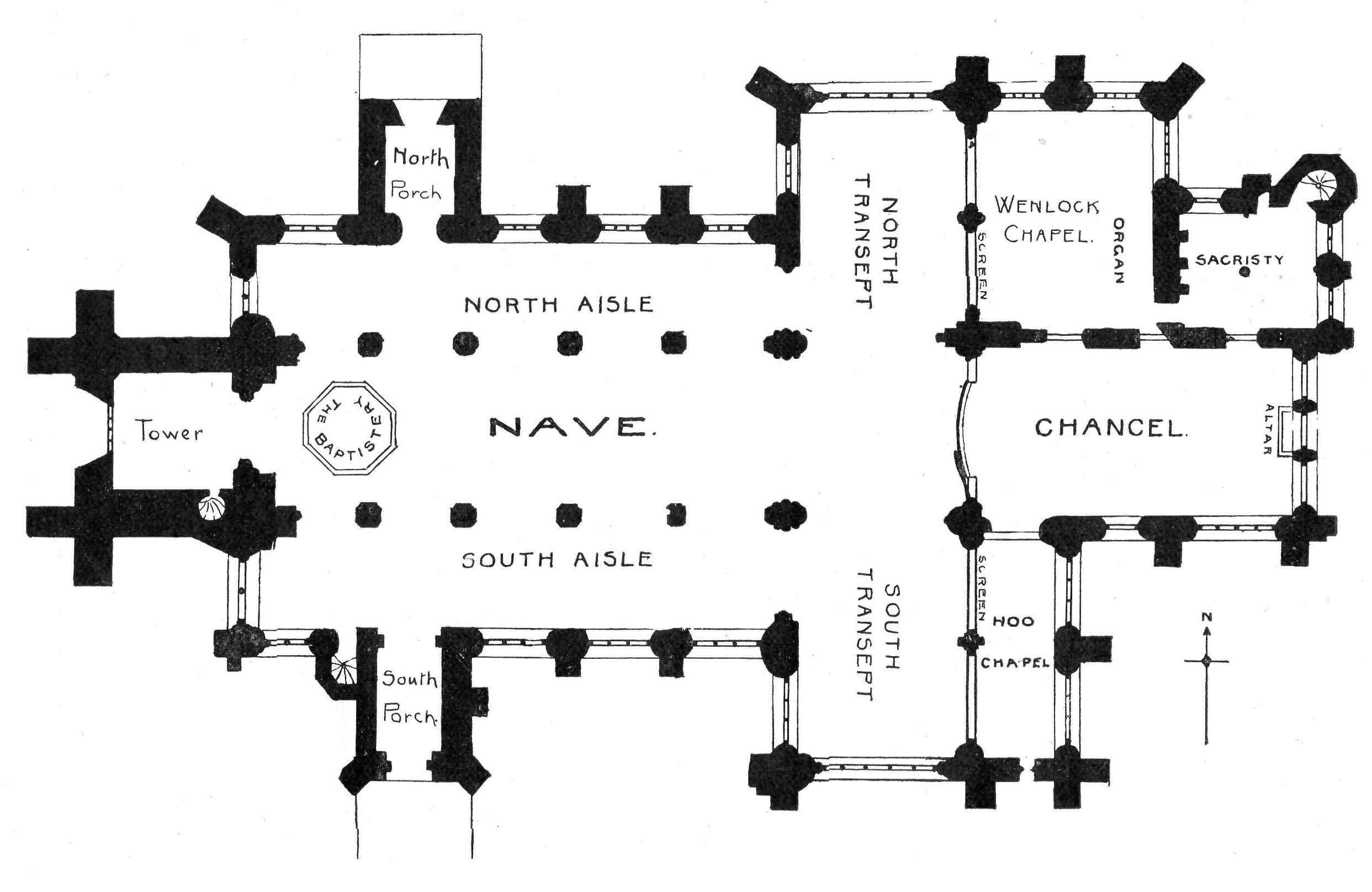
|
|
Plan of a Typical Gothic Cruciform Parish Church. (St. Mary, Luton, fully described in No. 47 of this Series). Drawn by Ed. Craven Lee. Click to ENLARGE |
[13] So numerous, indeed were such Christian symbols after the 9th century that a mere enumeration of them would occupy considerable space. Every trefoil symbolized the Holy Trinity; every quatrefoil the four Evangelists; every cross the Crucifixion, or the martyrdom of some saint; and in Gothic ornament and decoration, we find the Chalice, the Crown of Thorns, the Dice, the Sop, the Hammer and Nails, the Flagellum and other symbols of our Lord's Passion.
Although presenting the same characteristics in their external design, our town and village churches are very various. The simplest form, and the one most commonly found, is that of a nave and chancel, with a tower at the west end; to which plan may be added aisles and transepts, the latter often being wrongly called "cross-aisles." When the walls of the nave above the arcade rise above those of the aisles and are pierced with windows, the upper portion is called the clerestory, the meaning of which word is not free from obscurity; it seems probable that it indicates the clear story—the story which rises clear of the nave and aisles. In large buildings, they are important both for utility and beauty, but in small and early churches, they are of less importance.
It is a well-known fact that the chancel and nave of a church generally stand east and west. This arrangement, called the orientation, is symbolic of the teaching that to the east we are to look for assistance and protection against the power of our enemy, and that as we pray we may look for the day-spring, symbolized to us in the rising sun that sheds light and warmth all over the earth.
The public entrance to a church is generally at the west end (the priest usually had a door in the chancel for his own use). Through this door we enter the house of prayer, for as in the east we see the emblem of the Lord of Life and Light, so the west represents the seat of darkness and of the powers of evil.
The earliest porches were those of the early Christian basilica churches; they were long and arcaded and were[14] called "narthex." In later times, they assumed two forms, one the projecting erection, covering the entrance and divided into three or more doorways, and the other a kind of covered chamber open at the end and having small windows at the sides. These latter are generally found on the north and south sides of the nave. Formerly, when church government was more rigorous in discipline than is now the case, the porch was the appointed place for those who were under censure. Those also who were unbaptised, or who had not yet received the sacrament of regeneration, were not allowed beyond the porch, not quite excluded from the church and yet not permitted to enter fully. The porch also served as a path of admission for all Christians into the body of the church, so that they passed through the assembly of penitents and catechumens, who were wont to ask the prayers of the more highly privileged for their full restoration or admission to the communion of the faithful.
With reference to our Lord's word, "I am the Door," we frequently find the tympana of church doors, particularly those of Norman date, adorned with representations of events from his life, but they often also depict the monsters, dragons and devils, that formed so strong an article in the faith of the early Christians.
A more detailed account of these tympana will be found in a following chapter.
Passing through the porch we enter the nave, which word is derived from the Latin navis, a ship. Its symbolic teaching is that of the Church riding triumphantly and buoyantly on the troubled and dark waters of the world. The first thing noticed on entering the nave is the font, which was formerly placed outside the church, in a separate building called the baptistery; a few of our churches have retained these little buildings which now form part of the churches proper.
The reason in early days for placing the font outside the church was that the Christian was not admitted into the nave until he had been baptised and confirmed, the latter rite being administered immediately after baptism.
From the western door there is a clear passage through[15] the centre of the nave, called the aisle, signifying the straight and narrow way from the seat of darkness to immortal life. On each side of this aisle are seats for the laity, with room for standing and kneeling. The nave was usually divided from the chancel by an open screen of wood or stone, signifying that although the Christian might have some insight into the mysteries of the priest's office, at the same time these were to be partly concealed from his view. The rood screen was so called from the fact that the great Rood, or Crucifix, stood above it, not always on the screen itself, but on a separate beam, to which was often attached a rood loft or chamber. In early days, the lessons were read from the top of the rood screen, and in many of our churches the stairways leading thither have been retained.
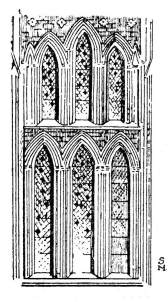
|
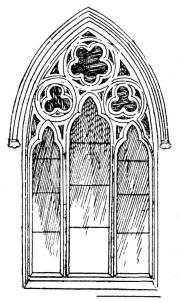
|
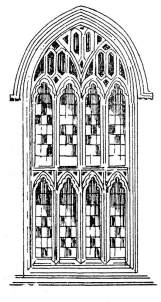
|
| Early English. | Decorated. | Perpendicular. |
|
Examples of Gothic Windows See also page 59. |
||
In churches where the screen has vanished, the division of the nave from the rest of the church is plainly marked by the chancel arch. The chancel is emblematic of the Christian perfection, of the Church triumphant in heaven.
In an old church, a piscina is nearly always found in the chancel, and here, too, were the sedilia or seats for[16] the officiating clergy, the prior, sub-prior, and the deacon, the last-named occupying the lowest seat.
Founders' tombs also nearly always occupy positions in the chancel, and these tombs differ from all others in that they form an integral part of the structure, and could not have been added after the church was completed.
Another thing sometimes to be seen is the ambery, or aumbry, a small cupboard let into the chancel wall, in which were kept the communion vessels, the chalice, paten, etc.
The great object of interest, however, in the chancel, is the altar, which Archbishop Laud directed should be enclosed by rails, so that although the people may draw near, they cannot touch the holy table, but must accept from the hands of the priest those gifts of which he is the minister from God.
Altars are fully described in a following chapter, but we may here note that the reredos, so universally found in our cathedrals, abbeys, and in many of our churches, forms no part of the altar, and the Court of Arches has decided that there are no altars in the Church of England, but only communion tables.
Prominent among the external enrichments of our churches is the gargoyle, a word derived from the French, "gargouille," which in its turn comes from the Latin "gurgulio"—a water-spout. The earliest gargoyles are merely orifices with a lip to shoot the water well away from the fabric. The true gargoyle, however, was quickly evolved from this primitive form, and consists of two parts, the lower one forming the channel, the upper one being the cover. The full significance of the skill displayed by the old masons in the rare opportunity the gargoyle afforded them of representing the dragons, serpents, etc., in which their fancy revelled, is made apparent when we view the futile attempts of modern architects to introduce this feature in their churches, for modern gargoyles are generally grotesque caricatures, and anything but happy appendages to the buildings to which they are attached.[17]
|
|
|
||||||||||||
|
Examples of Buttresses Drawn by E. M. Heath |
||||||||||||||
The churchyard, so pleasing an adjunct to the House of God placed within it, is frequently approached through a lych-gate, which word is derived from the Saxon lich,[18] a corpse. These gates in our country churchyards are often very picturesque little structures, and under them the corpse at a funeral awaited the officiating priest before being taken into the church. The churchyard is commonly regarded as a mere dependency of the church, and as having a history very inferior in interest to that of the temple to which it is the court. The truth is that many of our churchyards have an antiquity far greater than that of the churches, as many of them constituted the open-air meeting-places of our Saxon forefathers long before the erection of parish churches. In the common meeting-place a cross was set up, either of wood or stone, to mark and hallow the spot, and when a church was subsequently built it was usually in the immediate vicinity of the cross, which accounts for the fact that many churchyard crosses are of older date than the churches themselves.
Wells of water are often found in old churchyards, and as the regulations of the Saxon church required immersion and not sprinkling, it is possible that these were the Saxon fonts.
Such then is the necessarily brief attempt to describe the main lines on which our old churches were planned, and the motives and ideals which animated their builders, who, being impressed with the dignity and mystery of the works of God, made their churches symbolical of the portions of the Christian life; the porch signifying baptism, the nave the life militant on earth, and the chancel the life eternal; while every little ornament, piece of sculpture and enrichment was designed to remind the worshippers of their faith, of its hopes, blessed promises and rewards.
In dealing with the introduction of church architecture into our own land, the task would be much simplified if one could state with certainty when the first church was built on British soil. Some historians assert that the Church of England as it is constituted to-day dates no further back than the moment when S. Augustine and his followers landed on the shores of Kent in the year 596, yet one is probably justified in assuming that a church existed in these islands for centuries previous to the arrival of the Roman missionaries. Unfortunately we have no records to guide us as to the date of this earlier settlement, and the name of the first Christian missionary to heathen Britain has still to be discovered. "We see," says the quaint old historian, Thomas Fuller, "the light of the word shined here, but see not who kindled it." The first Christian building of which we have any record was probably that erected at Glastonbury before the year 300, but that this was the first Christian settlement cannot be alleged with certainty.
There are many traditions concerning the introduction of Christianity into Britain, some of which may probably have some bearing on the truth, but the whole subject is involved in considerable obscurity. One of these numerous traditions is to the effect that the British King Caradoc, after being taken prisoner to Rome, was allowed to return, on condition that several members of his family remained as hostages; and whilst serving in this capacity, his mother, son, and daughter are stated to have become converts to Christianity, the doctrines of which faith they spread in their native land on their return thereto. Another tradition is to the effect that S. Paul himself visited Britain and laid the foundation of the Christian faith.[20]
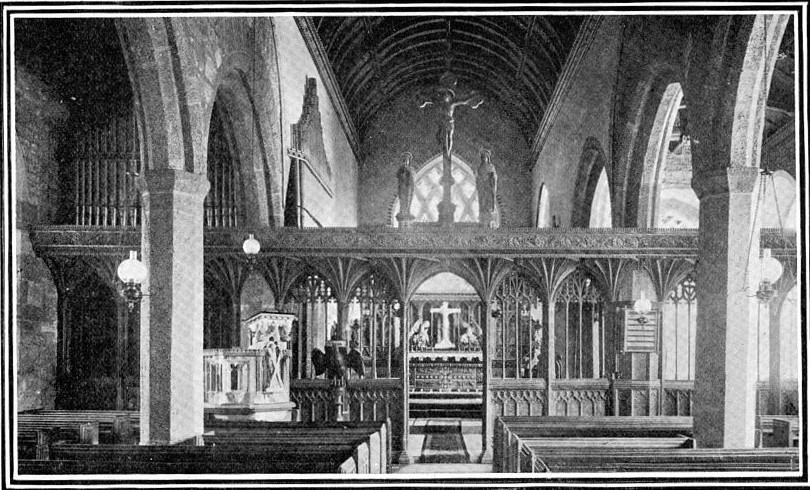
|
|
A Rood Screen with a Restoration of the Rood. Kenn, Devon. Photograph by Chapman. Click to ENLARGE |
We are also told by eminent church historians[21] that the father and grandfather of S. Patrick were Christians, in which case S. Patrick himself would from a very early age have been brought up in the tenets of their faith. He is said to have been seized by pirates in the Clyde and taken to the north of Ireland, and eventually to Gaul. He was subsequently restored to his friends, whom he wished to convert to the Christian faith, and for this purpose his father sent him to be taught in the schools of Tours, Auxerre and Lerins. Eventually he was consecrated Bishop of the Irish and organized an efficient ecclesiastical system in Ireland.
Before the coming of the Anglo-Saxons the church seems to have established a firm hold on the people, who held tenaciously to their possessions, both secular and religious, which were only wrested from them after a severe struggle. Their enthusiastic love of Christianity led them to make a heroic defence of the churches, rather than see them fall into the hands of the heathen Anglo-Saxons. The historian Bede tells us that all their buildings were destroyed, the priests' blood was spilt upon the altars, prelates and people were slain with the sword, and all the cities and churches were burnt to the ground. When all was lost and there was no longer a church or home to defend, the Britons retired to the country of their fellow-Christians, the secluded and almost impenetrable hills and forests of the west. The Anglo-Saxon love of gold was quickly recognised by the people of West Wales who saved their property and bought the right of worshipping after the manner of their fathers by the payment of an annual tribute to their conquerors.
So ruthlessly indeed did the Anglo-Saxons rase to the
ground the early churches, that, until a few years ago, but
few traces of these early buildings were thought to exist.
Church of
S. Piran, Perranporth.
An accidental discovery, however, in the year 1835,
brought to light an undoubted relic of an
early British church in the west, this being
the remains of a little church which had
been until the date above mentioned completely
buried in the sand on the sea coast
near Perranporth in Cornwall. They are thought by[22]
ecclesiologists to be the remains of the original church
erected to the memory of S. Piran, a Cornish missionary
and a friend of S. Patrick, who was buried within its
walls before the year 500 A.D. On removing the sand,
the accumulated deposit of centuries, the church was
found to have consisted of a nave and chancel
containing a stone altar.
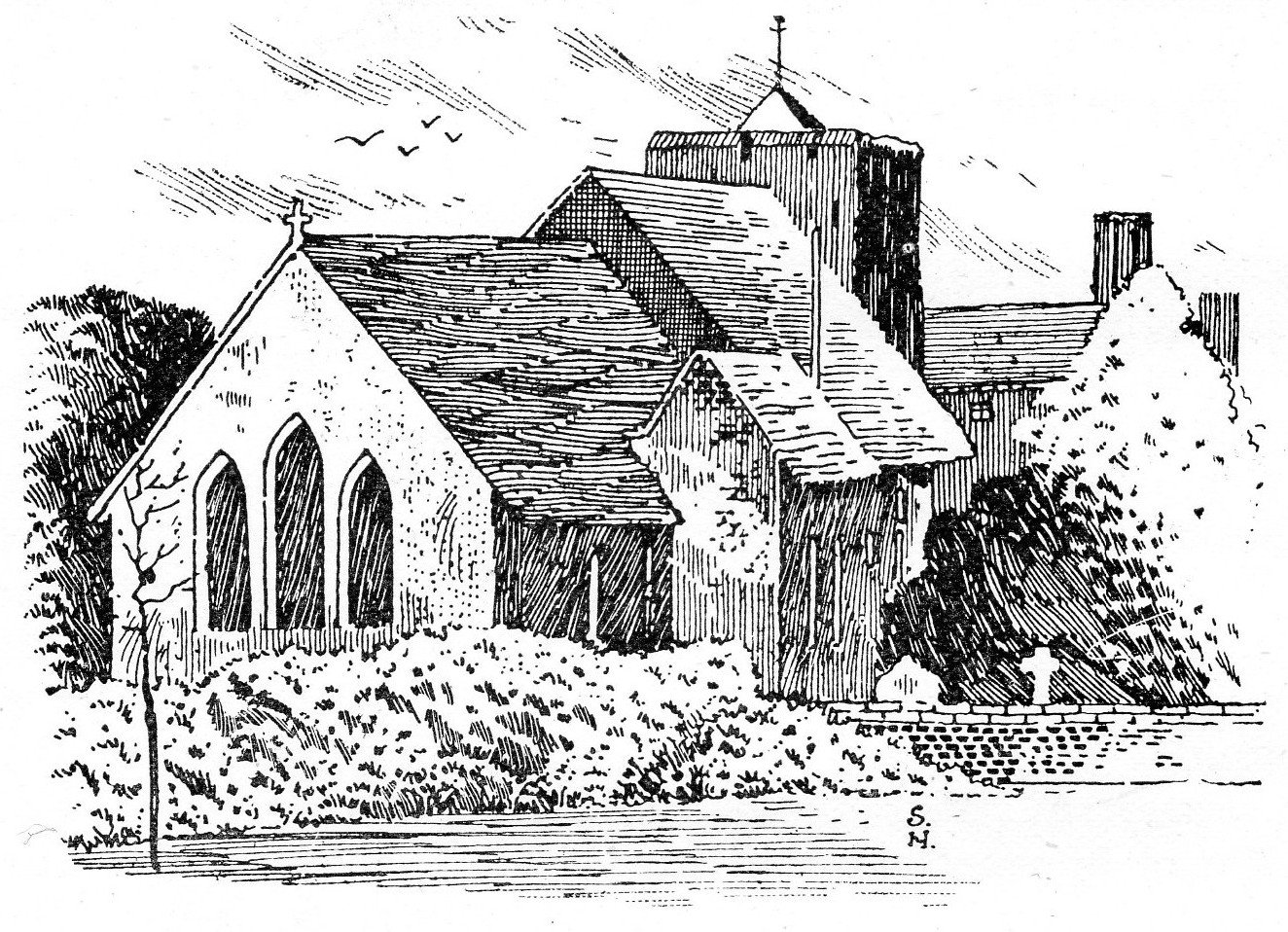
|
|
The Church of S. Martin, Canterbury. Click to ENLARGE |
The building measured 29 feet in length, 161⁄3 feet in width and 19 feet from the floor to the roof, and probably shares with S. Mary's Church in Dover Castle, and S. Martin's, Canterbury, the honour of being one of the earliest links we possess with the ancient British Church. S. Mary's, Dover, appears to have been built of Roman bricks and cement, a combination which antiquaries consider is found only in those buildings which were erected during the Roman occupation.S. Martin's, Canterbury. S. Martin's Church, Canterbury has many claims to be considered one of our most interesting churches, no less on account of its associations than for its structural interest. The date of its building has been a[23] source of endless controversy, as it contains many features attributable to either Roman or Saxon architecture. It is thought that it may possibly have been used for worship by the Christian soldiers of the Roman army. Be this as it may, it is established beyond doubt that it was the oratory of Queen Bertha, the first English Christian queen, who here worshipped, with her chaplain Liudhard, long before the advent of S. Augustine, who himself in later times preached here; and within the walls of this cradle of English Christianity, Ethelbert, King of Kent, the husband of Queen Bertha was baptized. The Venerable Bede, writing within a hundred years of the death of S. Augustine states that there was in 597 A.D. in Canterbury, a church "dedicated to the honour of S. Martin and built while the Romans still occupied Britain." On the departure of the Romans it is probable that the church was still used by a small band of Christian worshippers until the heathen Jutes overran the Isle of Thanet in 449.
Little is known of the progress of Christianity on this island from that date until the landing of S. Augustine in 597, and the first fruits of his mission, as we have seen, was the conversion and baptism of King Ethelbert. As one would naturally expect, the aspect of the structure to-day, though suggestive of antiquity, is lacking in uniformity of treatment. The brick courses in the nave are at irregular intervals, varying from nine to twenty inches apart, the spaces being filled with Kentish rag-stone and occasional blocks of chalk. The chancel extends eighteen or twenty feet east of the arch and is composed of Roman bricks, evenly laid and averaging four bricks to a foot. The chancel was lengthened at the beginning of the thirteenth century and again at a more recent date, so that its architecture to-day is of three distinct periods. Outside may be seen five flat pilaster buttresses and one semi-circular one, a square-headed Roman doorway, a Saxon doorway and two Early English porches; and there is also a nearly circular panel on the south side of the nave, and a Norman squint at the west end. There are many other features of interest which bear evidences of a great antiquity, and[24] the only question which is seriously disputed is whether the earliest portion of the present nave was built about the end of the Roman occupation of Britain or during the mission of S. Augustine.
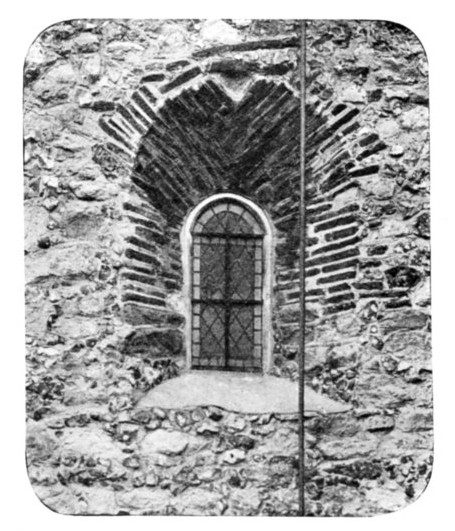
|
|
An Ancient Window built with Roman Brickwork. Swanscombe, Kent. Photograph Mr. G. H. Smith. Click to ENLARGE |
The Rev. Charles F. Routledge, M.A., F.S.A., Hon. Canon of Canterbury Cathedral, writes: "Whatever may finally be determined to be the date of the church's foundation, it can never lose its unique association with S. Augustine, King Ethelbert and Queen Bertha, nor its undisputed claim to be the oldest existing church in England. From it flowed the tiny spring of English Christianity, which has since widened out into a mighty river, and penetrated the remotest parts of the civilized and uncivilized world."
Among other churches which show signs of having[25] been built during the Roman occupation are those ofOther Early Churches. Reculver, Richborough and Lyminge, while the foundations of an undoubted early church have been discovered in the old Roman city of Silchester, in Hampshire. See frontispiece. The old church at Reculver stood originally within the Roman castrum, the fortress which guarded the northern mouth of the Wantsume, now a small stream, but once an arm of the sea dividing the Isle of Thanet from the mainland. The greater part of this church was pulled down in 1809, but the western towers, known as "the sisters" were repaired by Trinity House, as they constitute a useful landmark for mariners, being visible at a great distance.
Reculver church was built about A.D. 670, and from the existing walls and foundations it is clear that its plan was basilican. The church is now a ruin, but some stone pillars which supported the arches are preserved in the Cathedral Close at Canterbury.
As Reculver guarded the northern mouth of the watercourse, so Richborough protected the south, and here traces of a chapel in the form of a cross are plainly discernible amongst ruins known to be of Roman workmanship. The old church at Lyminge in the same county is thus described by Canon Jenkyns, in his "History of Lyminge":—"The Roman foundations discoverable at the south-east angle of the chancel, together with the remarkable half-arch that intervenes, marked the site of the aquilonalis porticus—the title of basilica already given to it in the seventh century establishes its claim to great antiquity."
We thus see that although remains of the actual buildings in which the British Christians worshipped are few in number, yet enough are left us to prove conclusively that there was a very active and zealous Christian community established in these islands during at least the period immediately preceding that in which Rome withdrew her legions from Britain in order to defend Italy against the Goths, and abandoned our island to the mercy of her foes.
In the early years of the Christian Church, when its members became sufficiently free from persecution to erect buildings for the purpose of worship, they were naturally anxious to avoid any of the forms peculiar to either heathen or Jewish temples. Some model, however, was necessary, and their choice being limited, they appear to have adopted the simple style of the Roman basilica, or court of justice. There was an adaptability about the general plan of such a building which rendered its selection natural and not inappropriate, while the dignified simplicity of its construction and the object for which it was primarily founded—the dispensation of justice—commended it no doubt in the first instance as a model for the primitive Christian church. These basilicæ were usually enclosures surrounded by a colonnade, sometimes roofed, but more often open to the air, and designedly built for the purpose of being accessible to all members of the community at all times of the day. They appear occasionally to have been used for the transaction of ordinary business in which they would closely resemble our exchanges. Be this as it may, this form of architecture has left its impress on many Christian buildings, and the name of basilica, for a church, is still used in many parts of Italy.
The Roman basilica was usually in the form of a parallelogram, with a seat for the judges at one end, and in their adaptation of this form of building, the early Christians devoted this place to the purposes of an altar. This, by an easy and natural transition, is thought to have given rise to the formation of the semi-circular recess at one end of the building, known as the apse (from[27] the Latin apsis, a bow or arch), which is still to be found in some of our older churches.
Being thus Roman in the nature of their ground plan, it is not surprising to find that other portions of the early Christian buildings show decided characteristics of a Roman style. On the destruction of the Pagan temples by order of the Emperor Constantine about the year 330, much of their material was built into the earliest Christian churches, and the Roman character of their design being prevalent, they formed a style of architecture which has been designated Romanesque, of which the later styles, known here as Saxon and Norman were largely modifications. There is no reason to doubt that the earliest Christian churches were very unpretentious in form and that some time elapsed before there was anything which could be called a definite church architecture, beyond that to which we have alluded. Nevertheless, as the Church strengthened her position and grew in security, more attention was devoted to the subject of its edifices, and the departure in time from the original ground plan furnished an opportunity for the introduction of a more symbolical and appropriate design. The plan of the old basilica was abandoned for one in the form of the cross, the accepted symbol of the Christian religion, which departure, however, did not involve any very great alteration from the old ground plan.
We come then to the time when one or other of the forms known as the Latin or the Greek cross—whichever was most convenient—was usually employed in a building designed for Christian worship, and these forms are universally found in the most elaborate structures of which the Christian Church can boast.
As time passed, these cruciform churches were surmounted with a dome, steeple, or tower at the point where the members of the cross intersected each other. At first the most prominent of these external adornments was the dome; a characteristic of the architecture of Eastern Europe, which acquired the name Byzantine, from its having been carried to great perfection in Byzantium (Constantinople), the capital of the Eastern Empire.[28]
The church of S. Sophia, which was built, much as it now exists, early in the sixth century, and was afterwards converted into a mosque, is an almost perfect example of the Byzantine style. In this building we find the Roman arch used in a variety of ways, while the dome itself is formed entirely of this arch used as the crowning work of the edifice. Eastern churches in this style usually took the form of the Greek cross, this form being better calculated to support the weight of the cupola. In Western Europe, however, where the flat squat tower afterwards developed into the steeple, as we shall see in a later chapter, the Latin cross was mostly used, and this, with a few notable exceptions, is the plan of most western churches.
With writers of about fifty years ago, it was a favourite theory that the Christians converted the old basilicæ into churches, and that the "Halls of Justice" erected by the Romans in this country were also converted into Christian churches, and some authorities point to the walls and arches of Brixworth church in confirmation of this theory. The late Mr. J. W. Brewer, however, stated that unfortunately for this theory, no single example of a basilica being converted into a church has been found in this country and he himself held the theory that the word basilica was used by the Romans to describe any building which was supported by internal columns, and in that way the name came to be applied to Christian churches.
As we have seen, the early Christians, after a short time, became dissatisfied with these buildings adapted from Pagan types, and the Byzantine form of church arose, the first people who practised this style of building being the Greeks. The style spread with rapidity all over the East, the great church of S. Sophia being its largest example and the smaller, but more perfect, church of S. Mark at Venice giving us the best idea of this form of church architecture. Largely modelled on this style, also, are the circular baptisteries of Italy and the round churches of England, France and Germany, the modern Russian churches and all the Mohammedan mosques. The[29] Latin churches did not greatly favour this style and their use of it was confined, with few exceptions, to baptisteries, monumental chapels and the like, but for parochial, cathedral and monastic churches, the oblong plan was retained and ultimately developed into the Gothic church with its nave, transepts and chancel.
The changes which the Christian basilica at first underwent were simple, viz., the use of the arch instead of the straight lintel, or the placing of an entablature between the columns; a little later, about the tenth century, the old wooden roof of the basilica gave place to the arched roof or vaulting, so called from its being composed of a series of vaults. The styles called Romanesque and Lombardic are but geographical varieties of the same architecture and from these the Saxon and Norman styles were soon to be developed. The vaulted basilica church soon became common over the north of Europe, the two most important and practically unaltered examples being the cathedrals of Speyer and Worms, in Germany, although our Anglo-Saxon cathedrals of Peterborough, Ely and Norwich may, so far as regards their naves, be justly regarded as the offspring of the vaulted basilica style of building.
When the old basilica style of church with its heavy beam roof and its innumerable columns had ceased to satisfy the lofty aspirations of Latin Christianity, and when the Greeks had inaugurated a new style of church architecture, only two courses were left to the Latins, either to adopt the Greek style in its entirety, or to improve upon the basilica type. Fortunately, although after considerable hesitation, they chose the latter alternative, the result being the genesis of our glorious cathedrals with their long naves and aisles, deep transepts and beautiful variety of form and outline.
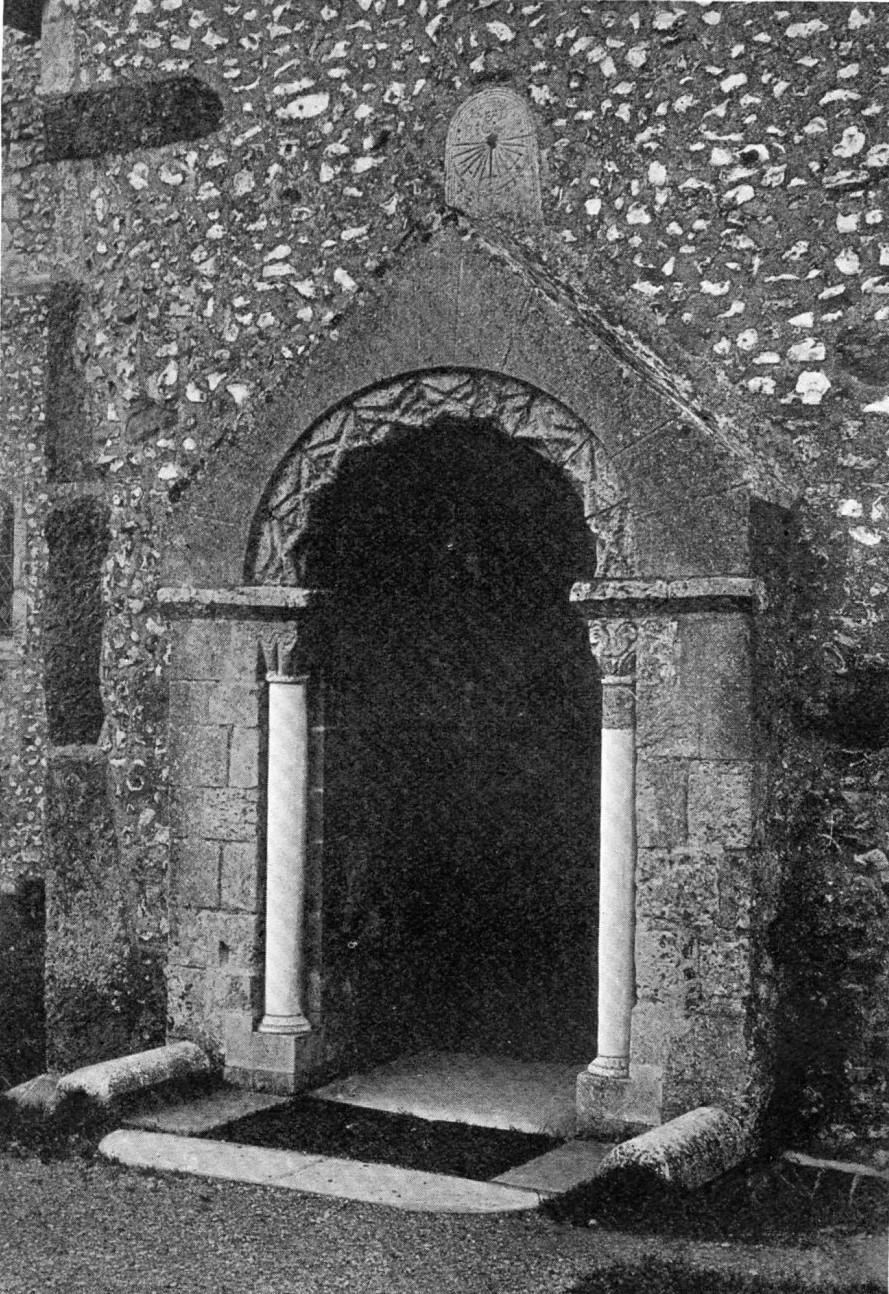
|
|
A Reputed Saxon Doorway. Bishopstone, Sussex. Photograph Mr. W. Hodgson. Click to ENLARGE |
As we have seen in the previous chapter, the whole subject of pre-Saxon church building is still very obscure, and for some considerable time after the Anglo-Saxon invasion little is known concerning church architecture, nor has it yet been fully ascertained whether any buildings of this period exist. By the year 588 the Saxons were in complete possession of the land. Christianity was to all appearance wiped out and the Church, to the superficial observer was dead. In his "History of English Church Architecture," Scott expresses the opinion that the oldest English churches may be divided into three groups. First, those which preceded the Danish invasion; secondly, those from the above epoch to the invasion of Sweyn; and thirdly, those onward to the Norman Conquest.
What exactly constituted Saxon architecture has long been a controversial point and one which will probably never be definitely settled. Parker, in his "Glossary of Architecture," says:—
"For a considerable time, after they (the Anglo-Saxons) had established themselves in this country, their buildings were of wood, and this appears to have been the prevailing material employed at the time of the Conquest, although stone had been occasionally used several centuries earlier…. No timber-work of Saxon date can be in existence at the present time, but it is contended by some antiquaries that several of our churches exhibit specimens of Saxon masonry; the truth of this theory, however, is not fully established, nor has the subject of Saxon architecture been yet sufficiently investigated to clear away the obscurity in which it is involved."
Probably few of our so-called Saxon churches were built earlier than thirty or forty years before the Norman Conquest, and it seems certain that for some years after they had settled in England, the Normans employed[32] Saxon masons to build in the Saxon manner, as is seen by the tower of S. Michael's Church, Oxford, which, although showing all the characteristics of reputed Saxon masonry was built many years after the Battle of Hastings. Certain it is that these pre-Norman buildings in England were singularly rude and rough and show how much our Saxon ancestors were, at that period, behind the Italians, French and Germans in architectural skill.
Our best examples containing Saxon work are possibly the churches at Sompting and Bishopstone, Sussex; Bradford-on-Avon; Wootton Wawen (sub-structure of tower); Wing; Brixworth, and Barnack, Northants; Greenstead in Essex; and S. Martin's at Wareham, Dorset. Of towers of this date the best are possibly those of S. Mary's and S. Peter's, Lincoln and S. Benet's, Cambridge. Of crypts, the finest examples are at Ripon Cathedral, York Minster (part) and S. Mary's Church, York. In addition to these, many other churches have chancel arches, doorways or some other less important features which are considered to be of Saxon origin.
These early buildings generally show the semi-circular arch on the doorways, but the windows usually have a triangular head; at Sompting church, however, the windows have the semi-circular arch. It is necessary to say a few words in detail about the more important churches of this era.
The church of S. Lawrence at Bradford-on-Avon is one of the oldest unaltered churches in England, and it seems to be beyond question that it is the actual church built by Ealdhelm at the beginning of the eighth century and dedicated by him to S. Lawrence. It consists of a chancel, nave and north porch, and among its remarkable features is its great height and the extreme narrowness of the round-headed arch between the nave and the chancel, a feature it has in common with the Saxon church of S. Martin at Wareham; the ground-plan measurements of both these churches are[33] identical. At S. Lawrence's church, an incised arcade is seen outside the walls, and on either side of the west aspect of the chancel arch are two sculptured figures of angels, which are thought to represent the earliest extant fragments of church carving in England.
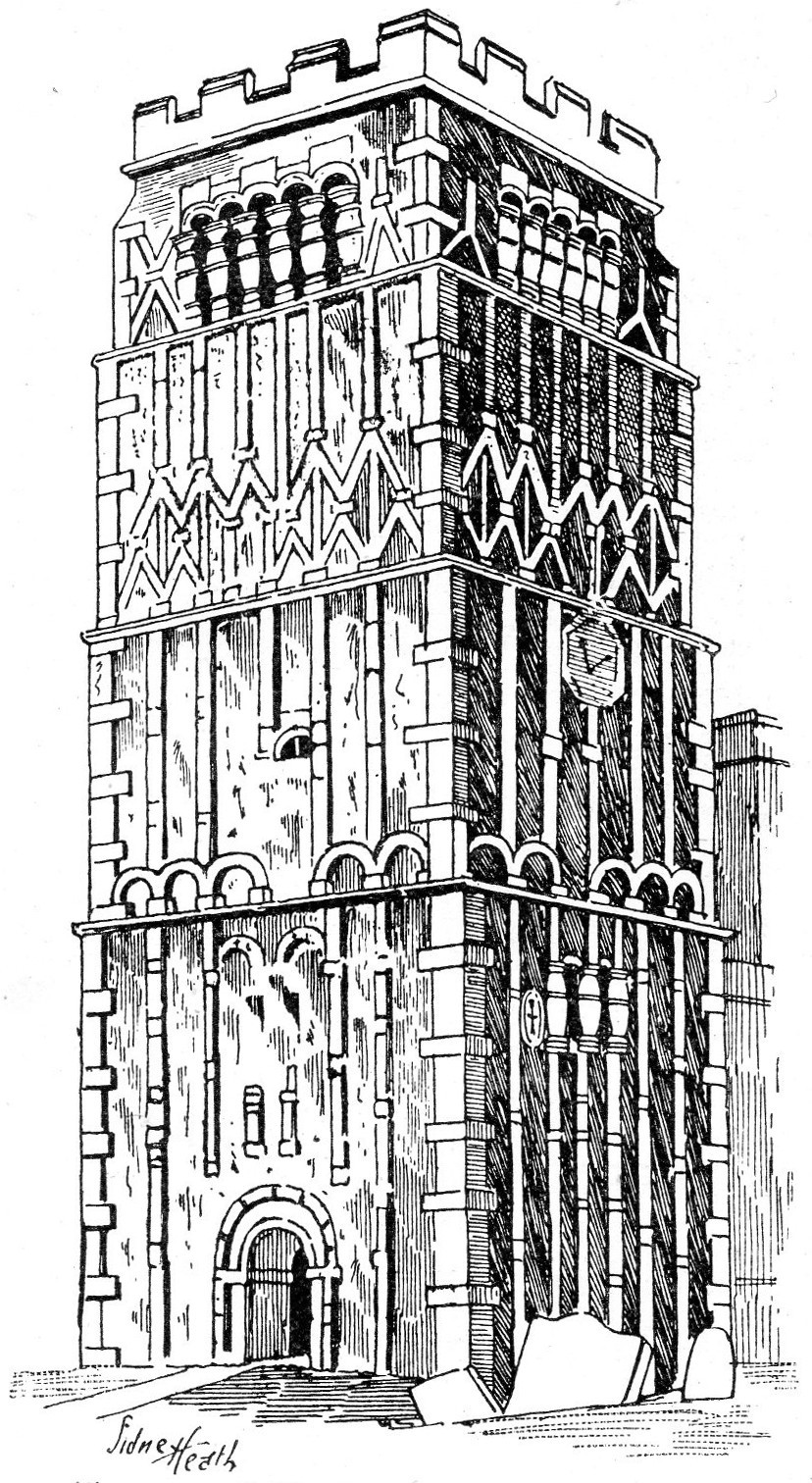 Tower of Earls' Barton Church
Tower of Earls' Barton ChurchBrixworth church is possibly older than S. Lawrence's and it is said to have been in continuous use for Divine Service ever since it was erected. The tower appears to be of rather later date than the nave and rests upon the walls of a "narthex" or portico, which may have extended along the whole breadth of the front, as is still to be seen in churches at Rome and Ravenna. The curious pile of masonry built up against the tower may have been added for defence, as it could hardly have formed part of the original design.
Earls' Barton and Barnack churches both have towers so covered with narrow projecting strips of stonework that the surface of the walls appears divided into rudely formed panels. The west doorways of both show primitive imitations of Roman mouldings in the imposts and architraves. The tower of Earls' Barton consists of four stages, each of[34] which is slightly smaller than the one below. In that of Barnack church, the upper stages of the tower represent the period of transition from Norman to Early English.
S. Michael's, Oxford, has a massive tower of solid masonry, unpierced in its lowest stage by either door or window, the second stage shows but one window and the highest is pierced by several windows of more elaborate construction. Although generally consisting of rubble and stone, Saxon churches were sometimes built of wood as we see from the existing nave of the parish church of Greenstead, Essex.Greenstead Church, Essex. A brick chancel[35] has been added at the east and a timber belfry at the west end, but the old Saxon portion is composed of large chestnut trees split asunder and set upright close to each other with the round side outwards. The ends are roughly hewn so as to fit into a sill at the bottom, and into a plate at the top, where they are fastened with wooden pins. There are 16 logs on the south side where are two doorposts, and on the north side twenty-one logs and two spaces now filled with rubble. There is a tradition that this church was erected to receive the body of S. Edmund, on its return from London to Bury, in 1013.
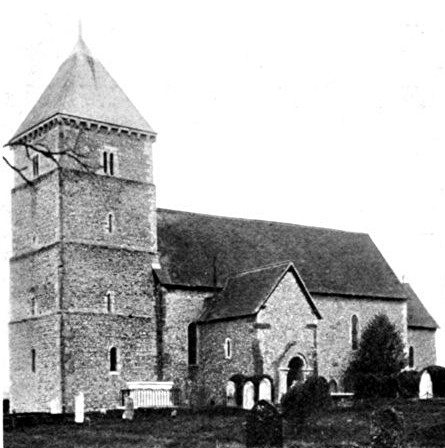
|
|
An Example of a Norman Tower. Bishopstone, Sussex. Homeland Copyright. Click to ENLARGE |
The semi-circular arch has long been considered to be one of the most distinctive marks of Norman architecture, but Mr. Rickman, who made an exhaustive study of the early churches of France and England, says:—
"In various churches it has happened that a very plain arch between nave and chancel has been left as the only Norman feature, while both nave and chancel have been rebuilt at different times; but each leaving the chancel arch standing. I am disposed to think that some of these plain chancel arches, will, on minute examination, turn out to be of Saxon origin."
It would be tedious to enter into any more minute account of the Anglo-Saxon ecclesiastical remains, and the reader whose enquiries conduct him to the more elaborate works on the subject will be startled by the contrary opinions that he will surely encounter.
In concluding these brief remarks on early buildings, we must again quote from Parker's work to which reference has already been made:—
"The class of buildings referred to as being considered to belong to this style contain some rather unusual features, and they require to be particularly described, both because they are in themselves remarkable, and because there is a probability that some of them may be Saxon."
Norman
Architecture.The Norman style of church architecture with its
varied forms of columns, moulded and recessed arches
and vaulting, may be roughly stated to
have been introduced into England at the
time of the Conquest. The Saxon masons
do not appear to have understood vaulting
sufficiently well to have roofed over any large space with[36]
stone, and for this reason alone the Saxon form of building
was bound to give way before the Norman, which of
all the earlier styles was the most advanced in this
respect.
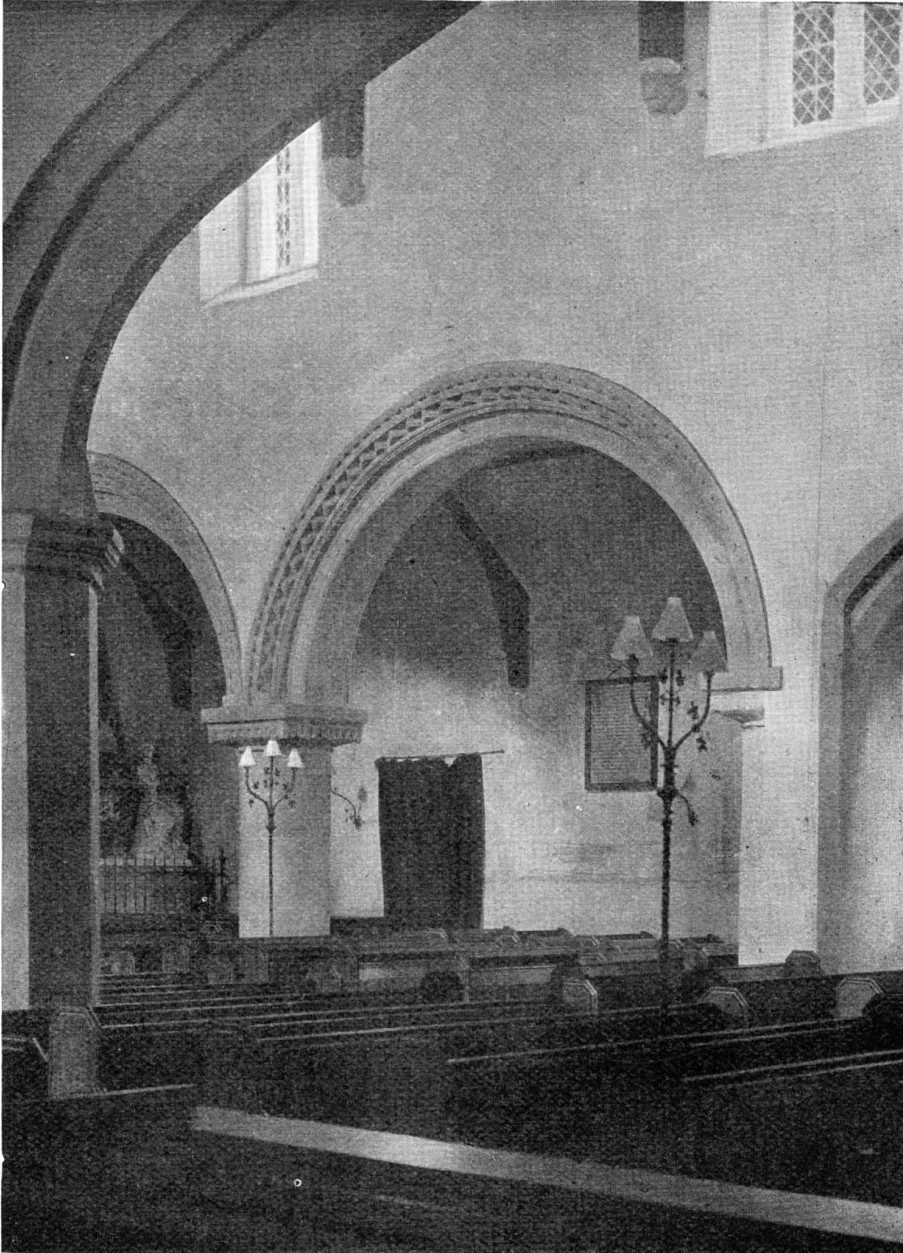
|
|
A Norman Pier Arcade. Abbots Langley, Herts. Photograph Mr. A. W. Anderson. Click to ENLARGE |
[37]Generally speaking, Norman arches were semi-circular, but they were by no means universally so, for a form frequently found is one in which the spring of the arch does not take place from the abacus, or upper member of the capital, but at some distance above it and when it assumes this form it is called a "stilted" arch, suggested by some authorities to have been unintentional and the result of imperfect construction or planning. See page 10.

|

|
|
| Chevron or Zig-zag. | Star. | |

|

|
|
| Alternate Billet. | Square Billet. | |

|

|
|
| Double Cone. | Lozenge. | |

|

|
|
| Beak Head. | Bird Head. | |
| Examples of Norman Mouldings. | ||
The main features in the ornamentation of this period are the sculptured bands worked round the arches, which, although generally called "mouldings," are more in the nature of decoration, and in some instances they appear to be additions carved on the originally unadorned surface of the masonry. The earliest and most general ornament is the chevron or zig-zag, which is frequently found doubled, trebled and quadrupled. The next most common form is the beak-head, consisting of a hollow and[38] large round.
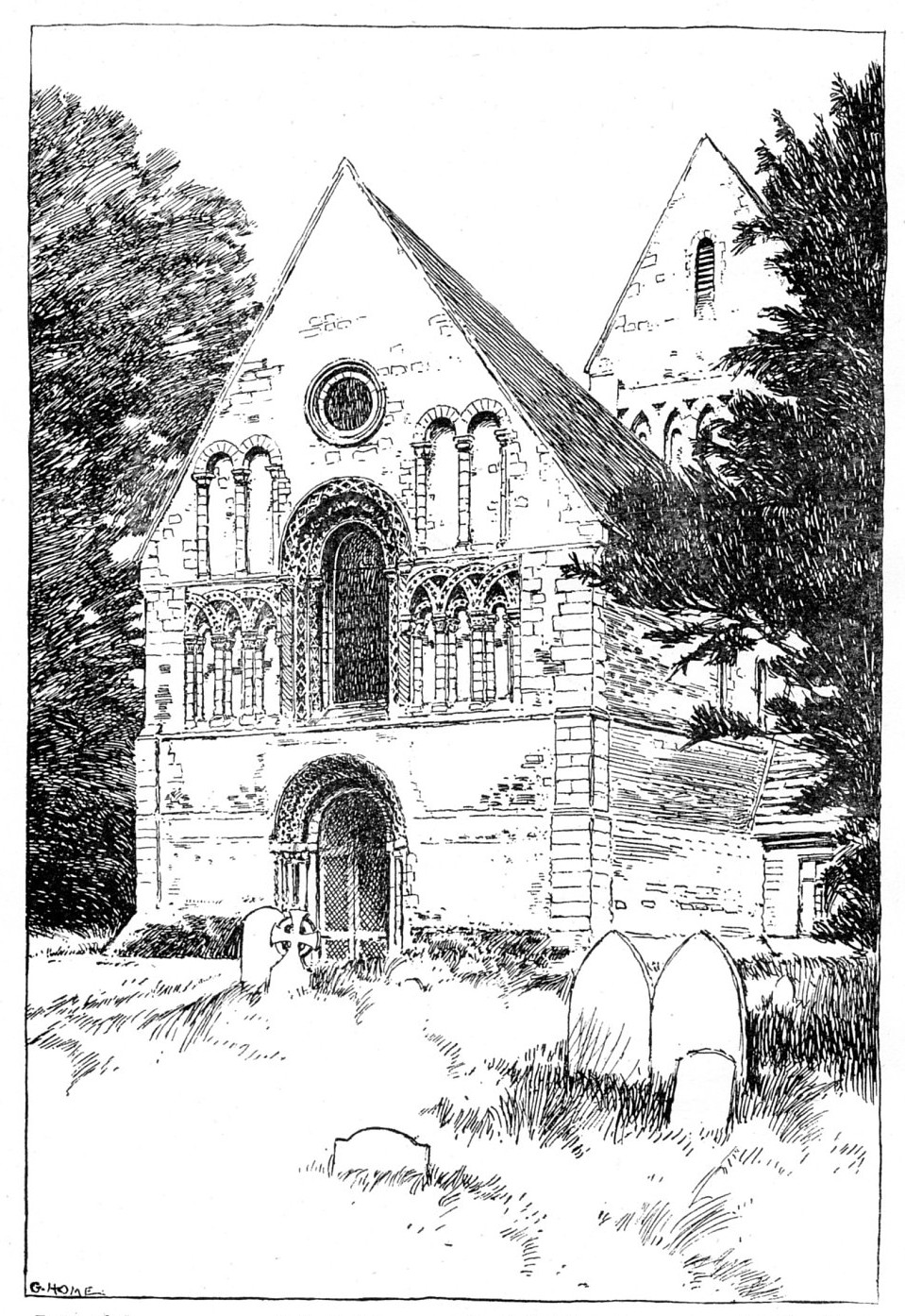
|
|
A Late Norman Parish Church. Castle Rising, Norfolk. Drawn by Gordon Home. Click to ENLARGE |
[39]In the hollow are placed heads of beasts or birds whose tongues or beaks encircle the round. On the west doorway of Iffley church, Oxford, are many of these beak-heads extending the whole length of the jamb down to the base moulding. They also figure prominently among the ornamentations of the hospital church of S. Cross, near Winchester. The zig-zag moulding is very common on Norman churches and is so easily recognised that no further description is needed here. The less prominent decorations of Norman mouldings include the alternate billet, the double cone, and the lozenge, together with an immense number of others less commonly found.
The Early Norman window was little better than a narrow slit finished with a plain semi-circular head, and was generally only a few inches wide. They were, it is believed, filled with oiled linen and the sides of the aperture were splayed towards the interior. Later in the period, the windows were enriched by the zig-zag and other mouldings and at a still later period an improvement was made by inserting nook-shafts in the jambs similar to those in doorways.
The towers of Norman churches often show windows of two lights separated by a central shaft, all enclosed under a large semi-circular arch, the spandrel of which is rarely pierced. Plain circular windows of small dimensions are sometimes found in other positions and in churches of later date, and occasionally in gable walls. Larger windows of the same form, with small shafts radiating from the centre and connected at the circumference by semi-circular or trefoiled arches, are also found as at Barfreston church, Kent, where there is a fine example.
Norman doorways are found in great numbers and variety, even in churches which present no other features in this style. The most usual form consists of a semi-circular-headed aperture with a hood-mould springing from plain square-edged jambs. Frequently, however, the doorways are[40] recessed, having a nook-shaft in the angle formed by a recession from the capital, in which case it presents two soffits and two faces, besides the hood-moulds. The depth of these doorways is largely due to the great thickness of the walls usual in buildings of this period, but in many cases that portion of the wall in which the entrance is inserted is made to project forward beyond the general face, which projection is finished either with plain horizontal capping, or a high-pitched gable.

|
|
West Doorway of Rochester Cathedral Duncan Moul Click to ENLARGE |
Norman porches thus have generally but little projection, and are frequently so flat as to be little more than outer mouldings to the inner door. They are, however, often richly ornamented and have rooms above, which rooms are wrongly called "parvises." The shallow aperture often follows the form of the arch, but is frequently square-headed, having a semi-circular tympanum of masonry filling the space between the[41]
lintel of the door and the intrados of the arch. These tympana are usually sculptured in low relief with a representation of some scriptural or traditional event, while the assertion of the Apostle that "we must, through much tribulation, enter into the kingdom of God," may account for the fondness of the Norman sculptors in representing different stages of martyrdom on the tympana of their doors. A very singular tympanum is that on the door of the church of Fordington S. George, at Dorchester, whereon is represented some incident in the life of S. George.
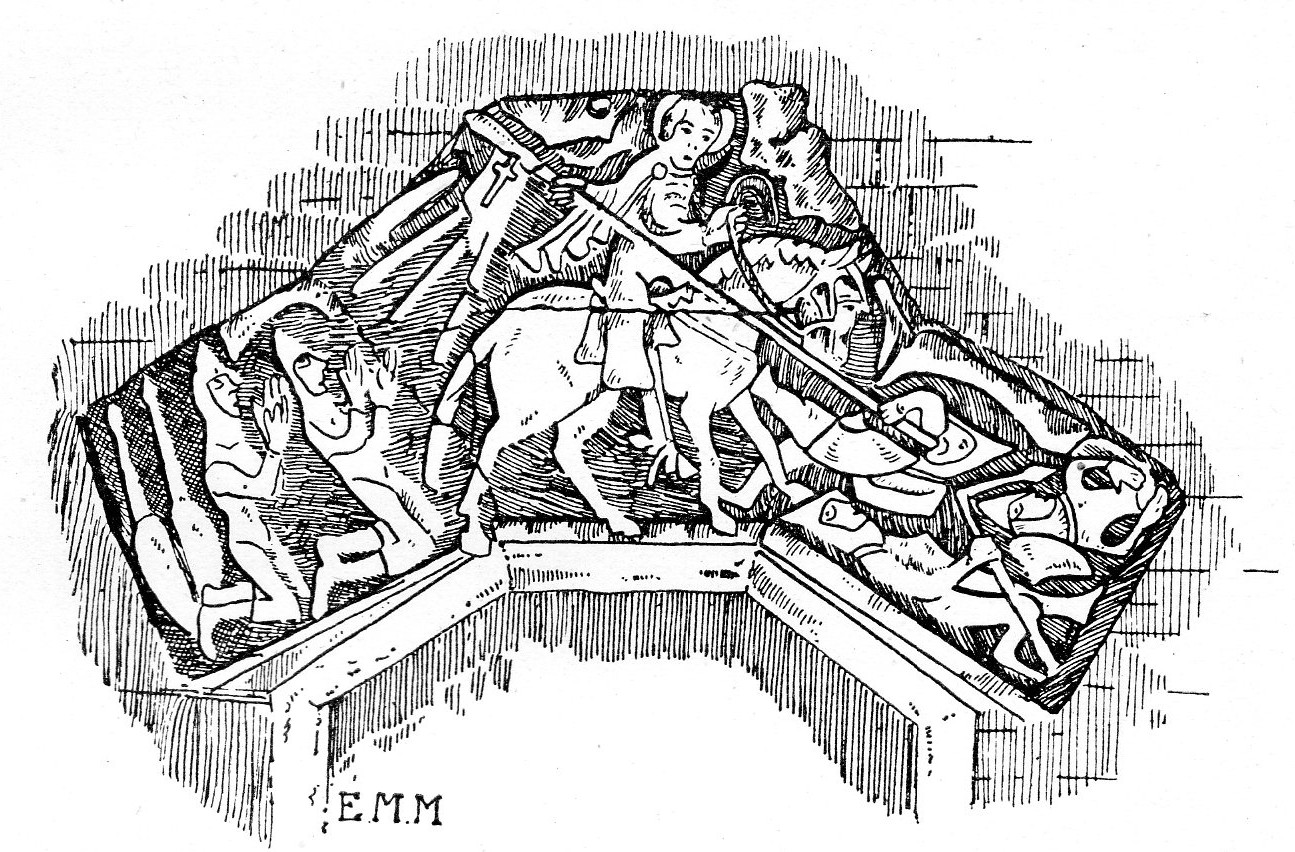
|
| Tympanum of Norman Doorway. Fordington S. George, Dorset. Drawn by E. M. Heath. Click to ENLARGE |
The principal figure is on horseback with a discus round his head. The other figures are in hauberks and chausses, and generally bear, in point of costume, much resemblance to the figures on the famous Bayeux tapestry. Barfreston church, Kent, has an interesting tympanum, as also has Patrixbourne church in the same county, where the sculpture shows the Saviour with dragons and at his feet a dog. At Alveston church, Warwickshire, the sculpture shows two quadrupeds with enormous tails, fighting, with between them a small bird, possibly intended for a dove. Our best example of a Norman doorway and tympanum is generally[42] considered to be the west doorway of Rochester Cathedral, where the sculpture is of a very advanced character for its date, which is probably about 1130-40.
A distinctive feature of the Norman style are the massive pillars, usually circular, and with capitals either of the same form, or square; occasionally in plain buildings the pillars themselves are square with very little or no ornamentation. Towards the end of the period, an octagonal pillar was often used, having a much lighter appearance than the earlier forms. Besides these plain styles, compound or clustered piers are very numerous, differing considerably in plan; the simplest consists of a square having one or more rectangular recesses at each corner, but one more frequently met with has a small circular shaft in each of the recesses and a larger semi-circular one on each side of the square.
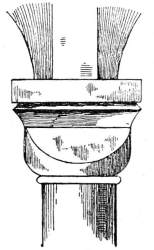
|
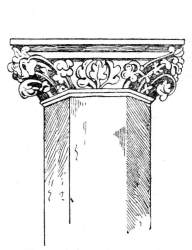
|
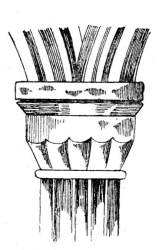
|
|
Norman. Crypt, Winchester. |
Traditional. Christ Church, Oxford. |
Norman. Winchester Cathedral. |
|
Examples of Capitals. |
||
Norman capitals are very varied, having many different forms of ornamentation; the commonest is one which resembles a bowl with the sides truncated, reducing the upper part to a square; sometimes the lower part is cut into round mouldings and ornamented, but it is frequently left plain.
The Norman capital in its earliest style was of short proportions, but[43] afterwards it became longer, with lighter ornamentation, gradually merging into the Early English. The bishops and abbots of this period appear to have possessed considerable skill in architecture, for no fewer than fifteen of our English cathedrals contain some important Norman work, as the older portions of the cathedrals of Canterbury, Durham, Winchester, Gloucester, Peterborough, Ely, Norwich, Lincoln and Oxford.
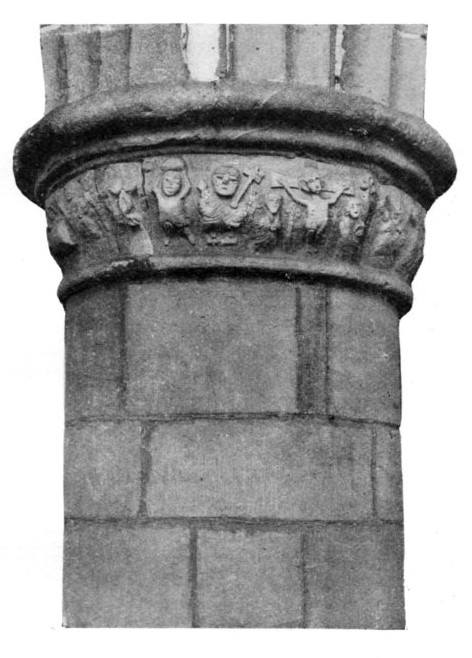
|
| A Curious Norman Capital. Seaford, Sussex. Click to ENLARGE |
The Norman buttress, better described by Mr. Sharpe as a pilaster strip, unlike those of the later period,[44] projects but very little from the wall, and this is especially so in buildings of the earlier part of the period. They are usually quite plain and are more used for finish than actual support; the Norman builder relying principally upon the thickness and weight of his walls to sustain any roof thrust (see page 17).
There are in England a few round churches which are thought to have been built by the Knights Templars, a religious community banded together for the purpose of wresting the Holy Sepulchre at Jerusalem from the Saracens. Their object was to defend the Saviour's tomb and to guard Palestine, for which purpose they built numerous monasteries throughout the Holy Land and fortified them like castles.
Another famous order which combined the religious instincts of the cloister with the military ardour of the warrior was that of the Knights of S. John Baptist or Knights Hospitallers, who, besides fighting, were to tend the sick and provide for the welfare of all Christian travellers. The churches belonging to the Templars were usually built in circular form in imitation of the church of the Holy Sepulchre at Jerusalem. They were capped with vaulted concave roofs said to be symbolical of the vast circuit and concave of the heavens. Our best example is the Temple Church, London, to which was added at a later period, a beautiful Early English Gothic extension. Other round churches are those of S. Sepulchre, Cambridge; S. Sepulchre, Northampton; Temple Balsall, Warwickshire, and of Little Maplestead, Essex, which last, although the smallest, is by no means the least interesting. It is attributed to the Hospitallers, an order founded about the year 1092, and introduced into England in the reign of Henry I. At Clerkenwell may still be seen the ancient gateway leading to their hospital.[45]

|
| Norman and Early English Doorways. Showing the transition from one style to another. Dunstable Priory Church. Drawn by Worthington G. Smith. Click to ENLARGE |
The order was suppressed in 1545. The church at Little Maplestead was built early in the 12th century, and in 1186 the adjoining manor was given [46]by Juliana Doisnel to this order, which gift was confirmed by King John and Henry III. This church is thought to reproduce with more fidelity than the others the original church of the Holy Sepulchre.
These famous Norman round-chancelled churches have much in common with the old basilica form.
It must be pointed out that the arbitrary divisions into which architecture has been divided—Norman, Gothic, etc., are pure figures of the imagination, as by a series of easy transitions, one style became gradually merged into the next without any hard and fast dividing lines whatever. The periods during which one style became gradually blended into another are called the periods of transition.
Architecture being progressive, it was only by the gradual development of one style from another that the art was enabled to advance with social progress, the literature and other arts of the country. The transition from the Norman to the Early English style may be ascribed to a period somewhat earlier than the 12th century, when a great change in the construction of the arch began to manifest itself. Alone, however, the form of the arch is no real test, for many pure Norman works have pointed arches. The square abacus may be taken as the best test. In its incipient state the pointed arch exhibited a change of form only, whilst the accessories and details remained the same as before; and although this change gradually led to the Early Pointed style in a pure state, with mouldings and features altogether distinct from those of the Norman, and to the general disuse, in the 13th century, of the semi-circular arch, it was for a while so intermixed as, from its first appearance to the close of the 12th century, to constitute that state of transition called the semi-Norman.
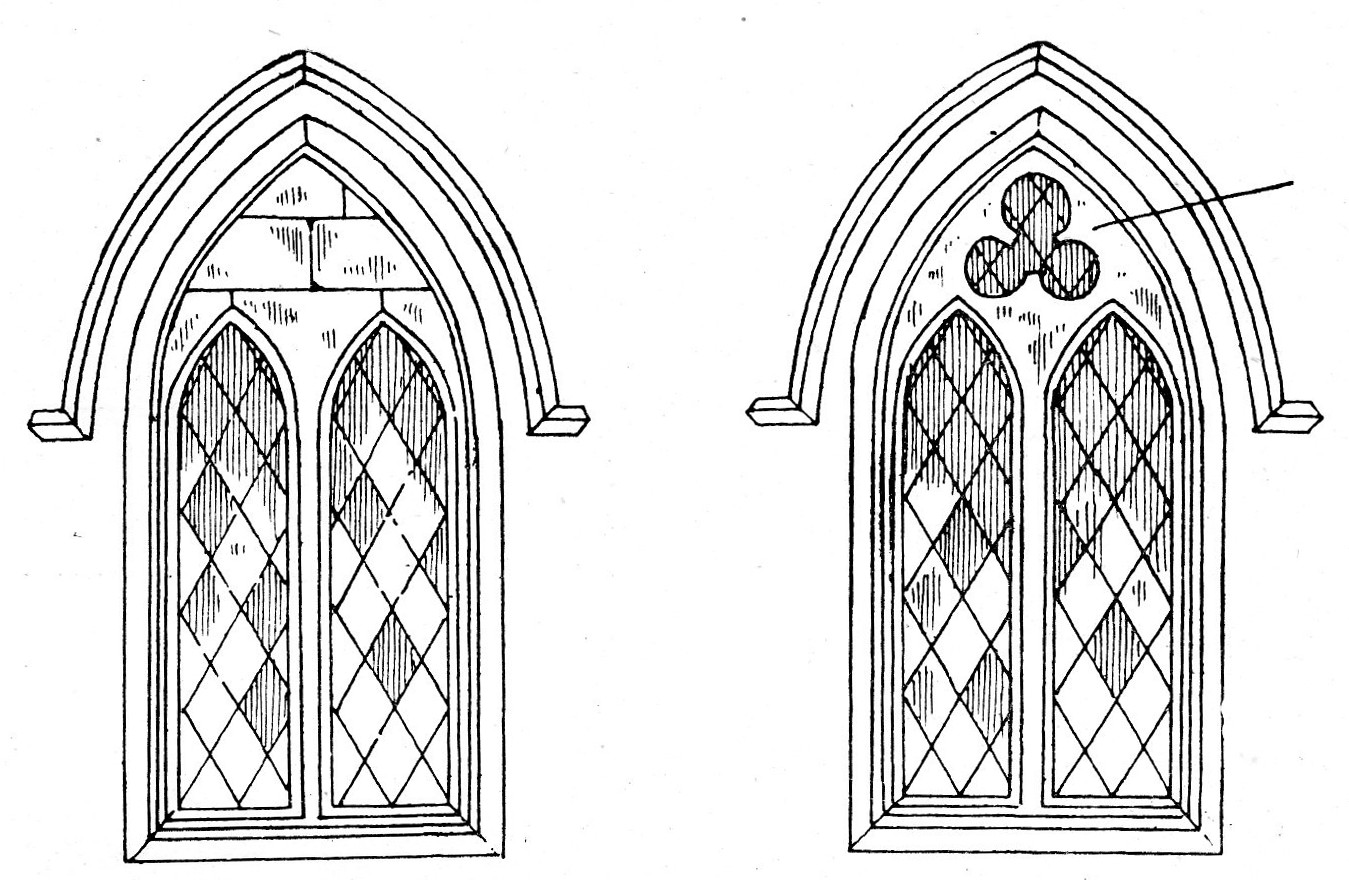
|
| Windows showing the Origin of Tracery. Click to ENLARGE |
The origin of what is loosely called Gothic architecture—which is generally considered to include the styles, with their transitions, from Early English to late Perpendicular, or Tudor-Gothic—is not free from obscurity, but it is certain that it began to be employed in ecclesiastical edifices about the time that the Goths settled in Italy, although all the available evidence goes to prove that the style originated and underwent its earliest developments in the north-west of Europe, and penetrated by slow degrees to the south and east.
England was somewhat later than France in introducing this style of architecture, our earliest purely Gothic building being Salisbury Cathedral, begun in 1220, although the choirs of Rievaulx and Fountains Abbey were commenced a few years earlier. The Early English style in its earliest developments is nowhere seen to better advantage than in Salisbury Cathedral, and in its[48] very latest forms at Westminster Abbey, the period of time being chronologically measured by the reigns of Richard I., John and Henry III.
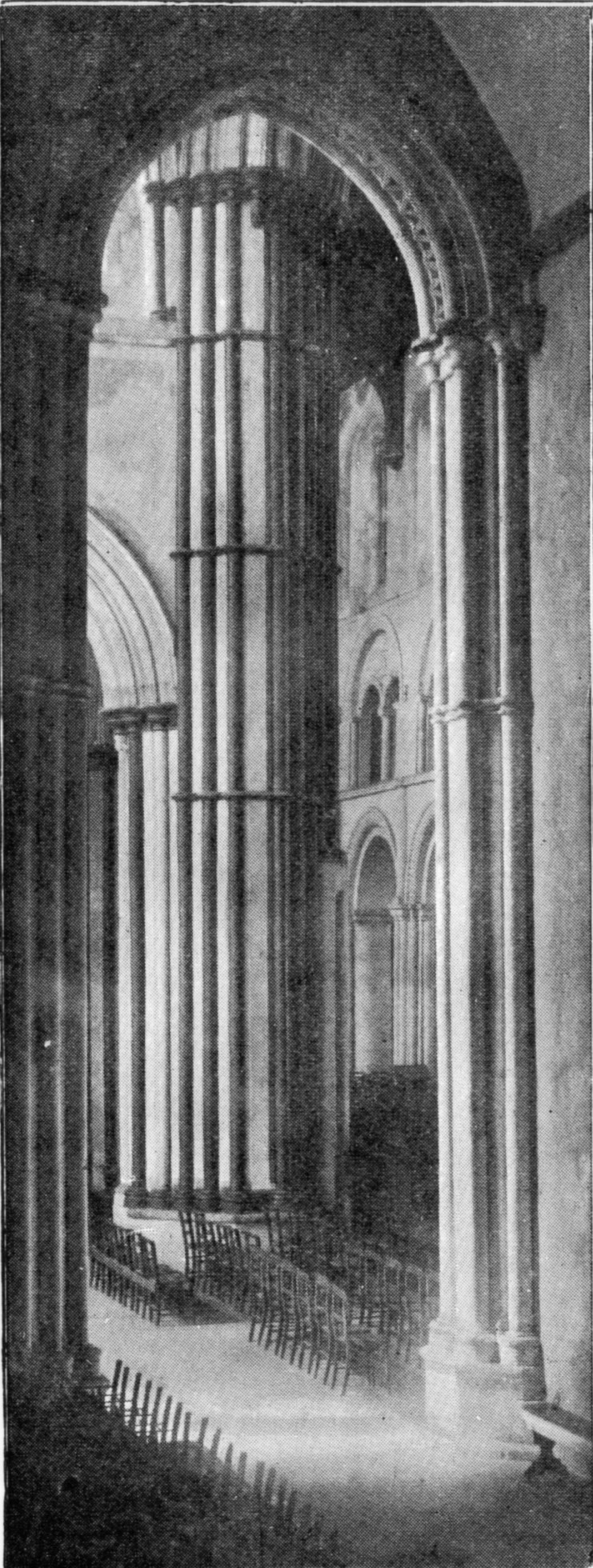 An Early English Arch.
An Early English Arch.Most of our Gothic buildings were carried out under the supervision of a master-mason, but the most subordinate workman was left plenty of scope within reasonable limits for whatever artistic individuality he possessed, and the enrichments and ornaments of the Gothic era point out the noble aim, the delicate and graceful thought, the refined and exquisite taste expended upon every portion of their buildings by these Gothic masons.
One of the chief differences between pure Gothic and[49] Norman architecture is in the use of the pointed form of arch, yet in the study of the early buildings of this date it is curious to notice how evenly the balance is held between the pointed and the round arch, and how at one time it was quite an open question whether the Gothic style would be distinguished by a round or a pointed arch. The Pointed Arch.In Germany and Italy the round arch held its own and continued to be used right through the Middle Ages. In England, however, the pointed arch soon gained a decided victory over its rival. Many theories have been put forward concerning the introduction of the pointed arch, one amongst them being that it was the result of the intersection of two circular arches such as is very commonly found in late Norman work; another theory is the poetical idea that it was copied from an avenue of trees. Whether or not either of these theories holds good, it is quite certain that this form of arch was known in the East for centuries before it reached Europe, being found in cisterns and tombs in Egypt and Arabia dating from long before the Christian era.
It has also been suggested that it was introduced from the East by the Crusaders, in which case we should have found it making its first appearance in Hungary, Poland, Bohemia and Russia, but it so happens that these were the very last countries in Europe to adopt the pointed arch.
The Transitional Period.The first form of the pointed arch, known as the Early English, was used from about 1180 to 1300, including part of the reigns of Henry II., Richard I., John, Henry III. and Edward I. "Nothing," says the Rev. J. M. Hutchinson, "could be more striking than the change from Norman to Early English. The two styles were the complete opposites of each other; the round arch was replaced by the pointed, often by the acute, lancet; the massive piers by graceful clustered shafts; the grotesque and rudely-sculptured capitals by foliage of the most exquisite[50] character; and the heavy cylindrical mouldings by bands of deeply undercut members."
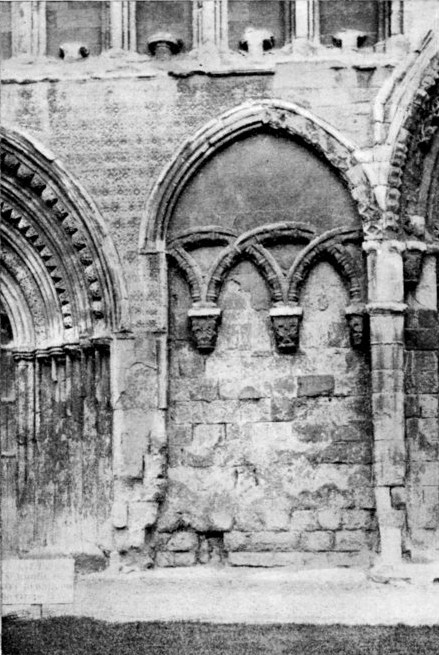 Arcading showing the junction of the Norman
Arcading showing the junction of the NormanGothic architecture differs from all previous forms in the economical use of material, and the small size of the stones used. Whereas in both Roman and Norman buildings the arrangement of the materials depended upon their strength in masses, the Gothic masons employed stones of small size in the construction of edifices of equal strength and of far greater magnificence; while in constructive properties the Gothic style was a great advance on anything that had gone before, as the buildings in this style did not depend for their stability on the vertical pressure of columns, but on the correct adjustment of the bearings and thrusts of different arches operating in various directions. Owing to the fact, then, that each portion of a Gothic Church helps to support something[51] besides itself, it is obvious that such buildings could be erected with a far smaller quantity of material than was previously necessary.
The various little shafts or columns are so disposed as to distribute the weight of the superstructure and thus relieve the greater columns or piers of some portion of the superincumbent weight; the aisles help to support the nave; the walls of the side chapels act as abutments against the walls of the aisles, while the towers are generally placed so as to resist the accumulated thrust of all the arches along the sides of the nave.
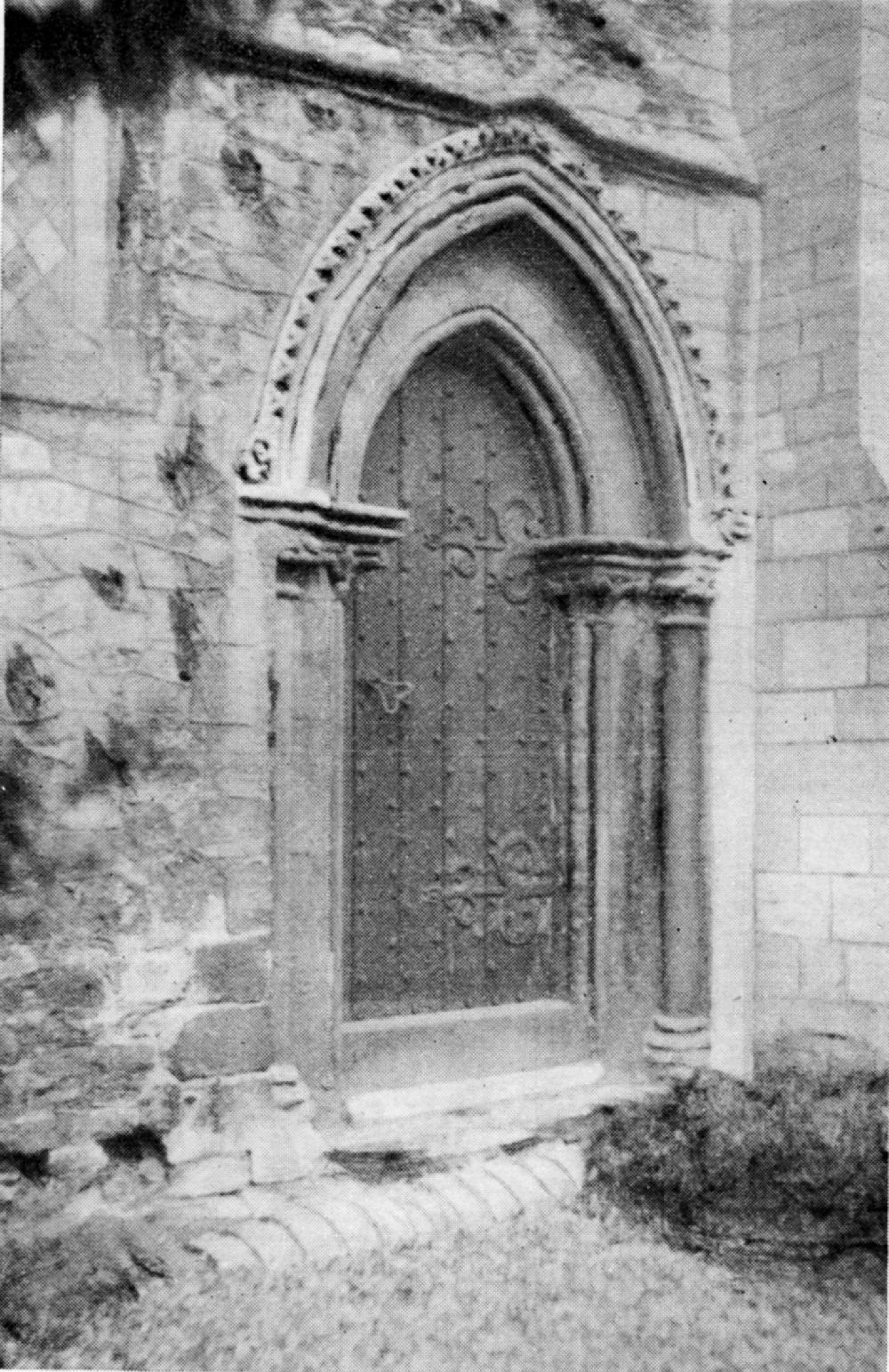 An Early English Doorway.
An Early English Doorway.The enrichments and little ornaments attached to mouldings, and particularly those placed in the hollows, are most characteristic of the various styles of Gothic architecture. The zig-zag is[52] peculiar to the Norman, the nail head to the Transitional or semi-Norman, and the dog tooth to the Early English.
This last ornament represents a flower, looking like four sweet almonds arranged pyramidically, and there is no other ornament so distinctive of this period. Early English foliage is known by reason of the stalks always being shown as growing upwards from the lower ring of the capital, called the astrigal. These stalks are generally grouped together and curve forward in a very graceful manner. The plants mostly represented are the wild parsley, seakale and celery, and this foliage, called stiff-leaved foliage, is found at no other period than the end of the 12th century.
Early English mouldings are very complicated and yet very beautiful, and consist of beads, keel and scroll patterns, separated by deep hollows giving a rich effect of light and shade round the arch. These deeply-cut hollows are also a distinctive mark of the style.
The earliest windows of this period are long and narrow, with acutely pointed heads, the exterior angle being merely chamfered and the interior widely splayed. Somewhat later the introduction of tracery gave a highly beautiful appearance to the windows and from the character of this feature the date of the window can be fairly accurately determined. Where the tracery is formed by ornamental apertures pierced through a plate of stone, it is called plate tracery, and is certain to be of not later date than the earlier part of the 13th century. If it is bar tracery, with the bars forming plain circles, the work is also Early English, but if, on the other hand, the bars form other shapes filled in with patterns, or consisting of a single trefoil or quatrefoil, they are of later date.
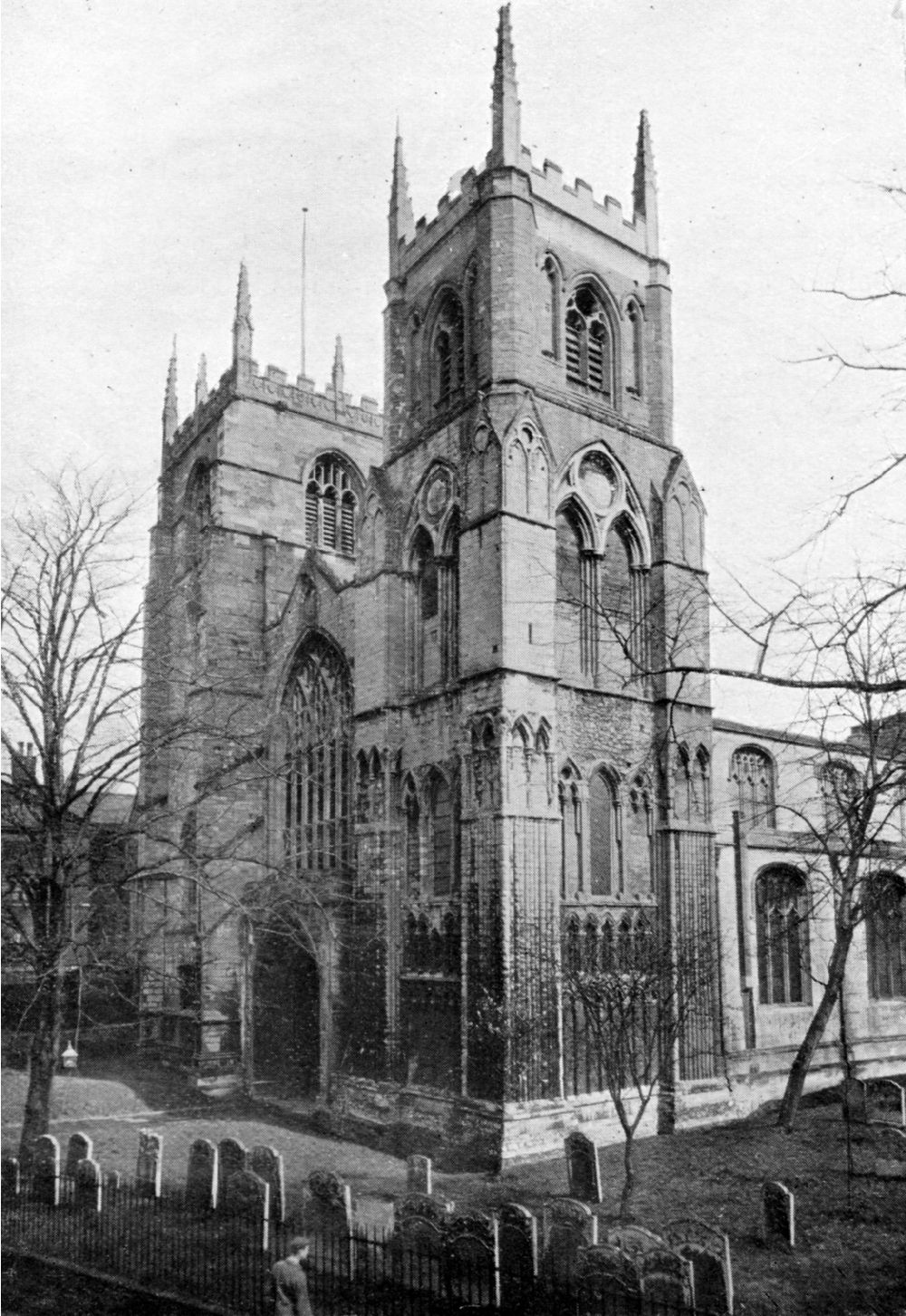
|
| The Church of St. Margaret, Lynn. West Front showing the Early English work in the base of the Tower. Photograph Dexter & Son Click to ENLARGE |
The traceried window originated from the placing of a two-light narrow lancet window under one dripstone having a plain head, the introduction of tracery[53] between the heads of the lancets and the dripstone becoming necessary for beauty and lightness of the form (see page 47.
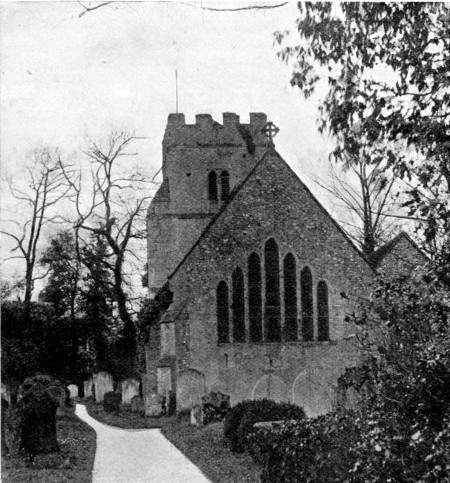
|
| Example of Group of Thirteenth Century Lancet Windows. Ockham, Surrey. Homeland Copyright. Click to ENLARGE |
Early English porches project much further from the main walls than do the Norman doorways, and in large and important buildings they frequently have a room above. The gables are usually bold and high pitched, and the interiors quite as rich in design[54] as are the exteriors.
The doorways of this period are usually pointed, though occasionally they have a semi-circular head. The mouldings are boldly cut and often enriched with dog tooth ornament. The jambs frequently contain a shaft or shafts with plain or foliated capitals (see page 51).
Early English capitals are usually bell-shaped, and are, in the smaller examples, quite devoid of ornament, with the exception of a necking and one or two mouldings round the abacus. The bell is generally deeply undercut, which, as in the mouldings, is a strong characteristic of the style. The nail head and dog tooth ornaments sometimes appear in the hollows between the mouldings. In the large examples the bell is covered with foliage, which, springing direct from the necking, curls over most gracefully beneath the abacus. In clustered piers the capitals follow the form of the pier, and they also adopt the same form in the single shaft, with the exception that multiangular shafts have often circular capitals. The base consists of a series of mouldings and frequently stands upon a double or single plinth, which in the earlier examples is square, but in later examples assumes the form of the base, and is either circular or polygonal. At Stone church, Kent, is a good example of an Early English capital, decorated with stiff-leaved foliage, and the dog tooth ornament, which in this case is seen between the mouldings of the arch, and is of a perforated character.
The buttresses (see page 17) of this period are, as a rule, simple in form, and in small churches consist of two or more stages, each set-off or division being sloped at the top to carry off the rain. In larger buildings the buttress generally finishes with a triangular head or gable, and is frequently carried above the parapet, except where stone vaulting is used, in which case it is covered with a pinnacle either plain or ornamented. [55]
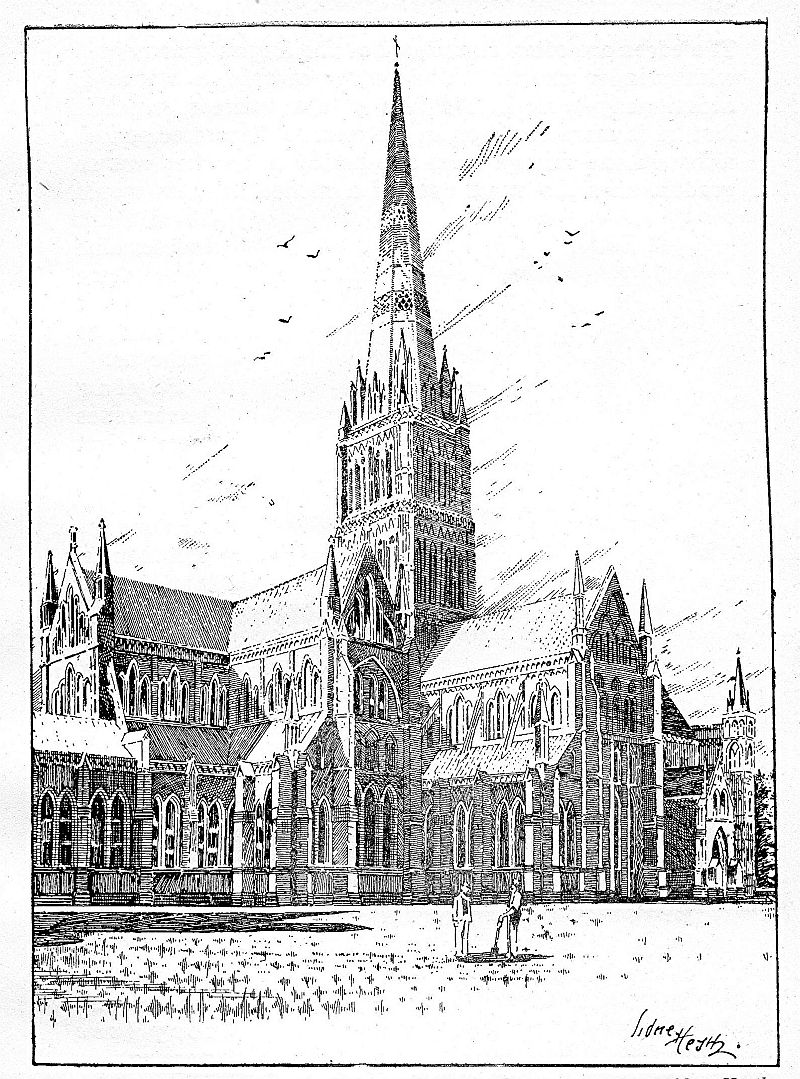
|
| Salisbury Cathedral. Begun in 1220. The spire was added, 1350. Drawn by Sidney Heath. Click to ENLARGE |
[56]The edges are often chamfered or the angles ornamented with slender shafts. A niche to contain a statue is occasionally sunk in the face of the buttress, but this feature is more common in the next or Decorated period, although the change from one period to another was so gradual that the exact date of a niched buttress would be difficult to determine were there no other features to guide us.
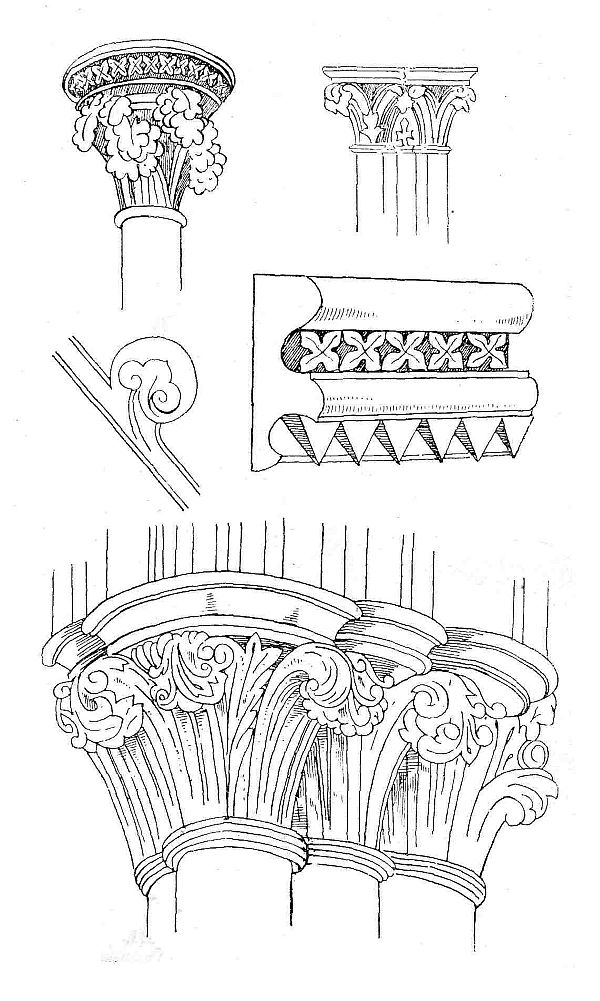
|
| Examples of Early English Capitals and Ornament Click to ENLARGE |
Flying buttresses were first introduced at this period, and are common in all large buildings with vaulted roofs. They are generally of simple design, with a plain capping and archivolt, and they spring from the wall buttress to the clerestory (see page 17).
The best examples of Gothic architecture may be said to have been erected between the years 1180 and 1300, and from the latter year many writers date the commencement of its decline. In England we owe nearly the whole of such magnificent buildings as the cathedrals of Lincoln, Salisbury, Worcester, and the abbey of Westminster to the 13th century, and there is scarcely a cathedral or abbey that does not owe some beautiful portion of its structure to the builders of the same period, the transepts and lady chapel of Hereford Cathedral, the eastern transepts of Durham, the nave and transepts of Wells, the transepts of York, the choir presbytery, central and eastern transepts of Rochester, the eastern portion of the choir of Ely, the west front of Peterborough, the choir of Southwell, the nave and transepts of Lichfield, and the choir of S. David's being a few of our most characteristic examples of this period. The style which followed the Early English is known as the Geometric or Early Decorated style, and it embraces roughly the end of the 13th century and the first twenty or thirty years of the 14th century, and continued in its later or Curvilinear form to near the end of that century. Perhaps the most perfect example of the Geometric style in the world is the cathedral church at Amiens, which is usually called the mother church of this style, and although she has many daughters, none of them can be said to equal their parent in beauty.[58]
In England the most perfect examples are not to be looked for in cathedrals and large churches, but in their chapels, and the most superb specimen we possessed, S. Stephen's Chapel, Westminster, has been destroyed within comparatively recent years. Those left to us include the chapel of the palace of the bishops of Ely, in Ely Place, Holborn, now the Roman Catholic Church of S. Etheldreda, a building almost identical in plan with the vanished chapel of S. Stephen. Trinity Church, Ely, once Our Lady's Chapel, and Prior Crawden's Chapel, in the same city, are lovely examples of the latest development of the Curvilinear style, while the former is considered the most highly-wrought building in England. Belonging to this period, also, is the choir of Merton College Chapel, Oxford, and Luton Church.
The Decorated style may be divided as regards its windows into two classes—Geometric and Curvilinear. The first has tracery evolved entirely from the circle. The Curvilinear style is distinguished by traceries formed by curved and flowing lines. See pages 15 and 59.
Decorated windows are usually large and contain from two to seven lights, although one sometimes finds a window with a single light, but of less elongated form than those of the Early English period.
As we have seen in a previous chapter, tracery originated from the necessity of piercing that portion of the wall which was left vacant when two lights were gathered under a single arched dripstone, and therefore elementary tracery consisted merely of apertures in a flat surface. As the possibilities of this ornamental feature became better understood, the mullions were recessed from the face of the wall and the fine effect thus produced was, as the art progressed, much enhanced by the introduction of various orders of mullions, and by recessing certain portions of the tracery from the face of the mullions and their corresponding bars. The geometrical tracery, as we have seen, consists of various combinations of the circle, as the trefoil, based on the[59] triangle, the quatrefoil on the square, the cinquefoil on the pentagon, etc.
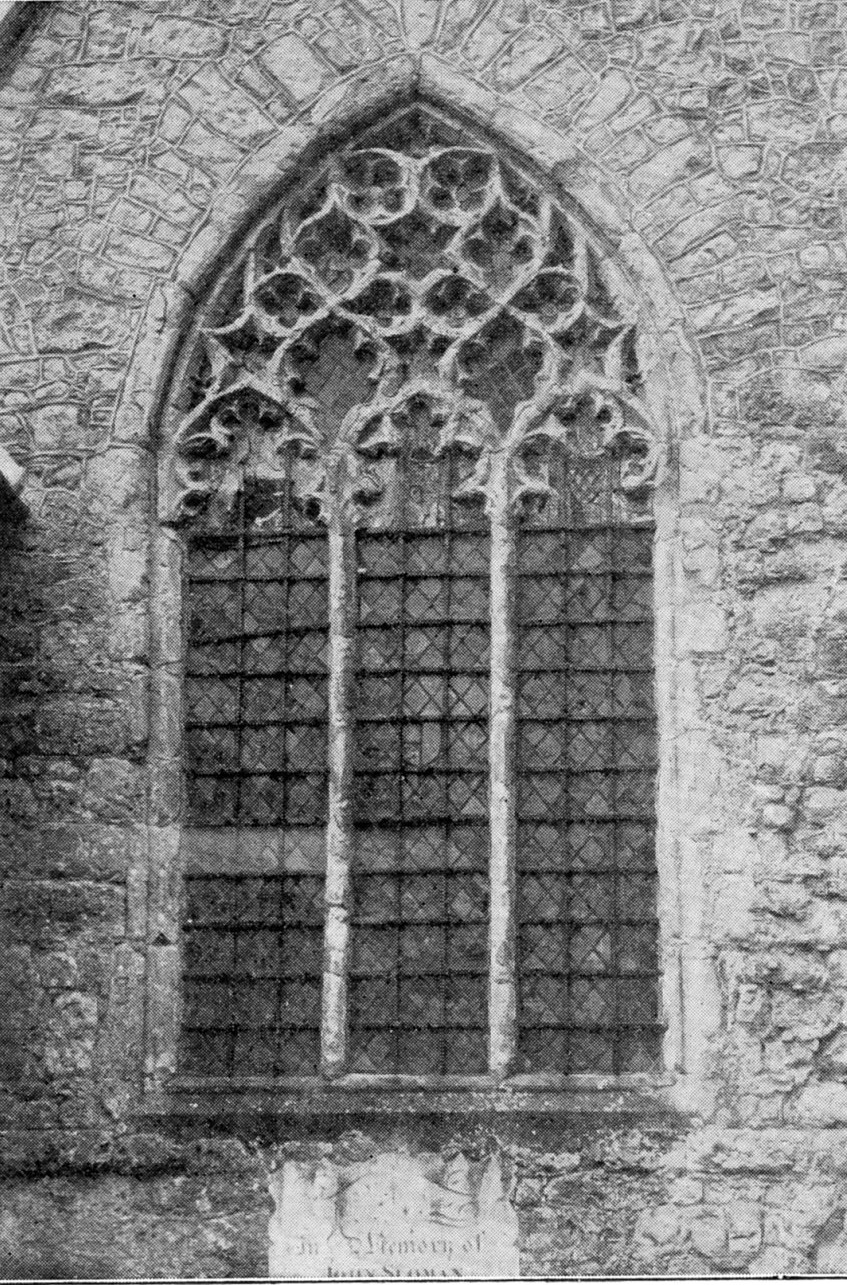
|
| A Late Decorated Window in a Parish Church. East Sutton, Kent. Photograph Gardner Waterman Click to ENLARGE |
[60]In Curvilinear windows the tracery, although based on the same forms and figures, is yet so blended into an intricate pattern that each figure does not stand out with the same individuality as in the Geometric. Among our most beautiful Geometric windows are those of the Lady Chapel at Exeter, Ely Chapel, and Merton Chapel, Oxford, and of the Curvilinear our best example is probably the east window of Carlisle Cathedral.
It must be noted that beautiful as are Curvilinear windows, yet they mark a certain decadence in Gothic architecture, in that it is an irrational treatment of stone, and conveys the idea that the material was bent and not cut into the required shape, it being a well-established canon in art that when strength is sacrificed to mere elegance it marks a decline in that art.
Decorated capitals as a rule follow the contour of the pier in clustered columns, and are either bell-shaped or octagonal. They are frequently only moulded, thus presenting rounds, ogees and hollows, on which the prevailing ornaments of the period, the ball and the square flower, are set. The foliated sculpture is most exquisite, and is gracefully wreathed around the bell, instead of rising from the astrigal or upper member of the capital, as in the earlier style. Almost every variety of leaf and flower is represented, the oak, the vine and the rose being perhaps the most common, but the leaves of the maple, hazel, ivy and strawberry are all so beautifully rendered as to evidence their having been directly studied from nature. Plucked flowers too, are not uncommon, and sometimes the little stalks and foliage are accompanied by birds, lizards, squirrels and other creatures. The columns of this period are much more elaborate than those of the Early English style, and in plan have curved profiles with moulded members between the shafts. These mouldings are very varied, but the hollows not being so deeply undercut, the general effect is broader and less liney than in the Early English; while the Decorated arches are less sharply pointed than in the previous style. [61]
[62]The doorways of this style possess much the same features as the last, but the mouldings, jamb shafts, etc., are more slender, and generally of finer proportions, the hollows being often filled with the ball flower and square flower instead of the dog tooth. Sometimes the doorways have no pillars, being entirely composed of mouldings which are continuous with those in the architrave. The large single doorways of this period are nearly as large as the double ones of Early English date, and on the sides small buttresses or niches are sometimes placed, and often one finds a series of niches carried up like a hollow moulding, and filled with figures. The figures of this period are not so good as in the previous style, the heads seem too large for the bodies, and in the female figures the breasts are represented as quite flat. Where there are no figures double foliated tracery is often found hanging from one of the outer mouldings, giving an effect of great richness.
The buttresses (see page 17) in the Decorated style are nearly always worked in stages, and a niche frequently figures on the face of the buttress. Crocketed canopies and other carved decorations are common, and in large buildings they usually terminate in pinnacles, which are sometimes of open work.
A Gothic building attains its effect by the combination of numerous parts, each possessing an individual character of its own. In its loftiness, graceful outlines, and rich effect of light and shade, it speaks of noble aspirations, of freedom, of intellectual thought, of talent and skill, all generously given for a high purpose, the foundation of which was a strong religious enthusiasm, combined with an intense love of the work itself.
Having now arrived at the point where Gothic architecture reached its climax, we may briefly sum up its leading[63] characteristics. It is essentially pointed or vertical; its details are mostly geometrical in its window traceries, clusters of shafts and bases, but this geometric quality is only one of construction and form and not of its inner spirit and motive, for plants copied directly from nature were used in beautiful profusion.
If we compare a large Gothic church with a comparatively small one, we shall find the columns, windows, ornaments of the former are not so very much larger than those of the latter, but that there are double or three times the number of them. This is not the case in a classical building, where each feature has to be enlarged in proportion to the size of the building. It is the constant sub-division of a Gothic Church which adds so to its apparent size.
Ornamentally, the Gothic is the geometrical and pointed elements repeated to their utmost and afterwards combined with the elaboration of natural objects, plants, flowers, etc., growing in the neighbourhood of the work. This is a great feature, but the most striking point in all good Gothic work is the wonderful elaboration of geometric tracery, vesicas, trefoils, quatrefoils and an immense variety of other ornament.
In regard to the sizes of our great churches it may be of interest to note that our longest English cathedral is Winchester. York and Lincoln, although not so long as Winchester, are in superficial area very much larger. The largest English church of a non-cathedral rank is Westminster Abbey, which has, moreover, the distinction of being the loftiest internally; the nave being 104 ft. in height. The largest parish church is that of S. Nicholas, Great Yarmouth, which exceeds in superficial area no fewer than eight of our cathedrals. [64]
Towards the close of the XIVth century a great change came over English Gothic architecture, a change which was to a certain extent a return to classical ideas. The curvilinear tracery gave place to a rigid vertical and horizontal form, with the result that windows and panels instead of being filled with curved bars of stone, were sub-divided by straight perpendicular bars and transoms or cross-bars.
This style of architecture is popularly known as Perpendicular, but as the horizontal lines are quite as distinct a feature as are the vertical, it would perhaps be more correct to speak of it as Rectilinear. This change in architectural form made its appearance towards the close of the XIVth century, although it was by no means generally introduced at that period, for the old methods and styles were carried on side by side with the[65] new for many years.
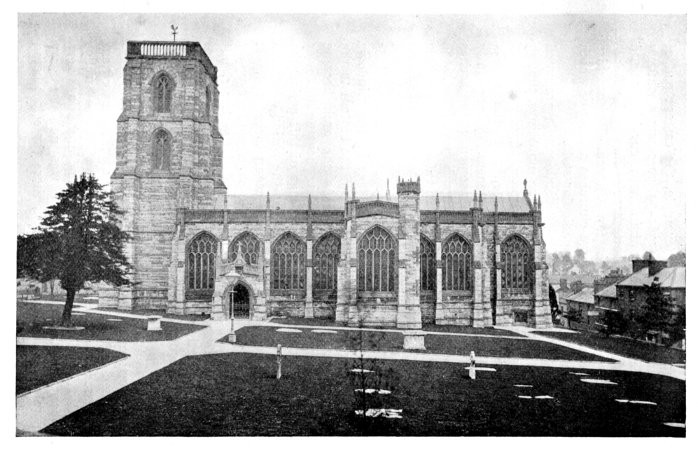
|
| Yeovil Parish Church (A.D. 1376). Early Perpendicular in style, without a clerestory, and called, for its large window area, the "Lantern of the West." Click to ENLARGE |
[66]For example, the eastern end of the choir of York Minster (1361-99) possesses a window the traceries of which contain both curvilinear and rectilinear lines, while Shottesbrook Church in Berkshire (1387), and Wimmington Church, Bedfordshire (1391) are examples of village churches neither of which has any feature of the Perpendicular style.
In its earlier stages the Perpendicular style presented an effect at once good and bold; the mouldings, though not equal to the best of the Decorated style, were well defined, the enrichments effective, and the details delicate without extravagant minuteness. Subsequently the style underwent a gradual debasement; the arches became depressed; the mouldings impoverished, the details crowded and coarsely executed, and the whole style became wanting in the chaste and elegant effects for which the Decorated stands unapproached and unapproachable. The flowing contours and curved lines of the previous style now gave place in the windows to mullions running straight up from the bottom to the top, and crossed by transoms. As the arch became more and more depressed the mouldings became shallower and less effective. In early buildings of this period the drop arch is very prevalent, but as the period advanced a form known as the Tudor arch began to be used. It is an arch in which, as a rule, the centres of the upper portion lie immediately below those of the lower, but this is not always the case. Sometimes the whole of the upper portion uniting the arcs of the ends is struck from one centre, in which case the arch becomes a three-centred one, being, in fact, half an ellipse. Towards the close of the style the curvature of the upper portion is so slight that it can hardly be distinguished from a straight line, and as the debasement progressed it became really straight. Ogee arches are also found at this period, and foiled arches are very frequent. When the Tudor arch was not used, we generally find the low drop arch, these three last being mostly used for small openings.[67]
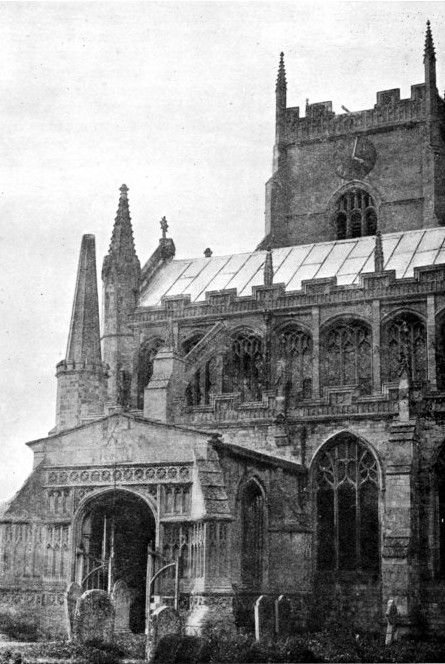
|
| A Fine Parish Church showing Rich Perpendicular Work. Terrington St. Clement, Norfolk. Photograph Dexter & Son. Click to ENLARGE |
[68]The peculiar characteristics of the windows—the perpendicular mullions and horizontal transoms—we have already alluded to. The window heads, instead of being filled with flowing tracery, have slender mullions running from the heads of the lights between each mullion, and these again have smaller transoms, until the whole surface of the window becomes divided into a series of panels, the heads of which being arched, are trefoiled or cinquefoiled. In the later windows the transoms at the top are often furnished with a small ornamental battlement, causing the mullions to present a concave outline.
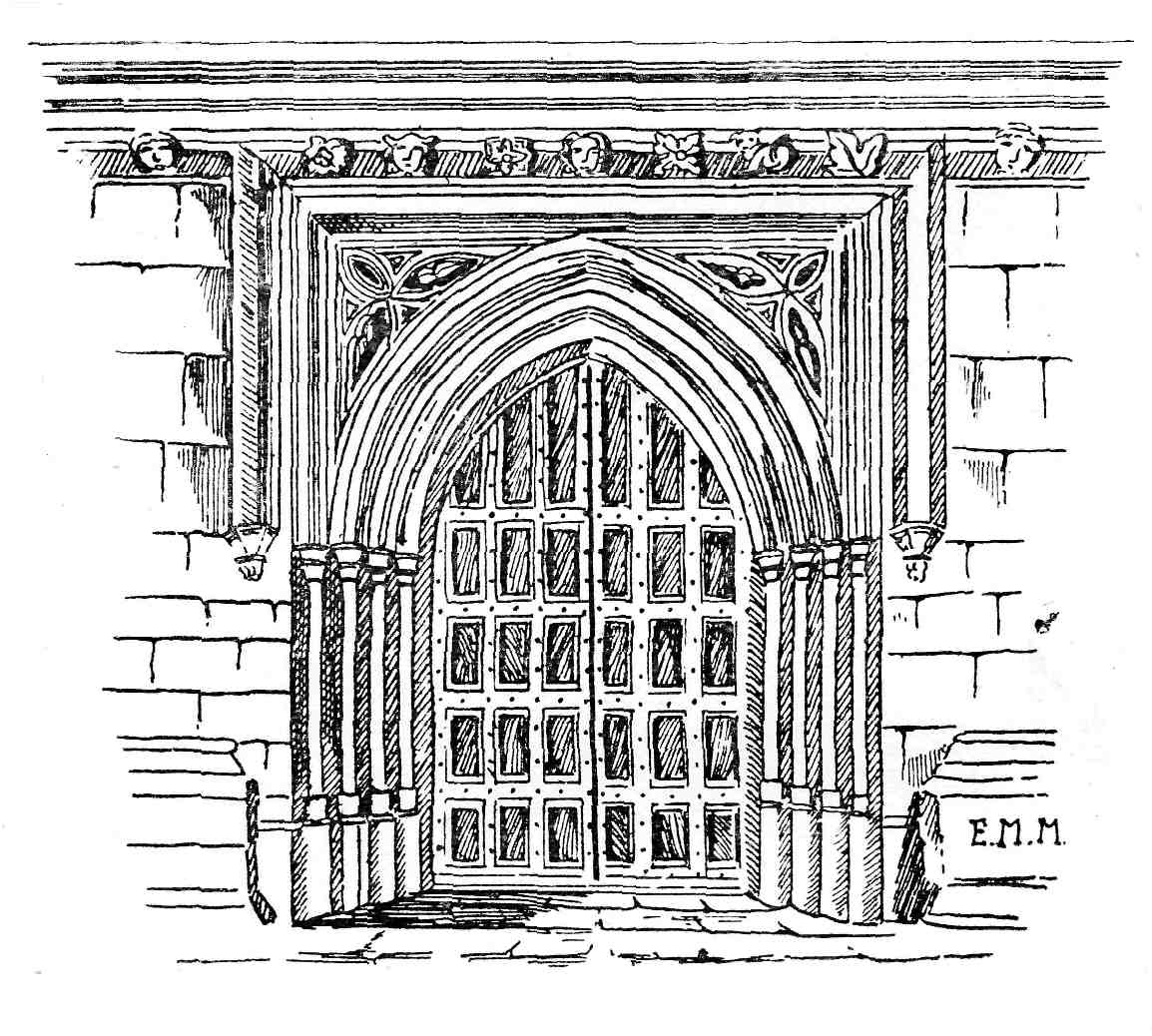
|
| A Perpendicular Doorway. Merton College Chapel. Drawn by E. M. Heath. Click to ENLARGE |
The plans of churches in this style differ from all others in that they are more spacious, the columns more slender and wider apart, the windows much larger, and the walls loftier and thinner. Panelling is used most abundantly on walls, both internally and externally, and also on vaulting, while some buildings, as Henry the Seventh's Chapel at Westminster, are almost entirely covered with it. Fan tracery vaulting, a feature peculiar[69] to this style, is almost invariably covered with panelling.
The mouldings of this period are essentially different from those which preceded them. As a general rule they are cut on a slanting or chamfer plane, the groups of mouldings being separated by a shallow oval-shaped hollow, entirely different from those of the Decorated period.
The doorways of the early portion of this period had two-centred arches, but the characteristic form is the four-centred, enclosed in a square head, formed by the outer mouldings with a hood mould of the same shape, the spandrels being filled with quatrefoils, roses, shields, etc.
Perpendicular capitals are either circular or octagonal, but the necking is usually of the former shape, and the upper members of the abacus of the latter form. The bell portion is mostly plain, but is often enriched with foliage of a very conventional character, shallow and formal, without either the freedom or the boldness of the Early English, or the exquisite grace of the Decorated periods. A distinguishing feature in the ornamentation of this period is that called panel-tracery, with which the walls and vaulted ceilings are covered. Fan Vaulting.The patterns are found in a variety of forms, as circles, squares, quatrefoils, etc. The rich vaulting called fan vaulting previously alluded to, is composed of pendant curved semi-cones, covered with foliated panel-work, which bears some resemblance to a fan spread open.
Another very characteristic ornament is the Tudor flower. It is formed by a series of flat leaves placed upright against the stalk. It was much used in late buildings as a crest or ornamental finishing to cornices, etc., to which it gave an embattled appearance. Cornices and brackets were frequently ornamented with busts of winged angels called angel-brackets, and angel-corbels. The portcullis and the Tudor rose—both badges of the[70] house of Tudor—also figure prominently among the ornaments of the period. The crockets for the most part partake of the squareness which pervades all the foliage of this style. See page 64.
The buttresses are very similar to those preceding them in their plainer forms, but, in richer examples the faces are covered with panel work and are finished with square pinnacles sometimes set diagonally and terminated with a crocketed spire, or finished with an animal or other ornament. Parapets with square battlements are very common at this period, but they too are frequently panelled or pierced with tracery, or with trefoils or quatrefoils inserted in square, circular or triangular compartments.
The roofs of this period, both in ecclesiastical and secular buildings, are very magnificent, and have the whole of the framing exposed to view; many of them are of high pitch, the spaces between the timbers being filled with tracery, and the beams arched, moulded and ornamented in various ways; and frequently pendants, figures of angels, and other carvings are introduced. The flatter roofs are sometimes lined with boards and divided into panels by ribs, or have the timbers open, and all enriched with mouldings and carvings, as at Cirencester church, Gloucestershire.
The gradual decline of the Gothic style is very evident in late Perpendicular churches, especially in those erected at the beginning of the XVIth century. The elements of Gothic architecture became much degraded and led to that mixture of features called the Debased Gothic in which every real principle of art and of beauty was lost.
The chief characteristics, then, of the Perpendicular style are the vertical mullions, and the general flattening of arches, mouldings and carvings. Should there be no other guide, a Perpendicular church carries its style and period stamped upon its carvings.[71]
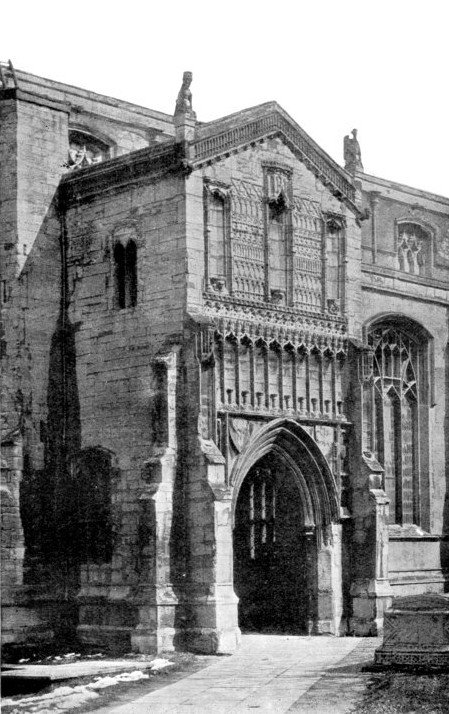
|
| A Perpendicular Porch. S. Nicholas, King's Lynn. Photograph Dexter & Son. Click to ENLARGE |
The plants represented are, almost without exception, the vine [72]with or without grapes, and the oak with or without acorns. The leaves are generally full blown and crumpled. The earliest building showing the Perpendicular style is the beautiful little priory church of Edington, in Wilts, erected by William Edington, Bishop of Winchester. The same style, but more fully developed, is seen in the nave of Winchester Cathedral, at New College, Oxford, and at Winchester College.
It is generally admitted that the Perpendicular style was, to a certain extent, a return to classical ideas, for Gothic architecture in its aspiring grace and feeling for motion was becoming a little unsteady in construction, and although the movement was started by Bishop Edington, it was left to William of Wykeham to save our English Gothic architecture from developing into the flamboyant1 style so characteristic of the late Gothic buildings of France and Germany.
It is little less than astounding that William of Wykeham, at once Prime Minister, diplomatist, scholar and energetic churchman, should have found time to introduce such far-reaching reforms into the art of building, and whatever his fame may be in other directions he will always be remembered by posterity as one of the most remarkable geniuses of the Middle Ages, a man of giant mind and immense physical energy, who carried into all his work a large and dignified character, stamping it with the unmistakable personality of a master mind.
As builders and designers of church towers the masons of the Perpendicular era have never been approached, and all our finest English towers are of this style and period. Considerations of space will only allow a few of these towers to be mentioned, but among the finest are those at Boston, Lincolnshire; Wrexham, Denbighshire; Wymondham, Heigham and S. [73]Clement's in Norfolk; Southwold Church in Suffolk; Manchester Cathedral, S. Nicholas' Church, Newcastle, and S. Mary's Church, Taunton.
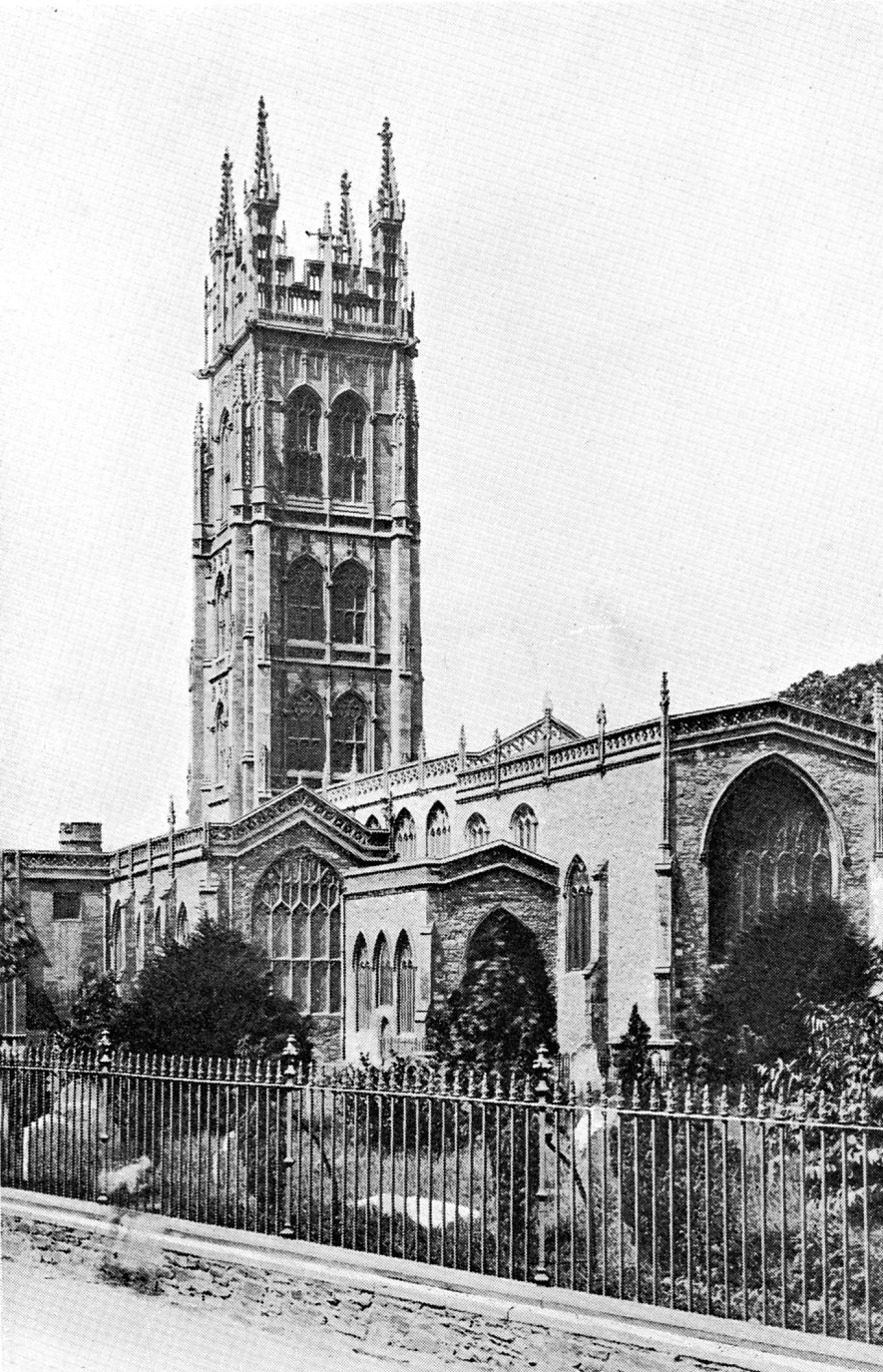
|
| A Fine Perpendicular Tower. St. Mary, Taunton. Photograph H. Montague Cooper. Click to ENLARGE |
Of Perpendicular date and style, also, are the great lantern towers of Worcester, Bristol, Gloucester, York and Durham Cathedrals, in addition to the fine bell-tower of Evesham Abbey.
The spire, although less commonly used than formerly, was by no means abandoned, and beautiful examples of Perpendicular spires are those at S. Michael's, Coventry, and Rotherham Church, Yorkshire. Although nearly all our cathedrals have some portion of their fabric in the Perpendicular style, chantries, chapels, cloisters, vaulting, screens, etc., it was in our parochial churches that Perpendicular architecture reached its highest and finest development. Just as the XIIIth century was the great age for cathedral building, so the latter end of the XIVth and earlier half of the XVth centuries was the period to which we owe some of the most beautiful of our parish churches, as S. Michael's, Coventry (fin. 1395); S. Nicholas, Lynn (fin. 1400); Manchester Cathedral (formerly a collegiate church), (1422); Fotheringay Church, Northants (fin. 1435); Southwold Church, Suffolk (1440), and S. Mary Redcliffe, Bristol (about 1442). A little later came, among others, Wakefield Church, Yorkshire (1470), S. Stephen's, Bristol (1470), S. Mary's, Oxford, and its namesake at Cambridge (both in 1478) and Long Melford Church, Suffolk (1481).
Apart from the actual buildings the Perpendicular architects, masons and sculptors have left us some beautiful work in the form of timber roofs, screens, stalls and seats. Among the more notable roofs of this period are those at S. Peter's, S. Andrew's and S. Mary's, Norwich, the one at Morton Church in Somerset, those at Saffron Walden and Thaxted, Essex, and a particularly fine one at S. David's Cathedral in Wales. Among the remarkable domestic roofs in this style are those at Westminster Hall and Eltham Palace.
1: So called from its "flame"-like appearance, producing forms which resemble elongated tongues of flame. There is great beauty in much of this work, but it is constructionally weak. The finest example is Chartres Cathedral.
So far we have been considering Gothic churches, but we now come to the time when, from a variety of causes, the Italian architects, among them Palladio and Vitruvius, began to revive classical architecture, a movement which gradually spread over other parts of Europe. The various causes which led to this apparently retrograde movement are still involved in considerable obscurity. The commercial prosperity of the age produced a class who travelled abroad and cultivated the fine arts, with the result that they desired to see erected in England buildings such as they had seen in Rome, Florence, Genoa and Padua. It is generally admitted that the ramifications of Gothic architecture had reached their utmost limit, and the style was getting out of hand, as is seen by the flamboyant buildings on the continent. The revival of classical literature in western Europe gave an impetus to the movement which was largely intended to enfold art within the shelter of an enlightened taste, and protect it from the licence of unordered enthusiasm. How far it succeeded is not a question that can be discussed at length here, but, however good their intentions may have been, the architects used little discrimination in the selection of buildings which were to serve as models for Christian churches, and although subsequently considerable improvements were made, yet, most of the defects in the[75] pagan buildings of the ancients were retained in such as were intended to be utilized for Christian worship, and even considered purely as exercises in architecture it was not until the more chaste remains of antiquity began to be studied that the spirit and harmony of the good examples were attained. A greater contrast than the methods employed by the Gothic mason and the Renaissance architect could not well be imagined. The former shaped his material with his own hands; the foster mother of his art was tradition and its cradle the craftsman's bench; whereas the latter, with no builder's training, worked out his flawless and precise plans in the exotic atmosphere of the office and the study. The practice of making working drawings for every detail of the building was the cause of the decline of ornamental sculpture, with the result that all life and growth in the building ceased. Some authorities are very severe on the Renaissance movement. Dr. Fergusson, in his "Modern Styles of Architecture," says: "During the Gothic era the art of building was evolved by the simple exercise of man's reason, with the result that the work of this period is the instinctive natural growth of man's mind. The buildings, on the other hand, which were designed in the imitative styles, and produced on a totally different principle, present us with an entirely different result, and one which frequently degrades architecture from its high position of a quasi-natural production to that of a mere imitative art."
Be this as it may, the severe classical style introduced into England by Inigo Jones (who studied in Italy under Palladio), and continued by Sir Christopher Wren, soon swept everything before it.
Our most remarkable church in this style is S. Paul's Cathedral, which in style has two very adverse circumstances to struggle against. In the first place, it bears so great a similarity to the great church of S. Peter, at Rome, that one cannot help comparing it with that fine example, and secondly, it is the only English cathedral which is not in the Gothic style. It must, of[76] course, be acknowledged that S. Paul's falls far short of S. Peter's, especially in its lighting, but it does not deserve the condemnation of a great German critic, who said, "It is a building marked neither by elegance of form nor vigour of style." Although the interior of its dome and clerestory of the nave and choir are extremely gloomy when compared with those of S. Peter's, the church is generally acknowledged to be far superior to the latter in its architectural details, and few, if any, Italian churches can be said to surpass it, either in general composition or external effect, although it must be admitted that everything having been sacrificed to attain the latter quality, S. Paul's taken as a whole, is neither worthy of its fine situation nor of its great architect.
Other churches which are excellent examples of this style are S. Stephen's, Walbrook, and S. Mary Abchurch, London. Both show remarkable skill. The former is divided into a nave and four aisles, transepts, and a shallow chancel, by four rows of Corinthian columns, with a small dome over the intersection. The interior is very beautiful, and this church is generally considered to be Wren's masterpiece. S. Mary Abchurch, is nearly square in plan, has no columns and is covered with a domical ceiling, but so skilfully treated that the effect is singularly pleasing.
Of the Elizabethan and Jacobean buildings it is necessary to say little, as at best they are but clumsy imitations of the Flemish, French and Italian Renaissance, while the style which we now call Queen Anne came in towards the close of the XVIIth century, and belongs of right to the reign of Charles II.
Hawkesmore, a pupil and follower of Wren, was a strong architect who has left us Christ Church, Spitalfields, and S. Mary Woolnoth. He also designed the western towers of Westminster Abbey, often wrongly ascribed to Wren, and the second quadrangle of All Saints' College, Oxford. This architect, like the majority of his contemporaries, misunderstood and despised the Gothic style, with which he had little real sympathy; he drew out designs, which still exist, for converting[77] Westminster Abbey into an Italian church, just as Inigo Jones had done with the exterior of the nave of old S. Paul's, but we cannot be too thankful that this abominable suggestion was never carried out.
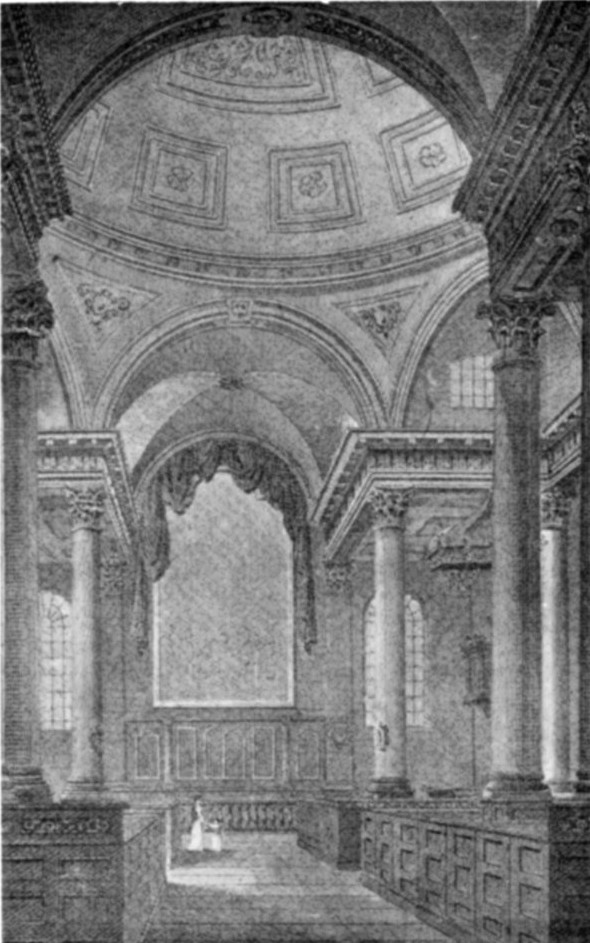
|
| An English Renaissance Church. S. Stephen's, Walbrook, London. Generally considered to be Sir Christopher Wren's masterpiece. From an Engraving dated 1806. Click to ENLARGE |
[78]With King George III. on the throne our ancestors contented themselves with dull, but substantial, buildings of which some hard things have been written, but they were at least respectable and free from sham, while the churches, although not elegant, were well-built and occasionally picturesque, as we see by the perfect little building of this date at Billesley, Warwickshire.
The eighteenth century pseudo-classical abominations and sham Gothic, so favoured by Horace Walpole and his admirers, can be briefly dismissed. A more rampant piece of absurdity than that of erecting imitations of portions of Greek temples and adapting them for Christian worship it is difficult to imagine, and in the Pavilion at Brighton, Marylebone Church, and the "Extinguisher" Church in Langham Place we even surpassed in bad taste and vulgarity all the absurdities of the Continental architecture produced by the French Revolution.
Two men now came on the scene who, united, were destined to bring some kind of order out of this chaos. Barry and Pugin were both scholars and architects, for while the former rather favoured the classical style he thoroughly understood the Gothic, while Pugin was a thorough mediævalist, a true artist, and a bold exponent in his "Contrasts" of a complete return to mediæval architecture as the only possible cure for the evils which had crept into the art of building.
Barry's idea, which was perhaps the more practical, was to correct by careful study the errors into which the later exponents of both Classic and Gothic architecture had fallen, and endeavour by well thought out modifications to evolve a style more suitable to modern requirements. Pugin, however, would have none of the evil thing, and although he supplied his friend with designs for the details and woodwork of the Houses of Parliament which Barry was rebuilding, they did not collaborate[79] in any further way, and both died before the Houses of Parliament were completed, in which, as a matter of fact, Barry's designs were completely ignored. The Reform Club is considered to be the best of Barry's classical buildings.
Pugin's earlier works were mostly Roman Catholic churches, and they are acknowledged to be an immense advance on any Gothic work which had been seen for centuries. In the Roman Catholic Cathedral of S. Chad, at Birmingham, there is a dignity, loftiness and simplicity surpassed by few Gothic buildings when that style was at its zenith, and from the time Pugin designed this building, architecture—notwithstanding our exhaustive study of archæology, our immense resources of capital and labour, our science and labour-saving appliances, and the comparative accessibility of the finest materials—has neither developed nor advanced. The most erudite Gothic mason could have possessed but little art knowledge as compared with the modern architect, and yet with our learned societies, wonderful libraries, easily obtained photographs and plans of the best buildings in the world; with writers far superior in intellectual acquirements to those of the Middle Ages, our vast wealth, with our tools such as the mediæval craftsman could never have dreamed of, and with the experience of twenty centuries to guide us we have made no advance during more than half a century. Our best architects acknowledge that until we get a new method of building, originality in architecture is an impossibility, mainly because all the existing styles of architecture have been worked out to their legitimate conclusion, and have been perfected under circumstances and conditions with which we have entirely broken; the originality in detail which pervades and permeates our Gothic buildings and gives them the greater part of their charm, must, of necessity, be out of our reach until we blend the spirit of what we are pleased to call our practical age, with a certain amount of that spirit of poetry and romance, religious fervour and devoutness, which animated the builders and craftsmen of the past. [80]
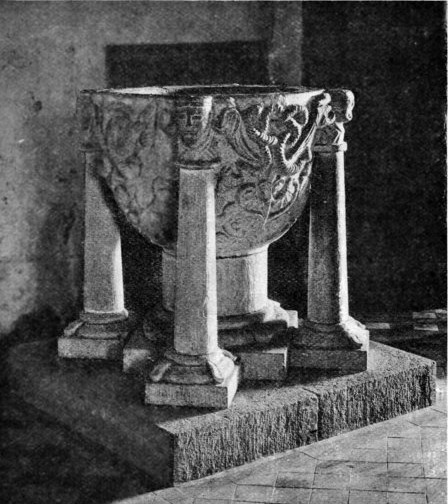
|
| A Typical Cornish Font. Probably of the late Norman period. Now at Maker, near Plymouth. Click to ENLARGE |
The most important part of the internal furniture of a church is the altar, a name derived from the Latin altare, a high place. The Altar.The altar is a raised structure on which propitiatory offerings are placed. In the Christian church the altar is a table or slab on which the instruments of the Eucharist are displayed. The early[81] Christian altars were portable structures of wood, and the Church of Rome still allows the use of an altar of this description, although a consecrated stone, containing an authentic relic and regarded as the true altar, must be placed upon the wooden table. The slab forming the altar was sometimes supported on pillars, but more frequently on solid masonry, and previous to the Reformation it was marked with five crosses cut into the top, in allusion to the five wounds of Christ. From the period that stone altars were introduced it was usual to enclose within them the relics of saints, so that in some cases they were the actual tombs of saints. In England the altars were generally taken down about the year 1550, set up again in the beginning of the reign of Queen Mary, and again removed in the second year of Queen Elizabeth. In the church of Porlock, Somerset, the original high altar has been preserved, though not in use, being placed against the north wall of the chancel. In Dunster Church, in the same county, there is a solid stone altar, said to have been the original high altar, and in the ruined church of S. Mary Magdalene at Ripon, the high altar has escaped destruction. Of chantry altars we have several left, including those at Abbey Dore, Herefordshire; Grosmont, Monmouthshire; Chipping Norton, Oxon.; Warmington, Warwick; S. Giles's, Oxford; Lincoln Cathedral, and many others; and it is rare to find a Gothic church without some traces of altars in their various chapels, oratories or chantries.
The altar is, of course, an adoption by the Christian church of a pagan aid to worship, and at S. Mary's church, Wareham, which is thought to stand on the site of a Roman temple, are some pieces of stone considered by antiquaries to be portions of a pagan altar, on which burnt offerings were placed.
Above many Christian altars was placed a piece of sculpture or a painting representing some religious subject. These altar pieces sometimes consist of two pictures, when they are called "diptyches," and sometimes of three pictures, when they are called "triptyches,"[82] and both forms usually fold up or are provided with shutters. They are often rare examples of the Flemish and other schools of painting, and of great value.
At the Reformation the stone altar was displaced by the communion table, which at first occupied the position vacated by the altar. This gave umbrage to the Puritan mind, and the communion table was then usually placed in the centre of the chancel, with seats all round for the communicants; which arrangement is still in vogue in some of our English churches and in Jersey, although at the Restoration the communion table was, as a general rule, replaced at the eastern wall of the Chancel.
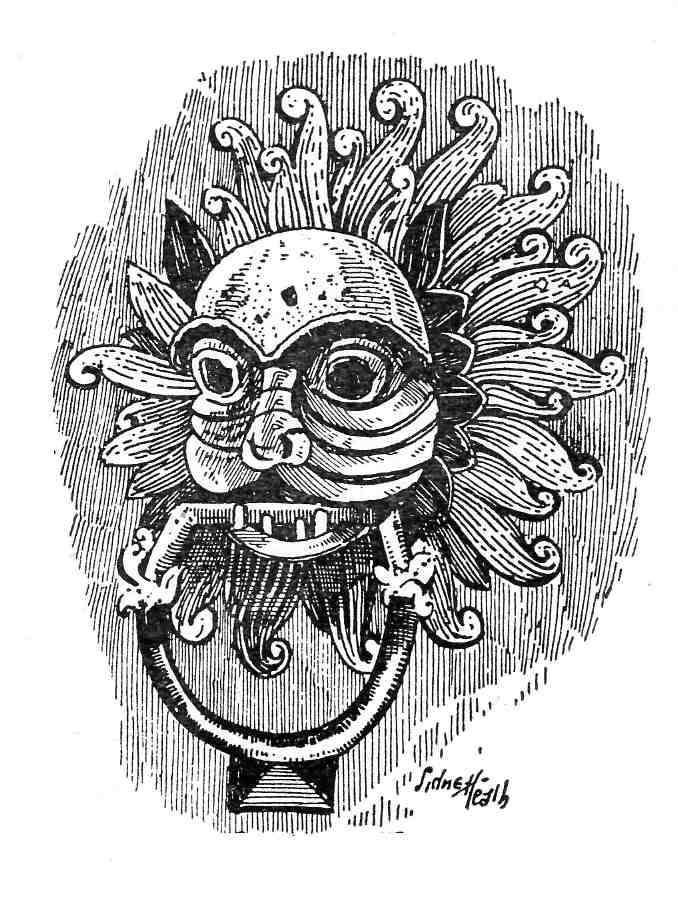 Durham Sanctuary Knocker
Durham Sanctuary KnockerLong before the Christian era the altar was regarded as a place of refuge for those fleeing from justice or oppression, and this custom or privilege of sanctuary was sanctioned by the English bishops and was retained for many centuries by the Christian Church. Many of our parish churches claim to possess old sanctuary rings or knockers, but it is doubtful if any of these were ever used by fugitives, for the reason that although in early days every parish church had the right to grant sanctuary, few possessed the means of feeding and housing a refugee, save in the church itself, which was expressly forbidden. This is why we find records of fugitives travelling many miles at the risk of their lives and passing hundreds of parish churches in their endeavour to reach Bury St. Edmunds, Hexham, Durham or some other of the well-recognised sanctuaries. The only sanctuary knocker remaining to-day, which is above suspicion, is that at Durham Cathedral. It is made of bronze and represents the grotesque head of a dragon, the ring coming from the mouth. Above the door is a small room in which[83] attendants watched by day and night, and when a fugitive was admitted a bell was rung to announce that someone had taken sanctuary.
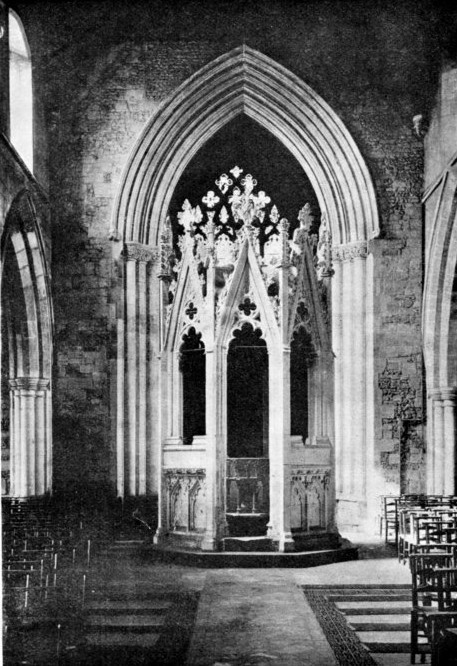
|
| The Baptistery in Luton Church. Photograph Fredk. Thurston, F.R.P.S. Click to ENLARGE |
[84]The font, as we have seen, was originally placed in a separate building called the baptistery.The Font. The only known example of anything of the kind in England is that in S. Mary's Church, Luton, fully described in The Homeland Handbook, No. 47. It is in the Decorated style, dates from the time of Edward III., and is said to have been designed by William of Wykeham for Queen Philippa. It is composed of white stone with open panels, pierced by cinquefoils and quatrefoils, while the apex of each panel terminates in a foliated finial. The font inside is octagonal in form and of 13th century date, but it has been somewhat restored. Ancient fonts were always large enough to allow for total immersion, and our present custom of baptism by affusion, or sprinkling, is only permitted, not enjoined by the rubric. In early days the sacrament of baptism was only administered by the bishops at the great festivals of Pentecost and Easter, for the reason that this afforded the greater convenience for immediate confirmation, but with the increase in the number of churches the rite was administered by the priests in every village.
The font was required by the canon to be of stone, but there are a few Norman fonts made of lead, among them those at S. Mary's Church, Wareham, Walton-on-the-Hill, Surrey, and at Edburton, Parham, and Pyecombe, Sussex. A remarkable font is that at Dolton Church, Devon, made up of fragments of the churchyard cross, and there is also a somewhat similar one at Melbury Bubb, Dorset. By a constitution of Edmund, Archbishop of Canterbury (1236), fonts were required to be covered and locked, and at first these covers were little more than plain lids, but they afterwards became highly ornamental and were enriched with buttresses, pinnacles, crockets, etc. It is doubtful if any fonts exist which can reasonably be supposed to be Saxon, although a few, like that at Little Billing, Northants, may possibly be of that era. Of Norman[85] fonts we have large numbers. They are sometimes plain hollow cylinders; others are massive squares with a large pillar in the centre, and small shafts at the corners. These fonts are generally ornamented with rudely executed carvings, consisting of foliage and grotesque animals.
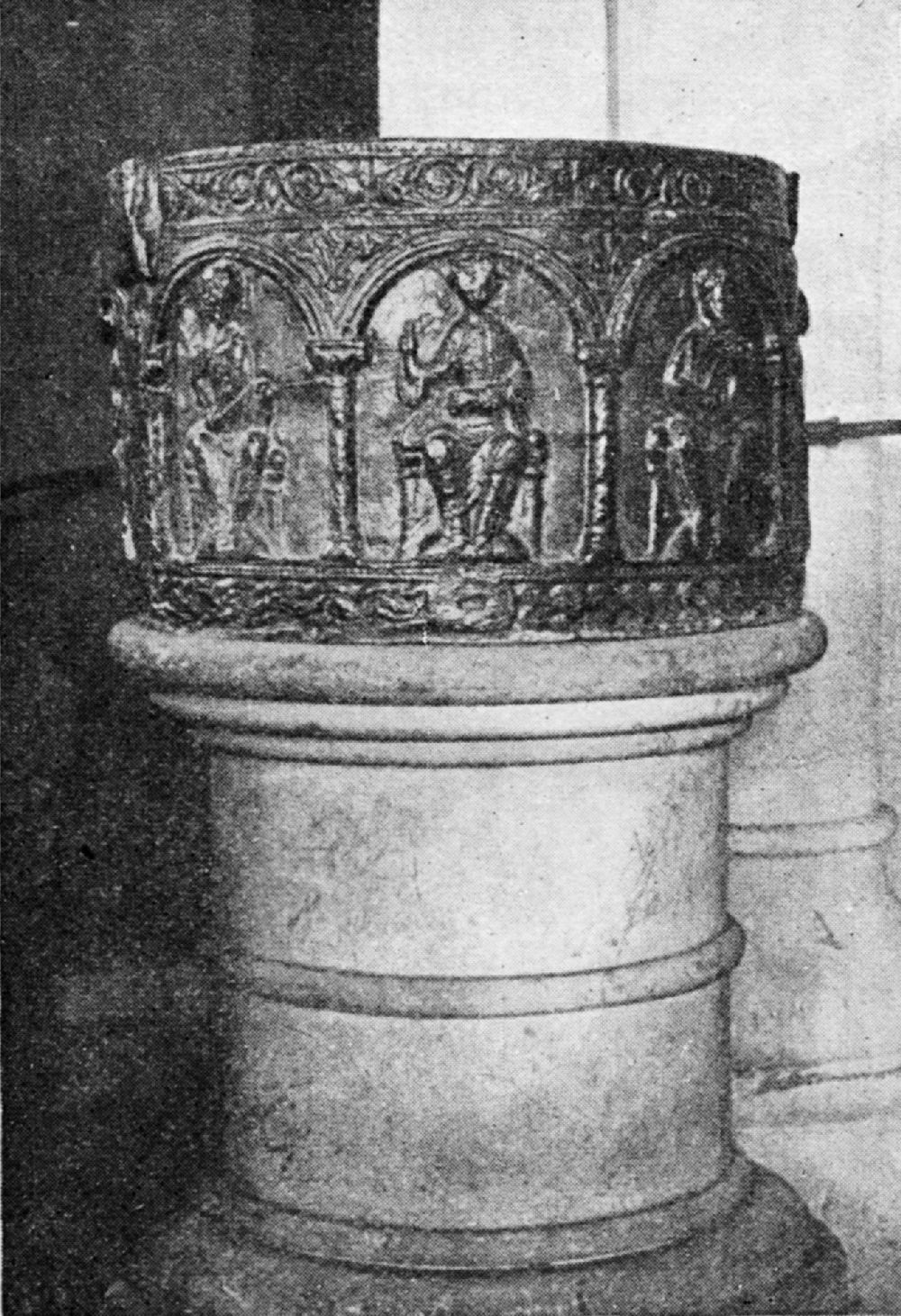
|
| An Example of a Leaden Font of the late Norman period. Walton-on-the-Hill, Surrey Click to ENLARGE |
The one in Winchester Cathedral is a good example, and there are three other very similar ones in Hampshire. Early English fonts are very often circular, and sometimes square, and they are often supported in much the same way as the Norman ones. In the Decorated and Perpendicular styles they[86] are, with few exceptions, octagonal, and the details generally partake of the character of those used in the other architectural features of the period. There are hexagonal fonts of Decorated date at Rolvenden, Kent, and Heckington, Lincs. The font is usually placed close to a pillar near the entrance, generally that nearest but one to the tower in the south arcade, or, in larger buildings, in the middle of the nave.
The holy-water stoups sometimes found in our old churches are generally small niches with stone basins formed in the wall either in or just outside the porch, or within the church close to the door, or in one of the pillars nearest to the door. These niches resemble piscinas, except that they differ in situation, are smaller and plainer, and rarely have a drain. A good example of an outside stoup is that at Broadmayne, Dorset, where there is also one inside the church. They are rarely found unmutilated, but there is one in perfect condition in the north porch of Thornham Church, Kent; and a rather elaborate example at Pylle Church, near Glastonbury.
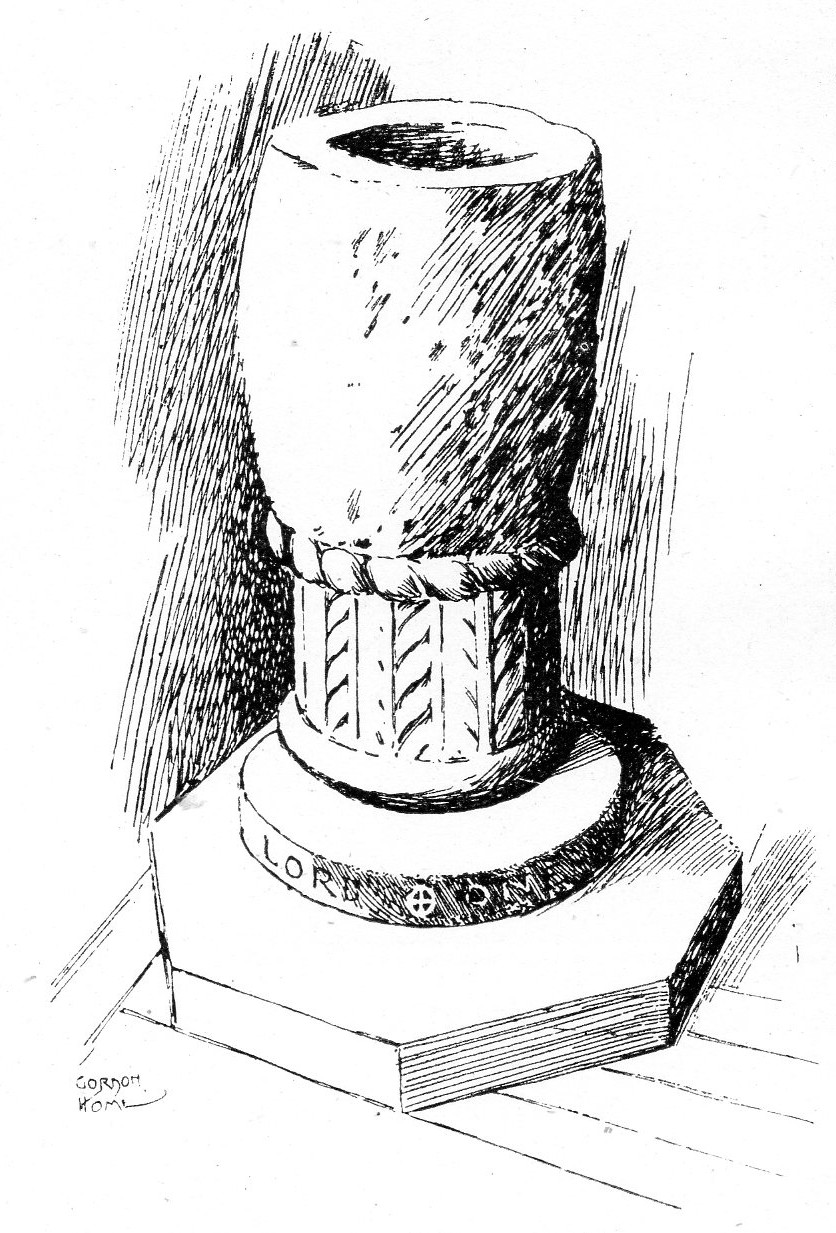 A Reputed Saxon Font.
A Reputed Saxon Font.The piscina is a water-drain formerly placed near the altar and consisting of a shallow stone basin, or sink, with a drain to carry off whatever is poured into it. It was used to receive the water in[87] which the priest washed his hands, as well as for that with which the chalice was rinsed at the celebration of the mass. It was usually placed within a niche, although the basin often projects from the face of the wall, and is sometimes supported on a shaft rising from the floor. In the Early English and Decorated periods there are often two basins and two drains, and occasionally three. Within the niche a wooden or stone shelf is often found, called a credence-table, on which the sacred vessels were placed previous to their being required at the altar.
Piscinas are unknown in England of earlier date than the middle of the 12th century, and of that date they are extremely rare. Of thirteenth and succeeding centuries we have many examples, more or less mutilated. Their forms and decorations are very various, but the character of their architectural features will always decide their approximate date.
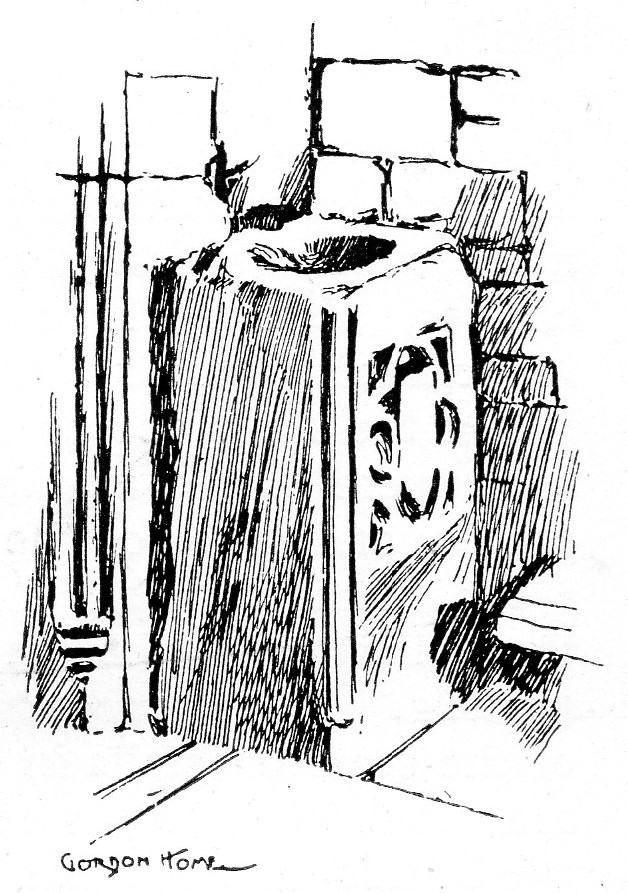 A Detached Holy-water Stoup
A Detached Holy-water StoupThe Sedilia, from the Latin sedile, a seat, has come to be applied in modern times to the seats used by the celebrants during the pauses in the mass. Sedilia.They were sometimes moveable, but more usually in this country were formed of masonry and recessed in the wall. They are generally three in number, for the priest, deacon and sub-deacon, while in a few rare instances they number four seats, as at Rothwell Church, Northants, and Furness Abbey; or even five, as at Southwell Minster. Sometimes a long single seat under one arch is found, and when three seats are used the two western ones are often on the same level and the eastern one raised above them. Numerous examples remain in our churches,[88] some being as early as the latter part of the 12th century, but they are mostly later and extend to the end of the Perpendicular style. Some of them are separated by shafts, and profusely ornamented with panelling, niches, statues, pinnacles, tabernacle work, and crowned with canopies all more or less elaborately enriched.
Stalls are fixed seats in the choir, either wholly or partially enclosed and used by the clergy. Previous to the Reformation all large and many small churches had a range of wooden stalls on each side and at the west end of the choir. In cathedrals they were enclosed at the back with panelling, and surmounted by overhanging canopies of tabernacle work, generally of oak, of which those at Winchester, Henry VII.'s Chapel at Westminster, and Manchester Cathedral are possibly our finest examples. When the stalls occupied both sides of the choir, return seats were placed at the ends for the prior, dean, precentor, and other of the officiating clergy.
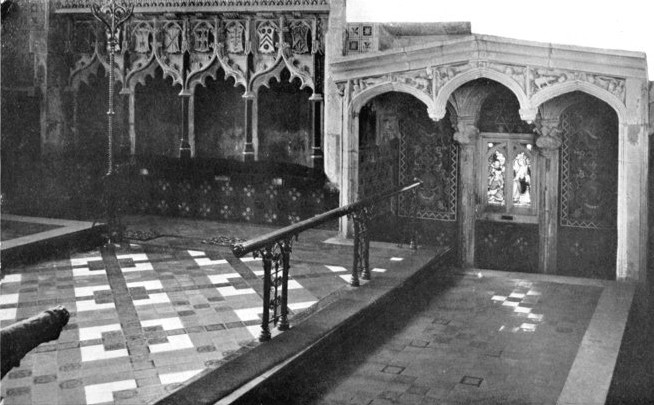
|
| Sedilia and Chantry. Luton, Beds. Photograph Fredk. Thurston, F.R.P.S. Click to ENLARGE |
Mr. Parker, in his "Glossary of Architecture," gives the following definition of the miserere, patience or pretella. "The projecting bracket on the underside of the seats of stalls in churches; these, when perfect, are fixed with hinges so they may be turned up, and when this is done the projection of the miserere is sufficient, without actually forming a seat, to afford very considerable rest to anyone leaning upon it. They were allowed as a relief to the infirm during the long services that were required to be performed by ecclesiastics in a standing posture." It is in the carving of these that one is frequently struck by the curious mixture of the sacred and the profane, the refined and the vulgar, for which it is difficult to find any adequate explanation. Of so coarse a nature are some of these carvings that it has been necessary to entirely remove them from the stalls. They are usually attributed to the mendicant and wandering monks, and they undoubtedly reflect the licentiousness which at one time pervaded the monastic and conventual establishments. Among our best examples are those at Christchurch Priory, Hants, and[89] in Henry VII.'s Chapel. There is a remarkably complete set in Exeter Cathedral.
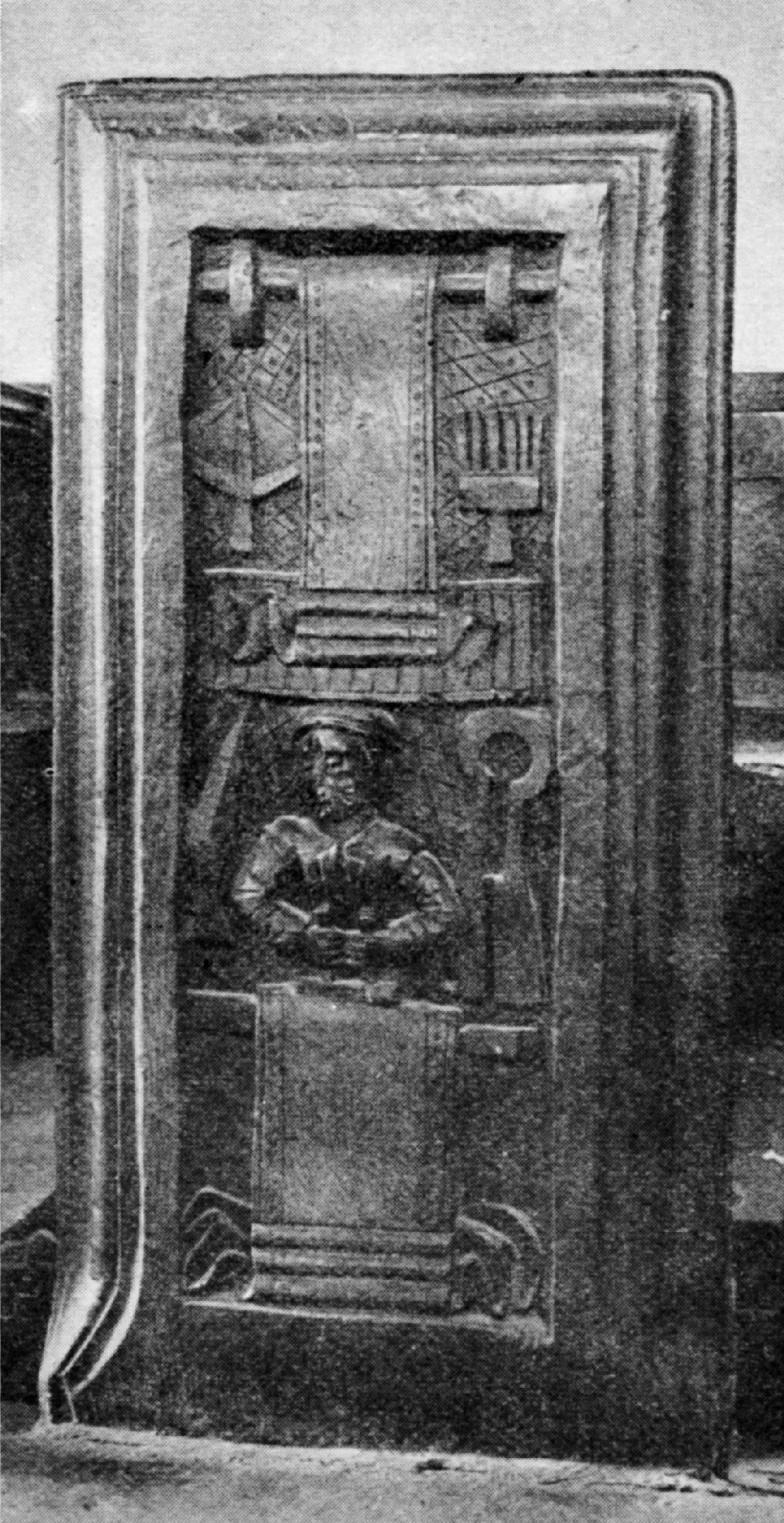 A Typical Somerset Bench-End,
A Typical Somerset Bench-End,Of modern pews it is not necessary to say anything here, but previous to the Reformation the nave of a church was usually fitted with fixed seats, parted from each other by wainscoting, and partially enclosed at the ends by framed panelling, but more often by solid pieces of wood, either panelled or carved on the front. These bench-ends are very common in the West of England, in Somerset and Devon, and they are often very beautiful pieces of work and were in all probability executed by local craftsmen. They embrace a variety of subjects: figures, scrolls, dragons, serpents, etc., and frequently bear the arms of the family who owned the pew. Sometimes they terminate at the top with finials either in the form of heads, bunches of foliage, a chamfered fleur-de-lys and a variety of other ornaments called Poppy-heads, from the French Poupée. No examples[90] are known to exist earlier than the Decorated style, but of Perpendicular date specimens are very numerous, especially in our cathedrals and old abbey churches.
Pulpits were formerly placed, not only in churches, but in the refectories and occasionally in the cloisters of monasteries, and there is one in the outer court of Magdalen College, Oxford, and another at Shrewsbury. In former times pulpits were placed in the nave attached to a wall, pillar or screen, usually against the second pier from the chancel arch. Some are of wood, others of stone; the former are mostly polygonal, with the panels enriched with foliation or tracery. Few exist of earlier date than the Perpendicular style, but stone pulpits of Decorated date are sometimes met with as at Beaulieu, Hants, a very early specimen. Wooden pulpits are usually hexagonal or octagonal; some stand on slender wooden stems, others on stone bases. A few have canopies or sounding boards, and their dates can be fixed by the character of their ornamentation. At Kenton, Devon, there is an early pulpit which has retained its original paintings. Jacobean pulpits are very numerous, and are frequently gilded and painted; the one at S. Saviour's Church, Dartmouth, being a most elaborate example.
Open-air preaching is anything but a modern invention, for long before the erection of parish churches it was the recognised method of addressing the people. There is a print of some popular bishop preaching in a pulpit at Paul's Cross in S. Paul's Churchyard, and in mediæval days open-air pulpits were erected near the roads, on bridges and often on the steps of the market crosses, which are often still known as preaching crosses.
In some of our churches is to be seen a squint, an opening in an oblique direction through a wall or pier for the purpose of enabling persons in the aisles or transepts to see the elevation of the Host at the high altar. They are of frequent occurrence in our churches and are very numerous in the neighbourhood of Tenby, South Wales, also[91] in Devon and the West generally.
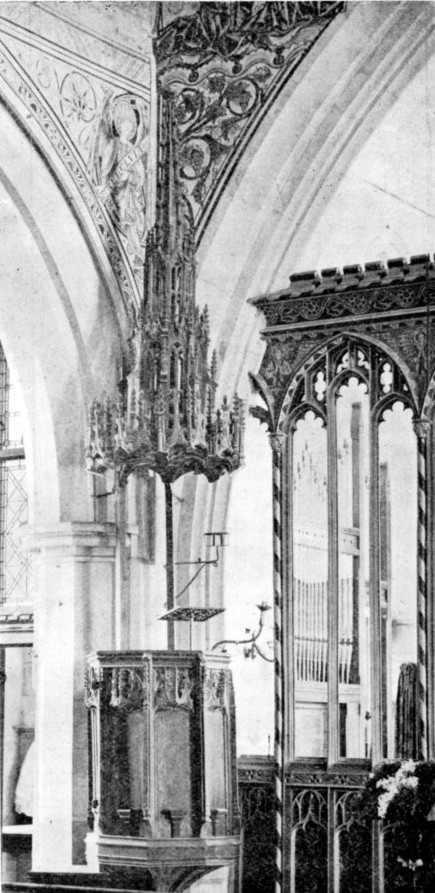 A Richly Carved Pulpit and Canopy.
A Richly Carved Pulpit and Canopy.They are usually without any ornament, but are sometimes arched and enriched with tracery. They are mostly found on one or both sides of the chancel arch, but they sometimes occur in rooms above porches, in side-chapels and the like; in every instance they were so situated that the altar could be seen. When they occur in porches or the rooms above they are thought to have been for the use[92] of the acolyte appointed to ring the sanctus bell, who, viewing the performance of mass, would be thus able to sound the bell at the proper time. The name hagioscope has been used to describe these oblique openings.
Cruciform marks are sometimes found on our churches, often on a stone in the porch; they are usually incised crosses or five dots in the form of a cross. They were, presumably, cut by the bishop when the building was consecrated, and are called consecration crosses.
The rood-screens, separating the chancel or choir of a church from the nave, usually supported the great Rood or Crucifix, not actually on the screen itself, but on a beam called the rood-beam, or by a gallery called the rood-loft, which last was approached from the inside of the church, by a small stone staircase in the wall, as can be seen in many of our churches to-day. Although rood-lofts have been generally destroyed in England, some beautiful examples remain at Long Sutton, Barnwell, Dunster and Minehead, Somerset; Kemsing, Kent; Newark, Nottingham; Uffendon, Collumpton, Dartmouth, Kenton, Plymtree and Hartland, Devon. The general construction of wooden screens is close panelling below, from which rise tall slender balusters, or wooden mullions supporting tracery rich with cornices and crestings, frequently painted and gilded. The lower panels often depict saints and martyrs. From the top of the screen certain parts of the services and the lessons were read. They were occasionally close together and glazed, as we see by a most beautiful example at Charlton-on-Otmoor, in Oxfordshire. These screens, many of which have been over-restored, are very common, and in addition to those above mentioned, are found at S. Mary's, Stamford, Ottery S. Mary, Chudleigh, Bovey, and in nearly all the Devon parish churches. At Dunstable a screen of Queen Mary's time separates the vestry from the chancel.[93]
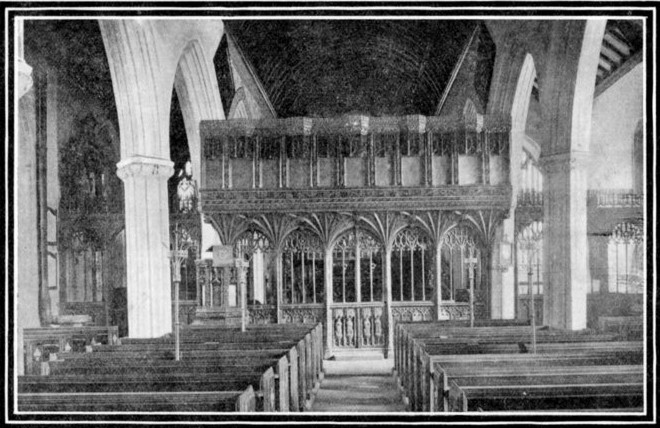
|
| Screen with Rood Loft. Kenton, Devon. Photograph by Chapman. Click to ENLARGE |
Of stone screens space will permit of only the briefest mention. They were used in various situations, to enclose tombs and to separate chapels, and occasionally the[94] rood-screen was of stone. The oldest piece of screen work in this country is that at Compton Church, Surrey; it is of wood and shows the transition from the Norman to the Early English styles.
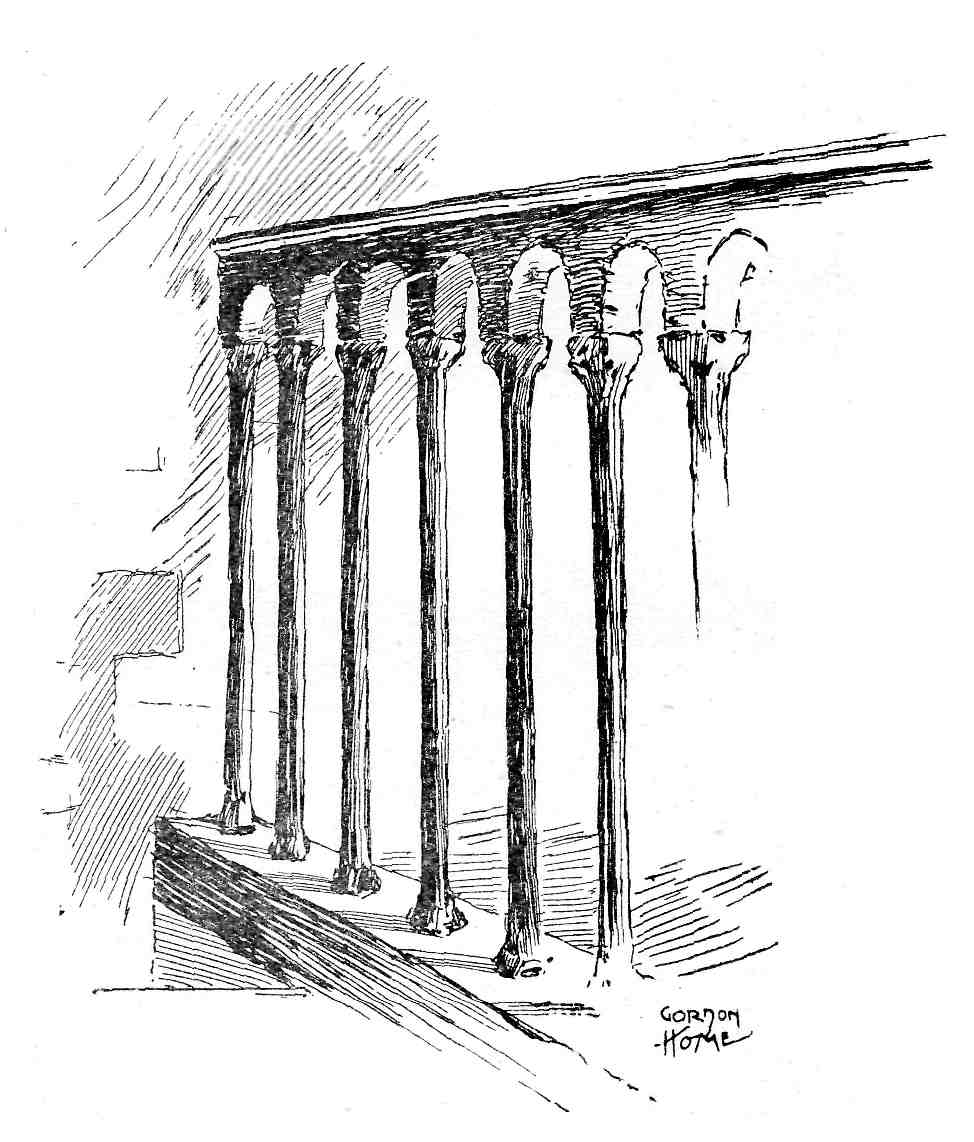 The Carved Oak Balustrade in
The Carved Oak Balustrade inStone screens are often massive structures enriched with niches, statues, tabernacles, pinnacles, crestings, etc., as those at Canterbury, York and Gloucester.
The reredos forms no part of the altar, and is often highly enriched with niches, buttresses, pinnacles, and other ornaments. Not infrequently it extends across the whole breadth of the church, and is sometimes carried nearly up to the roof, as at S. Alban's Abbey, Durham and Gloucester Cathedrals, S. Saviour's, Southwark and in that remarkably fine example at Christchurch, Hants. In village churches they are mostly very simple, and generally have no ornaments formed in the wall, though niches and corbels are sometimes provided to carry images, and that part of the wall immediately over the altar is panelled, as at S. Michael's, Oxford; Solihull, Warwickshire; Euston and Hanwell, Oxfordshire, etc.
It is interesting to note that the open fire-hearth, once used in domestic halls, was also called a "reredos."
The history of bells is lost in antiquity, and little is known about them previous to the XVth century. It is probable, however, that they were used in India and China centuries before they reached Europe.
Bells were used by the Romans for many secular purposes, and although their use was sanctioned by the Christian Church about 400 A.D., they were not in general use in England until 650 A.D.
The earliest bells were hand bells, quadrangular in shape, and made of thin plates of copper or iron riveted together, and their abominable sound when struck must have been one of their chief merits, as the early bells were much used for the purpose of frightening the devil and other evil spirits.
Our oldest bells are hand bells, S. Patrick's bell at Belfast (1091) and S. Ninian's bell at Edinburgh, which is probably of even earlier date. From 1550 to 1750 was the golden age of production for bells, more especially so in Belgium and the Low Countries, where the bells of the towers and belfries were rung to arouse the country in times of danger and invasion. It is quite possible that the bells used for secular and religious purposes were kept distinct. Bells played a very important part in mediæval life, and next to cannon were regarded as the chief city guardians, for he who held the bells held the town, and[96] the first thing done by the invader on taking a town was to melt the bells and thus destroy the means of communicating an alarm.
In England our old towns, being almost entirely constructed of wood, were liable to periodic and devastating conflagrations, which fact suggested to that genius, William the Conqueror, the institution of Couvre-feu, or in its more popular form, Curfew, which rang at eight o'clock in the evening, when all lights were to be extinguished. The ringing of curfew has survived in many of our towns and villages to this day, but it is doubtful if the custom has been continuous from its first institution.
The secular use of the bell is, however, only incidental, and it is in its connection with religious life that we are now concerned, for all church history, church doctrine and church custom and observances are set to bell music. Bells in fact may be said to sum up the short span of our mortal life, for the birthday, the wedding and the funeral, are all welded to religion by the church bell.
Bells were used for ecclesiastical purposes in England long before the erection of our parish churches, for Bede, speaking of the death of S. Hilda, A.D. 680, says that "one of the sisters in the distant monastery of Hackness, thought she heard as she slept, the sound of the bell which called them to prayers," and Turketul gave to Croyland Abbey a great bell called Guthlac, and afterwards six others which he called Bartholomew and Betelin, Turketul and Tatwin, and Pega and Bega.
S. Dunstan gave bells to many of the churches in Somerset, and he also seems to have introduced bell ringing into the monasteries.
A few words may be of interest concerning the number and purposes of these monastic bells, with which the life of the monks must have been completely bound up. The Signum woke up the whole community at day-break. The Squilla announced the frugal meal in the refectory; but for those working in the gardens, the cloister-bell, or Campanella, was rung. The abbot's Cordon, or handbell, summoned the brothers and novices[97] to their Superior; whilst the Petasius was used to call in those working at a distance from the main building. At bed-time the Tiniolum was sounded, and the Noctula was rung at intervals throughout the night to call the monks to watch and pray. The Corrigiumcula was the scourging bell, while the sweet-toned Nota, a choir bell, was rung at the consecration of the elements.
The use of the bell-tower was recognised in the ancient Saxon law, which gave the title of thane to anyone who had a church with a bell-tower on his estate, and two of our most interesting Saxon churches, Brixworth and Brigstock, both in Northamptonshire, have each a semi-circular tower rising together with the bell-tower, and forming a staircase to it.
One of the most beautiful campaniles or bell-towers still standing is that at Evesham, in Worcestershire, which is a good specimen of Perpendicular architecture. It was built by Abbot Lichfield, the last abbot but one of the abbey, and took six years in building, and was not quite completed when the famous abbey, of which it was a final ornament, was pulled down.
In addition to this example at Evesham, detached bell-towers exist, or once existed, at Chichester, East Dereham, Glastonbury Abbey, Bruton, in Somerset, and in several other places.
Markland, in his Remarks on Churches, says: "The great bell-tower which once formed part of the abbey church of S. Edmundsbury was commenced about 1436. From the year 1441 to 1500 legacies were still being given towards the building. In 1461 an individual, probably a benefactor, desired to be buried in magno ostio novi campanilis."
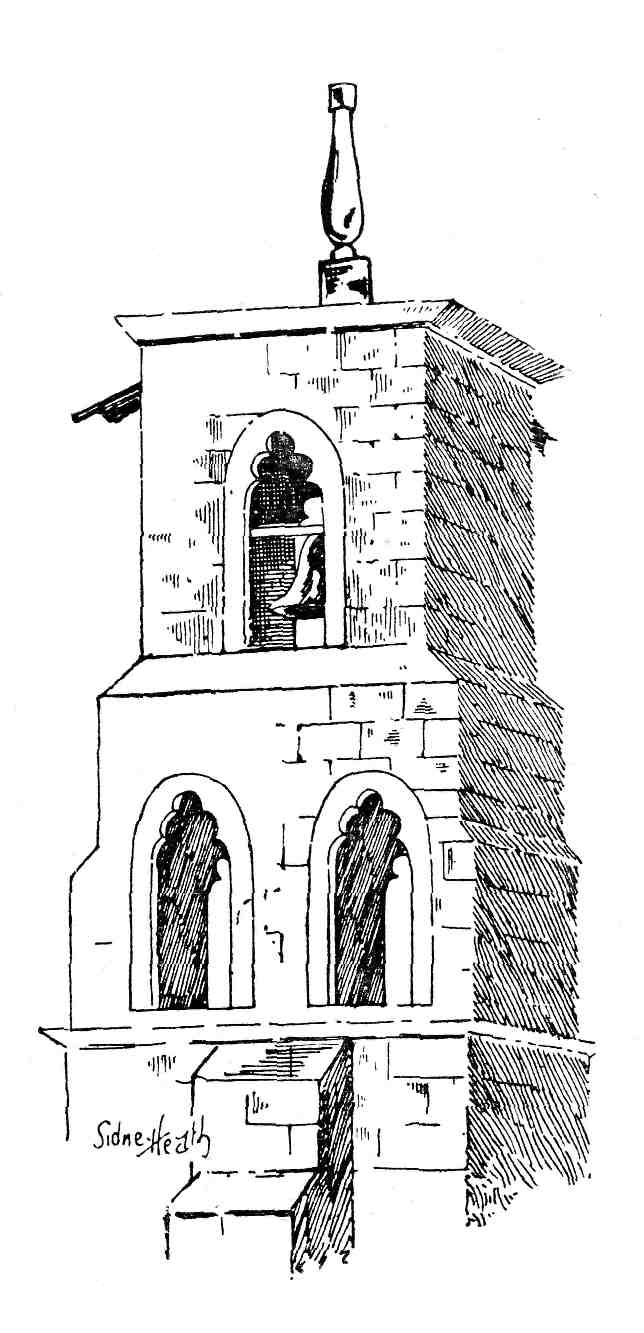 Bell Turret for 3 Bells.
Bell Turret for 3 Bells.In Protestant use church bells have been stripped of much of the former superstition and symbolism. They are no longer rung to announce the miracle of transubstantiation; neither are they called upon as of old for the purpose of scaring devils, demons, and other evil spirits which formed so prominent a feature in the faith of the early Christian communities. Closely connected with the subject of bells and belfries are the[98] bell-gables or bell-turrets, so frequently found at the west ends of our smaller churches which have no towers.
They usually contain but one bell, but are sometimes found with two, and at Radipole Church, near Weymouth, the bell-turret was originally designed to carry three bells. They are generally most picturesque little features of which a few may be of Norman date, but by far the greater number of them are Early English, a style in which they are frequently found. In addition to these bell-turrets at the western ends of our churches one sometimes finds a similar, but smaller, erection at the eastern end of the roof of the nave, but used for a very different purpose, for while the bell at the western end was rung to summon the parishioners to service, that at the eastern end, known as the Sanctus or Mass-bell, was rung on the elevation of the Host during the celebration of mass; although usually placed on the apex of the roof, this bell sometimes occupied a position in the lantern or tower, or in a turret of larger dimensions. In churches where no turret existed it was carried in the hand, and such is now the prevailing practice on the continent. The turret for the Sanctus bell still exists at Barnstaple, Devon, and St. Peter Port, Guernsey. The Sanctus bell was generally made of silver, and occasionally a number of little bells were hung in the middle of the church, and by means of a wheel they were all made to ring at once.
Probably the most beautiful feature of a Gothic church is the spire, raising its tapering form far above the town or village and forming a prominent landmark, denoting the location of the House of God. Although found occasionally in other styles, the spire is essentially Gothic, and one of the most marked characteristics of this period. Spires are generally of two kinds, those constructed of timber and covered with slates, lead, tiles or shingles, and those built of stone or brick. Examples of both kinds are very numerous on the continent and in England, while shingle spires are especially common in Sussex.
The spire is generally acknowledged to have originated from the small pyramidal roof so frequently found on Saxon and Norman towers. This gradually became elongated, and the towers were sometimes gabled on each side, as is the case with the remarkable Saxon church at Sompting, Sussex. This shows us very clearly the angles of the spire resting upon the apex of each gable, so that the spire itself is set obliquely to the square of the tower.[100]
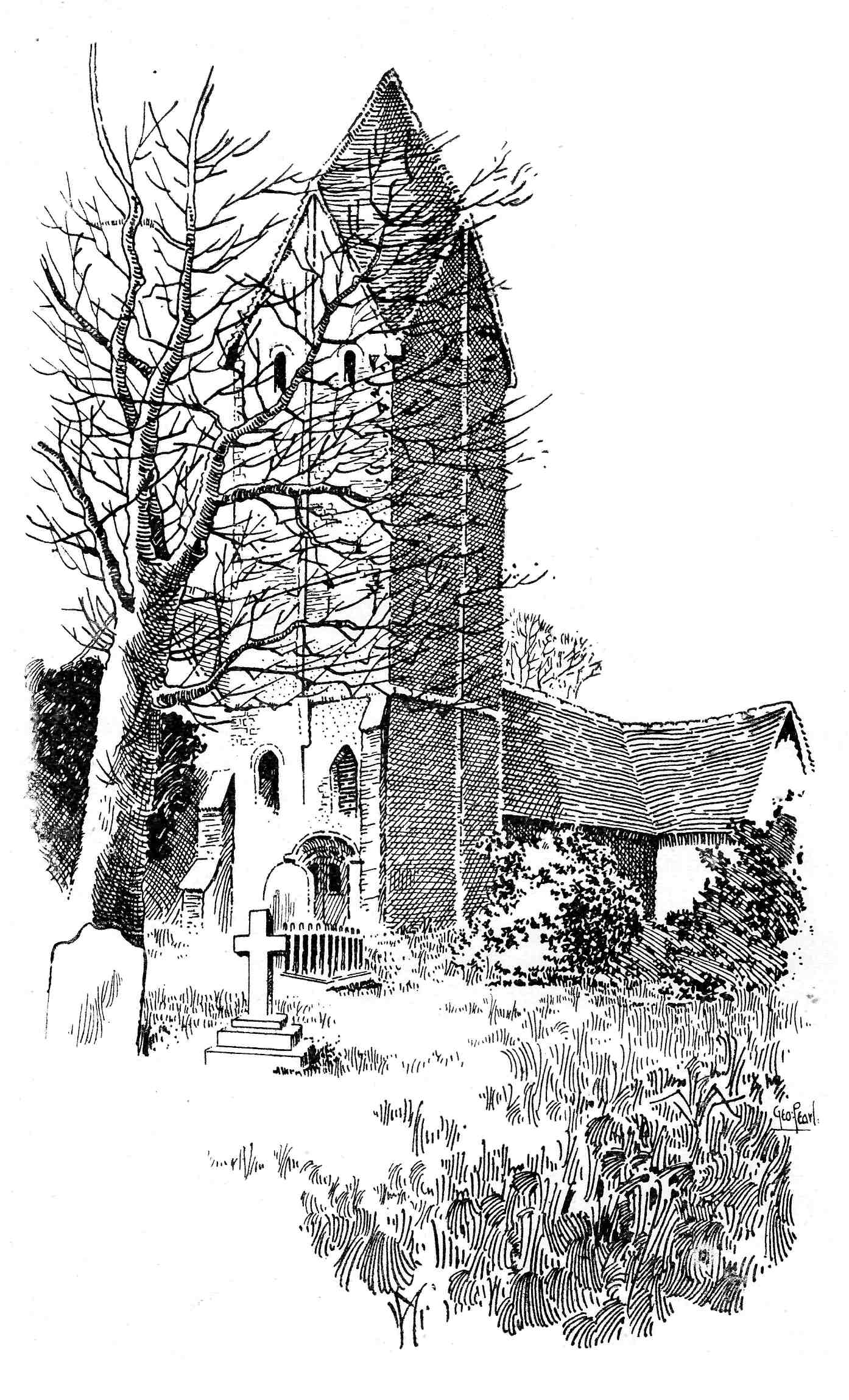
|
| The best example of a Saxon Spire or
Pyramidal Roof. Sompting, Sussex. Drawn by George Pearl. Click to ENLARGE |
Saxon and Norman spires are very rare in England, Sompting being our best example of the former and thoseon the eastern transepts of Canterbury Cathedral of the latter.
[101]Of Early English spires we have, fortunately, some good examples, among which are those at Oxford Cathedral, Wilford and Wansted, in the same county, and a very graceful one at Leighton Buzzard. These 13th century spires are very common in France, as at Chartres and S. Pierre, Caen.
Of fourteenth century, or Decorated, spires, we have many examples, of which perhaps the best is the beautiful spire of Salisbury Cathedral, although the equally fine one at S. Mary's, Oxford, runs it close for premier position. The triple group at Lichfield Cathedral belong to this period, as do the spires of Ross, Heckington, Grantham, S. Mary's, Newark, King's Sutton, Bloxham and Snettisham, Norfolk. A peculiarity of the Salisbury spire is that it never formed part of the original design of the cathedral, being added seventy years later. It is the loftiest spire in England—404 feet—about 40 ft. higher than the cross of S. Paul's. It speaks well for the Gothic builders that such a vast superstructure as this tower and spire could be imposed upon walls and piers never intended to bear it. At an early period it was found to have deflected twenty-three inches from the perpendicular, but there has been no sign of any further movement. Barnack Church, in Northamptonshire, has a curious spire showing the transition from Norman to Early English.
It will be noticed that the sides of a church spire are slightly curved, so that they swell out a little in the centre. This is called the entasis of the spire, and belongs to the study of optics in architecture. Where the spire has no entasis the same effect is produced by the introduction of small projecting gables, bands of carving, or a little coronal of pinnacles.
One of the most clearly marked differences between English and continental spires is that the latter are much shorter than the towers which support them, the towers, as a rule, being twice as high as the spires.[102]

|
| Leighton Buzzard Church. With Early English Tower and Spire. Photograph H. A. Strange. Click to ENLARGE |
In England, on the contrary, the spire is generally very[103] much loftier than the tower. At Shottesbrook, Berks, and Ledbury, Herefordshire, the spires occupy as much as three-fifths of the total elevation, and the usual rule in England is for the tower to be a little less in height than the spire.
The masons lavished an extraordinary amount of care and skill on their spires. So much is this the case that there is hardly a mediæval spire in the country which can be called ill-designed or displeasing.
Church spires are very common in some counties and very rare in others. There are, of course, exceptions, but it is in the flat counties that spires are most frequent, the most beautiful ones being found in Northamptonshire, Leicestershire, Lincolnshire, Warwickshire, Staffordshire, Nottinghamshire and Oxfordshire.
The top of the spire is usually capped with a weather vane terminating in a cock. The custom of using a cock as the flag of the vane is of very early date, for Wolfstan, in his Life of S. Ethelwold, written towards the end of the 10th century, speaks of one which surmounted Winchester Cathedral. In the Bayeux Tapestry one is shown on the gable of Westminster Abbey, and one of the early Popes ordained that every church under the papal jurisdiction should be surmounted by a cock as emblematical of the sovereignty of the church over the whole world.
The use of coloured glass in the windows of buildings devoted to religious purposes appears to have been employed as early as the ninth century, but no examples remain of anything like so old a date, and we have only illuminated missals and primitive drawings by members of the conventual bodies to guide us in determining the earliest styles of coloured glazing. It appears to have consisted of more or less primitive representations of the human form, with strong black lines to indicate the features and folds of the drapery. The backgrounds were generally masses of deep blue or red, and in the rare instances where landscapes were introduced positive colours only appear to have been used. Our oldest specimens in England are those in the choir aisles of Canterbury Cathedral, which appear to be of the 12th century, and it is thought that they are the remains of the original glazing that was put in when this part of the building was rebuilt after a fire in 1174. The general design is composed of panels of various forms, in which are depicted subjects from Holy Scripture, with backgrounds of deep blue or red; the spaces between the panels are filled with mosaic patterns in which blue and red colours predominate, and the whole design is framed in an elaborate border of leaves and scroll-work in brilliant colours.[105]
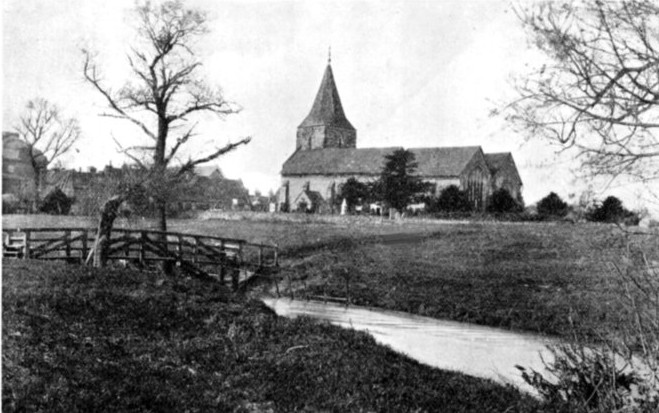
|
| A Parish Church with a Shingle Broach Spire. (See page 99) Edenbridge, Kent. Homeland Copyright. Click to ENLARGE |
[106]Of thirteenth century windows we have some magnificent examples—unfortunately few unmutilated—as at York, where is the five-light lancet window situated in the north end of the transept, known as the Five Sisters of York. Of this date, also, are the large circular window of Lincoln Cathedral, and the windows at Chetwode, Bucks; Westwell, Kent; West Horsley, Surrey; and Beckett's Crown, Canterbury.
A little later, in the Decorated period, we get the great east window of York Cathedral, 75 ft. high and 32 ft. broad; the east window of Gloucester Cathedral, 72 ft. high and 38 ft. broad; and other fine windows at Tewkesbury Abbey; Merton College, Oxford; Wroxhall Abbey, Warwickshire; and the churches of Chartham, Kent; Stanford, Leicestershire; Ashchurch, Glous.; Cranley, Surrey; Norbury, Derbyshire, and others. Salisbury Cathedral has retained portions, but very lovely portions, of the glazing of its west windows, and enough is left to show that it was little inferior to the great windows of York and Gloucester. Carlisle Cathedral, too, has preserved fragments of the original glass in the tracery of the great east window, but the lower part of the glazing is modern. Windows in the Decorated style continued to be arranged in panels, with the spaces between them filled with flowing patterns of foliage, in which the vine and ivy leaves predominate. Single figures are more common than in the previous style, and when used are generally shown beneath a simple pediment or canopy. In the early examples they only occupy a portion of the window light, but later they are found occupying nearly the whole of the surface and are surmounted by large and elaborate canopies. Quarries are much used in this style, sometimes quite plain, but more often with leaves or rosettes painted on them in black lines, or painted with the vine and ivy leaves so arranged that they form a repeating pattern over the whole window. At this period, too, heraldry began to be employed in the decoration of the windows to[107] which it is always an appropriate and artistic adjunct, and many authentic and valuable examples of our national heraldry have thus been preserved for posterity.
With the advent of the Perpendicular style the glazing became more uniform in character, the glass was thinner and lighter, the tints paler, and the whole effect more brilliant and transparent. The paintings for the most part consist of large figures under elaborate canopies, frequently occupying an entire light, and in the patterns and smaller decorations there is a greater freedom of design, and the whole treatment is more harmonious and artistic than in any other period. The use of heraldry became very common, and inscriptions on long narrow scrolls were frequently employed. Among the best examples of this period are the windows at S. Margaret's Church, Westminster; King's College Chapel, Cambridge; Fairford Church, Gloucestershire; and Morley Church, Derbyshire.
The Reformation, with its vast social and political upheaval, was not conducive to the encouragement of the fine arts, and from this period the art of glazing in England declined beyond measure, and was not the only art that received its death-blow in the triumph of Puritanism. The art has, however, revived greatly during recent years, thanks, among other artists, to William Morris and Burne-Jones. A few words must be said about the "Jesse" window found in some of our cathedrals and churches. Strictly speaking, it is a representation of the genealogy of Christ, in which the different persons forming the descent are placed on scrolls of foliage branching out of each other, intended to represent a tree. It was also wrought into a branched candlestick, thence called a Jesse, a common piece of furniture in ancient churches. The subject is found on a window at Llanrhaiadr y Kinmerch, Denbighshire, on the stone work of one of the chancel windows at Dorchester Church, Oxfordshire, and in carved stone on the reredos of Christchurch Priory, Hants.
It is not perhaps generally known that the actual[108] colours used in early stained glass possessed each of them their own specific symbolism. Underlying the obvious story conveyed by the human figures or decorated devices, there was an inner story to be read with profit by those who understood the mystic symbolism concerning colours. Without entering at length into this interesting subject, it may yet be stated that green was the symbol of Regeneration, red of Divine Love, white of Divine Wisdom, yellow of Faith, and grey, or a mixture of black and white, the emblem of Terrestrial Death and Spiritual Immortality. These colours at different times or in different countries had other meanings as well, and ecclesiologists tell us that the colours chosen for depicting the robes of our Lord differ according to the period of His life which it was intended to represent.[109]
The crypts so generally found beneath our cathedrals and abbeys, and so frequently under our churches, rarely extend beyond the choir or chancel and its aisles, and are sometimes of very small dimensions. They are often coeval with the upper parts of the building, and although not so elaborate in ornamentation as the fabric they support, they are almost without exception well constructed and well finished pieces of building. In some cases the crypt is of much older date than any portion of the superstructure, as is the case at York, Worcester and Rochester cathedrals. During the twelfth and thirteenth centuries the roofs were often richly groined, and upheld by cylindrical columns or clustered piers, and furnished with handsome bases and decorated capitals. There is abundant evidence that crypts were at one time furnished with altars, piscinas, and the various fittings requisite for the celebration of the mass, and they were used as sepulchres, wherein the shrines of relics and martyrs were carefully preserved. Some authorities claim a purely Saxon origin for the crypts at Ripon Cathedral, Hexham Abbey, and Repton Church, Derbyshire. The Ripon example is a plain barrel-vaulted chamber, about 11 ft. long and 8 ft. wide, with no pillars or ornament of any kind. It is popularly known as S. Wilfrid's Needle, but the exact origin of the name is lost in obscurity. The Hexham crypt is very similar in character, but is somewhat longer, being more than 13 ft. long and 8 ft. wide. As at Ripon, there are hollows or shallow niches in the walls in which lamps may possibly have been placed. The third reputed Saxon crypt is that at Repton, but it has little in common with the other two, its superficial area being nearly twice as great and the roof is supported on four columns, with plain square capitals rudely carved, and bearing much similarity to early Norman work.
The position of the crypt varies. At Beverley Minster[110] it is on the south side of the south-west tower; in Hereford Cathedral it is under a side chapel, while at Lastingham, in Yorkshire, the crypt extends under the whole of the church, including the apse. At Wells the crypt is beneath the chapter-house, and Durham Cathedral has three crypts, one under what was the dormitory, another beneath the refectory, and the third under the prior's chapel. Of crypts of Norman date we have many examples, of which, perhaps, our best are those at Gloucester, Worcester, Canterbury and Winchester Cathedrals, while Canterbury is probably the largest of them all. Good crypts are also found at Wimborne Minster, Christchurch Priory, and in our smaller churches at Repton and S. Peter's-in-the-East, Oxford.
The Wimborne crypt is lighted by four windows. The vaulting is supported by two pairs of pillars which form three aisles, each of three bays. Mr. Perkins, in his book on Wimborne Minster, says, "On each side of the place where the altar stood there are two openings into the choir aisles. The exteriors of these are of the same form and size as the crypt windows, but they are deeply splayed inside, and probably were used as hagioscopes or squints, to allow those kneeling in the choir aisles to see the priest celebrating mass at the crypt altar." The crypt at Christchurch is of Norman date, and now serves as a vault for the Malmesbury family. The crypt of Canterbury Cathedral is claimed and justly claimed, perhaps, as the largest and most beautiful in England. It is thought to contain fragments of Roman and Saxon work, and much of it dates from the days of S. Anselm (1096-1100). It was here that the remains of S. Thomas à Becket lay from 1170 to 1220, and "here that Henry II., fasting and discrowned, with naked feet, bared back, and streaming tears, performed on July 12th, 1174, the memorable penance for his share in the murder of the great Archbishop."
It was here too, in later times that the Walloons were granted, by Queen Elizabeth, the privilege of carrying on their silk-weaving, and it was also reserved as a place of worship for French Protestants.[111]
Having carefully read the foregoing chapters, it should be possible for anyone interested in the subject to be able to write a fairly accurate description of any old church. The record should, if possible, be amplified with sketches or photographs.
In course of time, decay, neglect and restoration will deprive our ancient buildings of every visible stone of original work which they possess, and careful records of this kind, written, photographed and sketched, may be of the highest possible value to future generations of historians and architects, long after the objects themselves have ceased to exist. The work in itself is of absorbing interest, and the more one studies these works of past ages the stronger becomes the conviction that our old buildings, whether cathedral, castle or simple village church, are the landmarks of the nation's history, and a priceless inheritance of beauty and art the conservation of which is the duty of all generations.
The principal points to be noted are—1. The name of the church. 2. Its situation. 3. Its dedication. 4. General plan. 5. The style of architecture to which each portion belongs. 6. Any peculiarity of the architecture, blocked up windows, etc. 7. Any ancient[112] furniture, screens, bench-ends, glass. 8. Any monuments, tablets, or mural paintings. 9. Church plate, bells, registers. 10. Any local traditions. The record should be made somewhat in the following manner.
The church of — — is prettily situated on rising ground some quarter of a mile north of the village, and on the main road to — — . It is approached by a picturesque timber lych-gate, and consists of nave, aisles and chancel, having a side chapel to the north and a single transept to the south. At the west end is a Decorated tower and spire. There are two porches, one on the north side and the other on the west, which last has a niche for a figure over the doorway and seats on either side. The nave is Perpendicular, as is the greater part of the rest of the fabric. Above the nave rises a lofty and noble clerestory, divided from the aisles by five rather obtusely-pointed arches supported by richly moulded piers with small moulded capitals. Each bay of the clerestory contains two three-light windows of late Perpendicular date. The roof is flat pitched and is of oak, the principals are adorned with panelled tracery and show vestiges of ancient colour decoration. The windows of the aisles are late Decorated in style; they are of three lights, the traceries elegant and richly moulded. The east window is Perpendicular and is much sub-divided by mullions and transoms; in the upper portions are some heraldic coats of arms, which appear to have formed part of a much earlier window. The chancel is divided from the nave by a fine open oak screen, coeval with the larger part of the building. It is richly carved and gilded, and in the right-hand side of the chancel arch are the steps which formerly led up to the top of it. The chancel, together with its chapel, is vaulted in stone with well marked ribs and carved bosses. The transept, late Perpendicular, opens into the south side of the nave by a four-centred arch, and has a rich flat ceiling. In the chancel is a piscina of Early English date, together with a sedilia of the same period. On the north side of the chancel, resting on the floor, is a cross-legged effigy, in chain mail, surcoat, etc.,[113] and bearing on his left arm a shield, but all much mutilated. There is a local tradition that it represents Sir ——, but there is no evidence by which he can be identified. Features of the church are the many highly carved bench ends, all in oak, representing a great variety of subjects, such as dragons, serpents, etc., while a few bear the arms of local families who probably bore the cost of the work. The pulpit is Jacobean, and has no special feature. The font, which stands in the centre of the nave, is square in form and is supported by a modern round plinth. It is constructed of marble, the four sides being carved in low relief with intersecting patterns. It is possibly of Norman date, and is the only existing feature of a much earlier church. The tower and spire are Decorated; the latter is of stone with four pinnacles at the base, and has a little coronal of pinnacles. The belfry windows are arranged in pairs on each side of the tower. The tower or western window is of five lights, richly Decorated in style.[114]
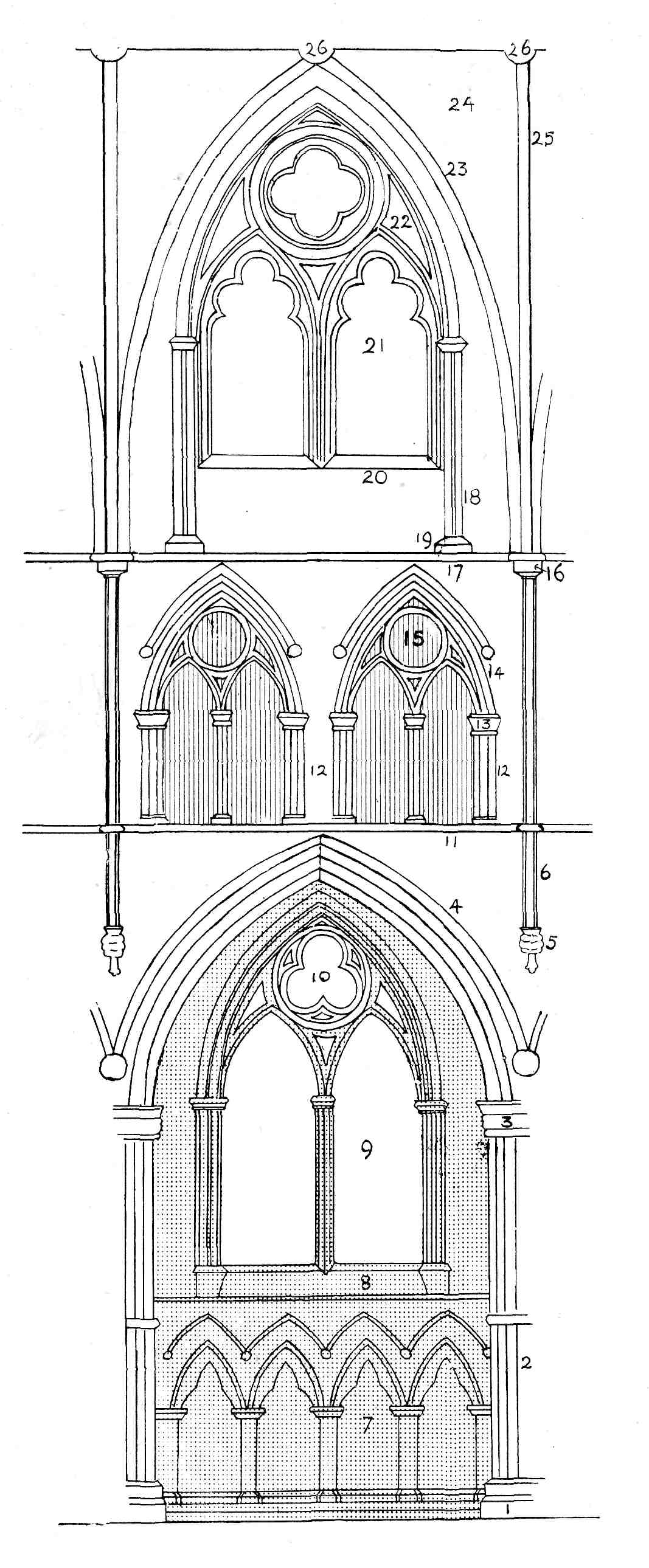
| Key to Diagram of the |
A GLOSSARY OF THE PRINCIPAL TERMS USED
IN ECCLESIASTICAL ARCHITECTURE.
| ABACUS | Derived from the Greek Abax—a tray or flat board, an essential feature of the Grecian and Roman orders, but now used to describe the slab forming theupper part of a column, pier, etc. |
| ABBEY | A term for a union of ecclesiastical buildings, for the housing of those conventual bodies presided over by an abbot or abbess, supposed to be derived from the Hebrew ab, "father." |
| ACANTHUS | A plant, the leaves of which are represented in the capitals of the Corinthian orders. |
| AISLE | French aile, a wing, the lateral division of a church. |
| ALMONRY | A room where alms were distributed. |
| ALTAR | An elevated table dedicated to the Sacrament of the Holy Eucharist, and usually called the Communion Table. |
| ALMERY, AUMERY, and AUMBREY | A recess or small cupboard in the wall of a church, used to contain the chalices, patens, etc., for the use of the priest. They are sometimes near the piscina, but are usually on the opposite side of the chancel. |
| ANTE-CHAPEL | The outer part of a chapel. |
| APSE | The semi-circular or polygonal recess at the east end of the choir or aisles of a church. |
| ARCADE | A series of arches, open or closed with masonry, and supported by columns or piers. |
| ARCH | A construction of bricks or stones so placed as by mutual pressure to support each other and a superincumbent weight. They may be semi-circular, segmental, elliptical, stilted, horse-shoe, pointed, trefoiled, cinquefoiled, or ogee116 |
| ARCHITRAVE | In classical architecture, the lowest division of the entablature resting immediately on the abacus of the capital. In Gothic buildings the ornamental mouldings round the openings of doors, windows, etc. |
| ARCHIVOLT | The under surface of the curve of an arch, from impost to impost. |
| ASHLAR | Shaped or squared stone used in building, as distinguished from that in the rough. |
| ASTRAGAL | A small semi-circular bead or moulding. |
| BALL FLOWER | An ornament resembling a ball in a circular flower with three enclosing petals. Dec. |
| BASE | The lower member of a column, pier, or wall. |
| BASILICA | A Roman law-court. Early Christian churches when built on the same lines were called by the same name. |
| BILLET | An ornament much used in Norman work and formed by cutting a moulding in notches, so that the remaining parts resembled wooden billets or pieces of stick. |
| BLIND STOREY | See Triforium. |
| BOSSES | Ornamental projections usually of foliage and placed at the intersection of the ribs of vaults, ceilings, etc. |
| BRACES | Timbers which brace or support the main rafters. Also called struts. |
| BROACH | A spire, generally octagonal and springing from the square top of the tower, without a parapet. (See page 105). |
| BUTTRESS | A projection from a wall, giving it additional strength. |
| CANOPY | In Gothic architecture an ornamental hood or projection over doors, windows, niches, tombs, etc., and rarely found except in the Dec. and Perp. styles. |
| CAPITAL | The head of a column or pilaster, found in a great variety of shapes. |
| CATHEDRAL | A church presided over by a Bishop. The principal church of a diocese. |
| CHALICE | The cup used for the wine at the celebration of the Eucharist. |
| CHAMFER | The surface formed by cutting away the rectangular edge of wood or stone work. |
| CHANCEL | The choir or eastern part of a church, appropriated to the use of those who officiate in the performance of the services. |
| CHANTRY | A chapel often containing a tomb of the founder, and in which masses were said.[117] |
| CHAPEL | A small building attached to cathedrals and large churches. |
| CHAPTER-HOUSE | The room where the Dean and Prebendaries meet for the transaction of business. |
| CHEVRON | An ornament characteristic of the Norman period and divided into several equal portions chevron-wise or zig-zag. |
| CHOIR | That part of a church to the east of the nave where the services are celebrated, also called chancel, and frequently separated from the nave by an open screen of stone or wood. |
| CINQUEFOIL | An ornamental foliation used in arches, tracery, etc., and composed of projecting points or cusps, so arranged that the opening resembles five leaves. |
| CLERESTORY | Possibly the clear storey. An upper storey standing above or clear of the adjacent roofs, and pierced by windows to give increased light. |
| CLOISTER | A covered walk or ambulatory forming part of a cathedral or college quadrangle. |
| CLUSTERED COLUMN | A pier made up of several columns or shafts in a cluster. |
| COLONNADE | A row or rows of columns supporting a roof or building |
| CORBEL | Usually a moulded or carved ornament projecting from the walls, acting as a bracket and capable of bearing a super-incumbent weight. |
| CORNICE | The horizontal termination of a building in the form of a moulded projection. |
| COURSE | A continuous and regular line of stones or bricks in the wall of a building. |
| CROCKETS | Projecting ornaments in the form of leaves, flowers, etc., used to embellish the angles of pinnacles, spires, gables, canopies, etc. |
| CROSS | The accepted symbol of the Christian religion and an architectural church ornament usually placed upon the apex of the gable. A large cross called a rood was at one time always placed over the entrance to the chancel. The cross was worn as a personal ornament ages before the Christian era by the Assyrians, and we are told that the Druids also used this symbol in very early times. |
| CRYPT | Sometimes called the Undercroft, a vaulted chamber, usually underground and in, churches, rarely extending beyond the area of the choir or chancel, and often of less dimensions.[118] |
| CUSPS | Projecting points giving the foliated appearance to tracery, arches, panels, etc. |
| DORMER | A gabled window pierced through a sloping roof. |
| DRIPSTONE | A projecting ledge or narrow moulding over the heads of doorways, windows, etc., to carry off the rain. |
| FAN-TRACERY | Tracery in which the ribs form a fan-like appearance and diverge equally in every direction. (Peculiar to the late Perp.) |
| FLAMBOYANT | Tracery whereof the curves assume flame-like waves and shapes. |
| FLYING BUTTRESS | A buttress in the form of a bridge, usually transferring the thrust of the main roof from the clerestory walls to the main or aisle buttresses |
| FONT | The vessel for holding the consecrated water used in baptism. |
| GARGOYLE | A projecting spout usually grotesquely carved and used to throw the water from the roof well away from the building. |
| GROIN | The line of intersection in vaulted roofs. |
| IMPOST | Horizontal mouldings, capping a column or pier, from which the arch springs. |
| JAMB | The side of a window or door. |
| KEYSTONE | The central stone at the top of an arch. The bosses in vaulted ceilings are frequently called keys. |
| LADY CHAPEL | A chapel dedicated to the Blessed Virgin Mary, called "Our Lady." |
| LANTERN | A small structure or erection surmounting a dome or tower to admit light. These towers are known as Lantern Towers. |
| LOZENGE | A name given in modern times to Norman mouldings which partake of a lozenge formation. |
| LYCH-GATE | From the Anglo-Saxon lich, a corpse. A small and often picturesque shelter at the entrance to a churchyard. |
| MINSTER | The church usually of a monastery or abbey or one to which such has been an appendant. York and Beverley, however, are exceptions to this rule. |
| MISERERE | A small bracket on the undersides of the seats of stalls.[119] |
| MOULDING | A term generally applied to the contours given to angle projections or hollows of arches, doors, windows, etc. |
| MULLION | The dividing bars of stone or wood between the lights of windows, or the openings of screens. |
| MÜNSTER (MONASTERY) | has now lost its simple application. |
| NAVE | From navis, a ship, the main body of a church west of the chancel. |
| NICHE | An alcove or recess in a wall for holding a statue or ornament. |
| OGEE | A moulding or arch formed of a curve or curves somewhat like the letter S, the curve of contra-flexure, part being concave and part convex. |
| ORDERS | In Gothic architecture, the receding mouldings of an arch. |
| PARCLOSE | The screen or railings protecting a monument or chantry. |
| PARVISE | An open space or porch at the entrance to a church, and often wrongly applied to the room over a church porch. |
| PATEN | The small plate or salver used to hold the Consecrated Bread in the celebration of the Eucharist. |
| PENDANT | Ornaments which hang or depend from a ceiling or roof. |
| PENTHOUSE | A covering projecting over a door, window, etc., as a protection from the weather. |
| PIER | The masses or clusters of masonry between doors, windows, etc.; the supports from which arches spring. |
| PILLAR | A term frequently confounded with column, but differing from it in not being subservient to the rules of classical architecture, and in not of necessity consisting of a single circular shaft. |
| PINNACLE | A small turreted ornament tapering towards the top, and used as a termination to many parts of Gothic architecture. |
| PISCINA | The stone basin or sink in the chancel used for cleansing the communion vessels. |
| PLINTH | The lower division of the base of a column, pier or wall. |
| POPPY-HEAD | An ornament boldly carved on the tops of bench ends, etc. |
| PRESBYTERY | A term sometimes used to include the whole of the choir, but more often meant to refer to the eastern end of the choir from which it is generally raised by several steps.[120] |
| QUARRIES or QUARRELS | The small diamond, square or other shaped panes used in plain glazing. |
| QUATREFOIL | The shape resembling four leaves formed in tracery or panels by cusps. |
| QUOIN | The external angle of a building, generally of ashlar. |
| REREDOS | The wall or screen at the back of an altar, often enriched with carving, niches, statues, etc. |
| ROOD-BEAM or ROOD-LOFT | The loft or beam which, previous to the Reformation, supported the Great Rood, or Crucifix. |
| ROSE WINDOW | A term often used to denote a circular window of several lights. |
| ROTUNDA | A term used to describe a church or other building which is of circular formation both within and without. |
| SACRISTRY | A room used in churches for storing the plate and valuables. |
| SANCTUARY | See Presbytery. |
| SEDILIA | A seat or seats, generally canopied and situated on the south side of the chancel and used in pre-Reformation days by the officiating clergy during the pauses in the mass. |
| SHAFT | The part of a column or pillar between the capital and the base. |
| SHRINE | Often called the feretory. The place where relics were deposited. |
| SOFFIT | The word means literally a ceiling, but is generally used to describe the flat under-surface of arches, cornices, stairways, etc. |
| SPANDRELS | The spaces between the arch of a doorway or window and the rectangular mouldings over it. Early tracery originated from the piercing of the spandrels of windows. |
| SPIRE | The acutely pointed termination of towers, etc., originating by the elongation of the early pyramidal roofs. |
| SPLAY | The slanting or sloped surface of a window opening in the thickness of the wall, also of doorways, etc.; the term is also applied to bevels and other sloped surfaces. |
| SPRINGER | See Voussoir.[121] |
| SQUINT | An oblique opening or slit in the wall of a church, for the purpose of enabling persons in the aisles or transepts to see the elevation of the Host at the High Altar. They are mostly found on the sides of the chancel arch, and are frequently called hagioscopes. |
| STOUP | A vessel for consecrated water, at or near the entrance to a church. |
| STRING or STRING COURSE. | A horizontal projecting band of stone in the wall of a building. |
| STRUT | See Brace. |
| TOOTH ORNAMENT | An ornament used almost exclusively in the E.E. style, resembling a square four-leaved flower, and thought to be based on the dog-tooth violet. |
| TRANSOM | A horizontal cross-bar in a panel or window. |
| TRACERY | The ornamental stonework in the upper part of a window; when formed by the mullions it is called bar tracery and when the spandrel is pierced, plate tracery. Also used largely on tombs, screens, doorways, etc. |
| TRANSEPTS | The projecting arms of a cruciform church, often wrongly called "cross-aisles." |
| TRANSITION | A term used to describe the process of change from one style of architecture to another. The three great periods of transition are from the Romanesque and Norman to the Early English; the Early English to the Decorated, and the Decorated to the Perpendicular. |
| TREFOIL | An ornamental foliation in the heads of windows, panels, etc., in which the spaces formed by the cusps resemble three leaves. |
| TRIFORIUM | or Blind-Storey. An open gallery arcade without windows immediately above the pier arcade and under the roof of the aisle. |
| TYMPANUM | The space between the top of a square-headed door and the arch above it; frequently sculptured. |
| VAULT | Roofing of stone constructed on the principle of the arch, the intersections of which are termed groins and are in the pointed styles usually ribbed. |
| VAULTING SHAFTS | Small shafts sometimes rising from the floor, sometimes from the capital of a pillar and sometimes from a corbel, and intended as supports for the ribs of a vault.[122] |
| VESICA PISCIS | An oval shape or figure formed by two equal circles cutting each other in their centres. Very commonly found on episcopal and monastic seals. |
| VOUSSOIR | The wedge-shaped stones forming an arch, the centre one of which is the keystone and those at the impost or starting point of the curve are the springers. |
| ZIG-ZAG | See Chevron. |
| Adeline, J. | Art Dictionary of Terms. |
| Bland, W. | Arches, Piers, Buttresses, etc. |
| Blomfield, R. | Short History of Renaissance Architecture. |
| Bond, Francis | English Cathedrals Illustrated. |
| Bond, Francis | Gothic Architecture in England. |
| Bonney, T. G. | Cathedrals, Abbeys, and Churches of England and Wales. |
| Carter, J. | The Ancient Architecture of England. |
| Colling, J. K. | Details of Gothic Architecture. |
| Corroyer, E. | Gothic Architecture. |
| Cram, R. Adams | Church Building. |
| Davidson, E. A. | Gothic Stonework. |
| Fergusson, J. | Handbook of Architecture. |
| Fergusson, J. | History of Architecture. |
| Fairbairns, A. | Portfolio of English Cathedrals. |
| Garbett, E. L. | Principles of Design in Architecture. |
| Markland, J. H. | Remarks on Churches. |
| Moore, C. H. | Development and Character of Gothic Architecture. |
| Paley, F. A. | Manual of Gothic Architecture. |
| Paley, F. A. | Manual of Gothic Mouldings. |
| Parker, J. H. | A.B.C. of Gothic Architecture. |
| Parker, J. H. | Concise Glossary of Architecture. |
| Parker, J. H. | Introduction to the Study of Gothic Architecture. |
| Perkins, Rev. T. | Handbook of Gothic Architecture. |
| Prior, Ed. S. | History of Gothic Art. |
| Pugin, A. W. | Treatise on Chancel Screens and Rood Lofts. |
| Rickman, Thos. | Gothic Architecture. |
| Rickman, Thos. | Attempts to discriminate the Styles of Architecture in England. |
| Sharpe, Edmund | The Seven Periods of English Architecture. |
| Sharpe, Edmund | Treatise on the Rise and Progress of Window Tracery. |
| Scott, G. | History of Church Architecture. |
| Ruskin, John | Seven Lamps of Architecture |
| Ruskin, John | Stones of Venice. |
| Ruskin, John | Poetry of Architecture. |
| Ruskin, John | Lectures on Architecture |
| Wall, J. C. | Shrines of British Saints. |
| Winkle | British Cathedrals. |
| Wilson, S. | Romance of our Ancient Churches. |
| Bell's Cathedral Series. | |
| "The Builder" Portfolio of English Cathedrals. | |
| Murray's Handbooks to the Cathedrals. | |
| S.P.C.K. Illustrated Notes on English Church History. Swan, Sonnenschein & Co. Notes on the Cathedrals. "Our English Minsters." Edited by Dean Farrar. | |
This bibliography does not claim to be complete, but is a selection of the various books on the subject which should be studied by the student.[124]
| A | |
| All Souls' College, Oxford, | 76 |
| Altars, | 80 |
| Alveston Church, Warwickshire, | 41 |
| Amiens Cathedral, | 57 |
| Anne, Queen, | 76 |
| Apse, The, | 27 |
| Arches— | |
| Saxon, | 35 |
| Norman, | 37 |
| Early English, | 49 |
| Decorated, | 62 |
| Perpendicular, | 66 |
| Ashchurch, Gloucestershire, | 106 |
| B | |
| Baptistery, The, | 84 |
| Barfreston Church, Kent, | 39, 41 |
| Barnack Church, Northants | 32, 33, 34, 101 |
| Barnstaple, Devon, | 98 |
| Barnwell, | 92 |
| Barry, Sir C., | 78, 79 |
| Basilica, The, | 26 |
| Bayeux Tapestry, | 41, 103 |
| Beaulieu, Hants, | 90 |
| Beckett's Crown, Canterbury, | 106 |
| Bede (quoted), | 21, 23, 96 |
| Bells and Belfries, | 95 |
| Bench Ends, | 89 |
| Bertha, Queen, | 23 |
| Beverley Minster, | 109 |
| Billesley Church, Warwickshire, | 78 |
| Bishopstone, Sussex, | 32 |
| Bloxham Church, | 101 |
| Boston, Lincs, | 72 |
| Bovey Church, | 92 |
| Bradford-on-Avon, | 32 |
| Brewer, J. W. (quoted), | 28 |
| Brighton Pavilion, | 78 |
| Brigstock Church, Northants, | 97 |
| Bristol Cathedral, | 70 |
| British Churches, Early, | 19 |
| Brixworth Church, | 28, 32, 33, 97 |
| Broadmayne Church, | 86 |
| Bruton, Som., | 97 |
| Burne-Jones, Sir E., | 107 |
| Bury St. Edmunds, | 82 |
| Buttresses— | |
| Norman, | 43 |
| Early English, | 84 |
| Decorated, | 62 |
| Perpendicular, | 70 |
| Byzantium, | 27 |
| C | |
| Canterbury Cathedral, | 43, 94, 101, 104, 110 |
| Capitals— | |
| Norman, | 42 |
| Early English, | 54 |
| Decorated, | 60 |
| Perpendicular, | 69 |
| Caradoc, King, | 19 |
| Carlisle Cathedral, | 60, 106 |
| Charles II., | 76 |
| Charlton-on-Otmoor, | 92 |
| Charlton Church, Kent, | 106 |
| Chartres Cathedral, | 101 |
| Chetwode, Bucks, | 106 |
| Chichester Cathedral, | 97 |
| Chipping Norton, Oxford, | 81 |
| Christchurch Priory, | 88, 94, 107, 110 |
| Christ Church, Spitalfields, | 76 |
| Chudleigh Church, Devon, | 92 |
| Church Furniture and Ornaments, | 80 |
| Cirencester Church, Glos., | 70 |
| Classic Reverse, The, | 70 |
| Clerkenwell, | 44 |
| Collumpton, Devon, | 92 |
| Compton Church, | 94 |
| Constantine, Emperor, | 27 |
| Constantinople, | 27 |
| Cranley, Surrey, | 106 |
| Crawden's Chapel, | 58 |
| Croyland Abbey, | 96 |
| Crypts, | 109 |
| Curfew, | 96 |
| D | |
| Decorated Style, The, | 57 |
| Doisnel, Juliana, | 44 |
| Dolton Church, | 84 |
| Doorways— | |
| Saxon, | 30, 32 |
| Norman, | 39 |
| Early English, | 54 |
| Decorated, | 62 |
| Perpendicular, | 69 |
| Dorchester Church, Oxford, | 107 |
| Dore Abbey, | 81 |
| Dunstable, | 92 |
| Dunster Church, | 81, 92 |
| Durham Cathedral, | 43, 73, 82, 94, 112 |
| E | |
| Earl's Barton Church, | 32, 33 |
| Early English Style, The, | 47 |
| East Dereham, | 97 |
| Edburton Church, | 84 |
| Edington Church, Wilts, | 72 |
| Edington, Bp. William, | 72 |
| Edmund, Archbp. of Cant., | 84 |
| Edward I., | 49 |
| Edward III., | 84 |
| Elizabeth, Queen, | 81, 110 |
| Eltham Palace, | 73 |
| Ely Cathedral, | 29, 43, 57 |
| Ely Chapel, | 60 |
| Ethelbert, King of Kent, | 23 |
| Euston, Oxford, | 94 |
| Evesham Abbey, | 73, 97 |
| Exeter Cathedral, | 89 |
| F | |
| Fairford Church, Glos., | 107 |
| Fan Vaulting, | 69 |
| Fergusson, Dr. (quoted), | 75 |
| Flying Buttresses, | 56 |
| Fonts, | 84 |
| Fordington S. George, Dorchester, | 41 |
| Fotheringay Church, Northants, | 73 |
| Fountains Abbey, | 47 |
| Fuller, Thos. (quoted), | 19 |
| Furness Abbey, | 87 |
| Furniture, Church, | 80 |
| G | |
| Glass, Stained, | 104 |
| Glastonbury Abbey, | 19, 97 |
| Glossary, | 115 |
| Gloucester Cathedral, | 43, 73, 94, 106, 110 |
| Gothic Architecture,
Leading Characteristics, | 63 |
| Gothic Styles, The, | 47 |
| Grantham, | 101 |
| Greenstead Church, Essex, | 32, 34, 35 |
| Grosmont, Monmouth, | 81 |
| H | |
| Hackness, | 96 |
| Hanwell, Oxford, | 94 |
| Hartland Church, | 92 |
| Hawkesmore, | 76 |
| Heckington, | 86, 101 |
| Heigham, | 72 |
| Henry I., | 44 |
| Henry II., | 49 |
| Henry III., | 44, 48, 49 |
| Hereford Cathedral, | 57, 110 |
| Hexham, | 82, 109 |
| Hutchinson, Rev. J. M. (quoted), | 49 |
| I | |
| Iffley Church, Oxford, | 39 |
| J | |
| Jenkyns, Canon (quoted), | 25 |
| John, King, | 44, 48, 49 |
| Jones, Inigo, | 75, 78 |
| K | |
| Kemsing, Kent, | 92 |
| Kenton Church, Devon, | 90, 92 |
| King's College Chapel, Cambridge, | 107 |
| King's Sutton, | 101 |
| Knights Hospitallers, | 44 |
| Knights Templars, | 43 |
| L | |
| Lady Chapel, Exeter, | 60 |
| Langham Place, | 78 |
| Lastingham Church, York, | 110 |
| Laud, Archbishop, | 16 |
| Ledbury, Hereford, | 103 |
| Leighton Buzzard, | 101 |
| Lichfield, Abbot, | 97 |
| Lichfield, Cathedral, | 57, 101 |
| Lincoln Cathedral, | 43, 52, 57, 63, 81, 106 |
| Little Billing, | 84 |
| Little Maplestead, | 44 |
| Llanrhaiadr-y-Kinmerch, | 107 |
| Luidhard, Bishop, | 23 |
| Long Melford Church, Suffolk, | 73 |
| Long Sutton, | 92 |
| Luton Church, | 58 |
| Lyminge, | 25 |
| M | |
| Magdalen College, Oxford, | 90 |
| Malmesbury (family), | 110 |
| Manchester Cathedral, | 73, 88 |
| Markland (quoted), | 97 |
| Mary, Queen, | 81, 92 |
| Marylebone Church, | 78 |
| Melbury Bubb, | 84 |
| Merton College, Oxford, | 58, 60, 106 |
| Minehead, | 92 |
| Morley Church, Derbyshire, | 107 |
| Morris, William, | 107 |
| Morton Church, Soms., | 73 |
| Mouldings— | |
| Norman, | 37 |
| Early English, | 52 |
| Decorated, | 62 |
| Perpendicular, | 69 |
| N | |
| Newark, Notts., | 92 |
| New College, Oxford, | 72 |
| Norbury, Derbyshire, | 106 |
| Norman Architecture, | 35 |
| Norwich Cathedral, | 29, 43 |
| O | |
| Ornaments— | |
| Norman, | 37 |
| Early English, | 52 |
| Decorated, | 60, 62 |
| Perpendicular, | 68, 69, 70 |
| Ornaments, Church, | 80 |
| Oxford Cathedral, | 43, 101 |
| P | |
| Palladio, | 74, 75 |
| Parham, | 84 |
| Parker (quoted), | 31, 35, 88 |
| Parliament, Houses of, | 78 |
| Patrixbourne Church, Kent, | 41 |
| Perkins, Rev. T. (quoted), | 110 |
| Perpendicular Styles, | 64 |
| Perpendicular Towers, | 72 |
| Perpendicular Spires, | 73 |
| Peterborough Cathedral, | 29, 43, 57 |
| Philippa, Queen, | 84 |
| Piscinas, | 87 |
| Piers— | |
| Norman, | 42 |
| Early English, | 54 |
| Decorated, | 60 |
| Perpendicular, | 68 |
| Plymtree, | 92 |
| Pointed Arch, The, | 49 |
| Porches, | 53 |
| Porlock Church, Somerset, | 81 |
| Pugin, | 78, 79 |
| Pulpits, | 90 |
| Pyecombe, | 84 |
| Pylle Church, | 86 |
| R | |
| Radipole Church, Dorset, | 98 |
| Ravenna, | 33 |
| Reculver, | 25 |
| Reform Club, | 79 |
| Renaissance, The, | 74 |
| Repton Church, Derby, | 109, 110 |
| Reredos, The, | 94 |
| Richard I., | 48, 49 |
| Richborough, | 25 |
| Rickman (quoted), | 35 |
| Ripon Cathedral, | 32, 109 |
| Rievaulx, | 47 |
| Rochester Cathedral, | 42, 57, 109 |
| Rolvenden Church, Kent, | 86 |
| Romanesque Style, The, | 27 |
| Rome, | 33 |
| Ross, | 101 |
| Rotherham Church, Yorks., | 70 |
| Rothwell Church, | 87 |
| Round Churches, The, | 44 |
| Routledge, Rev. C. F., M.A., F.S.A., | 24 |
| S | |
| Saffron Walden, | 73 |
| Saint Alban's Cathedral, | 54, 94 |
| Saint Andrew's, Norwich, | 73 |
| Saint Anselm, | 110 |
| Saint Augustine, | 19 |
| Saint Benet's, Cambridge, | 32 |
| Saint Chad's Cathedral, Birmingham, | 79 |
| Saint Clement's, Norfolk, | 73 |
| Saint Cross, Winchester, | 39 |
| Saint David's, Cathedral, | 57, 73 |
| Saint Dunstan, | 96 |
| Saint Edmundsbury, | 97 |
| Saint Edmund, Martyr, | 35 |
| Saint Etheldreda, | 58 |
| Saint Ethelwold, | 103 |
| Saint Giles', Oxford, | 81 |
| Saint Hilda, | 96 |
| Saint Lawrence, Bradford-on-Avon, | 32, 33 |
| Saint Margaret's, Westminster, | 107 |
| Saint Mark's, Venice, | 28 |
| Saint Mary Abchurch, | 76 |
| Saint Mary Magdalene, Ripon, | 81 |
| Saint Mary Redcliffe, Bristol, | 73 |
| Saint Mary's, Cambridge, | 73 |
| Saint Mary's, Dover, | 22 |
| Saint Mary's, Lincoln, | 32 |
| Saint Mary's, Luton, | 84 |
| Saint Mary's, Newark, | 101 |
| Saint Mary's, Norwich, | 73 |
| Saint Mary's, Ottery, | 92 |
| Saint Mary's, Oxford, | 73, 101 |
| Saint Mary's, Stamford, | 92 |
| Saint Mary's, Taunton, | 73 |
| Saint Mary's, Wareham, | 81, 84 |
| Saint Mary's, Woolnoth, | 76 |
| Saint Mary's, York, | 32 |
| Saint Martin's, Canterbury, | 22 |
| Saint Martin's, Wareham, | 32 |
| Saint Michael's, Coventry, | 73 |
| Saint Michael's, Oxford, | 32, 34, 94 |
| Saint Nicholas, Lynn, | 73 |
| Saint Nicholas, Newcastle, | 73 |
| Saint Nicholas, Yarmouth, | 63 |
| Saint Paul the Apostle, | 19 |
| Saint Paul's Cathedral, | 75, 76, 101 |
| Saint Paul's Churchyard, | 90 |
| Saint Patrick, | 21 |
| Saint Peter Port, Guernsey, | 98 |
| Saint Peter's in the East, Oxford | 110 |
| Saint Peter's, Lincoln, | 32 |
| Saint Peter's, Norwich, | 73 |
| Saint Peter's, Rome, | 75, 76 |
| Saint Pierre, Caen, | 101 |
| Saint Piran's, Perranporth, | 21 |
| Saint Saviour's, Dartmouth, | 90, 92 |
| Saint Saviour's, Southwark, | 94 |
| Saint Sepulchre, Cambridge, | 44 |
| Saint Sepulchre, Northampton, | 44 |
| Saint Sophia, Constantinople, | 28 |
| Saint Stephen's, Bristol, | 73 |
| Saint Stephen's Chapel, Westminster, | 58 |
| Saint Stephen's, Walbrook, | 76 |
| Saint Thomas à Becket, | 110 |
| Saint Wilfrid's Needle, | 109 |
| Saint Wolfstan, | 103 |
| Salisbury Cathedral, | 47, 57, 101, 106 |
| Sanctuary Knockers, | 82 |
| Saxon Architecture, | 31 |
| Saxon Churches, | 32 |
| Scott (quoted), | 31 |
| Screens, | 92 |
| Sedilia, | 87 |
| Shottesbrook Church, Berks, | 66, 103 |
| Shrewsbury, | 90 |
| Silchester, | 25 |
| Snettisham, Norfolk, | 101 |
| Solihull, Warwickshire, | 94 |
| Sompting, Sussex, | 32, 99 |
| Southwell, | 57, 87 |
| Southwold Church, Suffolk, | 73 |
| Speyer Cathedral, | 29 |
| Spires, | 73, 99 |
| Squints, | 90 |
| Stalls, | 88 |
| Stanford, Leicester, | 106 |
| Stone Church, Kent, | 54 |
| Stoups, | 86 |
| T | |
| Temple Balsall, | 44 |
| Temple Church, London, | 44 |
| Tenby, | 90 |
| Tewkesbury Abbey, | 106 |
| Thaxted Church, Essex, | 73 |
| Thornham Church, Kent, | 86 |
| Towers, | 33, 72 |
| Transom, The, | 46, 49 |
| Trinity Church, Ely, | 58 |
| Tympana, | 41 |
| U | |
| Uffendon, Devon, | 92 |
| V | |
| Vitruvius, | 74 |
| W | |
| Wakefield Church, Yorkshire, | 73 |
| Walpole, Horace, | 78 |
| Walton-on-the-Hill, Surrey, | 84 |
| Wansted, Oxford, | 101 |
| Wantsume, | 25 |
| Warmington, Warwickshire, | 81 |
| Wells Cathedral, | 53, 57, 110 |
| West Horsley, Surrey, | 106 |
| Westminster Abbey, | 48, 57, 63, 76, 78, 103 |
| Westminster Hall, | 73 |
| Westminster, Henry's VII.'s Chapel, | 68, 88, 89 |
| Westwell, Kent, | 106 |
| Wilford Church, Oxford, | 101 |
| William the Conqueror, | 96 |
| Wimborne Minster, | 110 |
| Wimmington Church, Bedfordshire, | 66 |
| Winchester Cathedral, | 43, 6372, 85, 88, 103, 110 |
| Winchester College, | 72 |
| Windows— | |
| Saxon, | 32 |
| Norman, | 39 |
| Early English, | 52 |
| Decorated, | 58 |
| Perpendicular, | 68 |
| Wing, | 32 |
| Wootton Wawen, | 32 |
| Worcester Cathedral, | 57, 109, 110 |
| Worms Cathedral, | 29 |
| Wren, Sir Christopher, | 75, 76 |
| Wrexham Church, | 72 |
| Wroxhall Abbey, | 106 |
| Wykeham, William of, | 72, 84 |
| Wymondham Church, | 72 |
| Y | |
| York Minster, | 32, 57, 63, 66, 73, 94, 106, 109 |
| JANUARY, 1907. | |||
| No. | Cloth. | Paper. | |
| 1 | Tonbridge for the Angler, the Holiday-maker, and the Resident. By Stanley Martin and Prescott Row | 1⁄- | 6d. |
| 2 | Tunbridge Wells of To-Day.By Stanley Martin and Prescott Row. Ordnance Map and Plans. Second Edition; | 1⁄- | 6d. |
| 3 | "London Town." By Eric Hammond | 1⁄- | 6d. |
| 4 | "Lyonesse": The Isles of Scilly. By J. C. Tonkin and Prescott Row. Fourth Edition. Map | 2⁄- | 1⁄- |
| 5 | "Wolfe-Land": The Westerham District, Kent. By Gibson Thompson. Third Edition. Ordnance Map | 1⁄6 | 1⁄- |
| 6 | "Kent's Capital": Maidstone. By Stanley Martin and Prescott Row. Second Edition. With Map | 1⁄- | 6d. |
| 7 | Croydon, New and Old. By Edward A. Martin, F.G.S., and J. E. Morris, B.A. Third Edition. With Map | 1⁄- | 6d. |
| 8 | Dartmoor and Its Surroundings. By Beatrix F. Cresswell. Edited by William Crossing. Fourth Edition. Ordnance Maps | 2⁄- | 1⁄- |
| 9 | Rochester and Chatham with Pen and Camera. By A. G. Munro, B.A. Second Edition. With Map | 1⁄6 | 6d. |
| 10 | Reigate and Redhill. By T. F. W. Hamilton and W. Hodgson. Second Edition. Ordnance Map | 1⁄- | 6d. |
| 11 | "Surrey's Capital": Guildford and District. By J. E. Morris, B.A. Third Edition. With Map | 1⁄6 | 6d. |
| 12 | Dulverton and District: The Country of the Wild Red Deer. By F. J. Snell, B.A. Second Edition. Cloth Edition contains Map | 1⁄6 | 6d. |
| 13 | Farnham and Its Surroundings. By Gordon Home. With Map | 2⁄- | 1⁄- |
| 14 | Godalming and its Surroundings. Edited by Prescott Row. Second Edition. With Ordnance Map | 1⁄- | 6d. |
| 15 | Teignmouth and its Surroundings. By Beatrix F. Cresswell. Second Edition. With Ordnance Map | 1⁄- | 6d. |
| 16 | Hastings and St. Leonards. By W. H. Sanders. With Plan | 1⁄6 | 6d. |
| 17 | Epsom and Its Surroundings. By Gordon Home. Ordnance Map | 1⁄6 | 9d. |
| 18 | Minehead, Porlock, and Dunster: The Sea-board of Exmoor. By C. E. Larter. Second Edition. Ordnance Map | 1⁄- | 6d. |
| 19 | Cranbrook: The Town of the Kentish Weald. By Stanley Martin. Second Edition. With Map | 1⁄6 | 6d. |
| 20 | Dawlish, and the Estuary of the Exe. By Beatrix F. Cresswell. Cloth Edition contains Map | 1⁄- | 6d. |
| 21 | St. Albans: Its Abbey and Its Surroundings. By C. H. Ashdown, F.R.G.S., F.C.S. With Ordnance Map | 2⁄6 | 1⁄- |
| 22 | Bromley, Beckenham, and Chislehurst. By George Clinch, F.G.S. Ordnance Map | 2⁄6 | 1⁄- |
| 23 | Exeter and Its Cathedral. By Beatrix F. Cresswell. With Plan | 1⁄- | 6d. |
| 24 | Kingston-upon-Thames and Surbiton. By Dr. W. E. St. L. Finny With Ordnance Map | 2⁄6 | 1⁄- |
| 25 | Evesham and its Neighbourhood, Including Broadway. By William Smith. With Map | 1⁄6 | 1⁄- |
| 26 | Petworth and Mid West Sussex. By L. C. Barnes. With Map. (Cloth only) | 1⁄- | — |
| 27 | Newquay, the Vale of Lanherne, and Perranzabuloe. By Fannie Goddard. Second Edition. Ordnance Map | 1⁄- | 6d. |
| 28 | Haslemere and Hindhead with their Surroundings. By J. E. Morris, B.A. Second Edition. Ordnance Map | 2⁄- | 1⁄- |
| 29 | Taunton and Taunton Deane. By Beatrix F. Cresswell. Ordnance Map | 2⁄6 | 1⁄- |
| 30 | Littlehampton, Arundel, and Amberley. By Rev. W. Goodliffe, .A. Ordnance Map | 1⁄- | 6d. |
| 31 | "The Western Gate of Dartmoor": Tavistock and the District. By William Crossing. With Ordnance Map | 1⁄- | 6d. |
| 32 | Plymouth: "The Metropolis of the West." By W. H. K. Wright. With Ordnance Map | 1⁄- | 6d. |
| 33 | The Chalfont Country (South Bucks). By S. Graveson. Ordnance Map | 1⁄6 | 1⁄- |
| 34 | Dunstable, the Downs, and the District. By. G. Worthington Smith, F.L.S., etc. With Maps | 2⁄- | 1⁄- |
| 35 | The Quantock Hills, their Combes and Villages. By Beatrix F. Cresswell. Ordnance Map. (Cloth only) | 2⁄6 | — |
| 36 | Oxted, Limpsfield, and Edenbridge. By Gordon Home. Ordnance Map | 1⁄- | 6d. |
| 37 | Lynton, Lynmouth, and the Lorna Doone Country. By J. E. Morris, B.A. Ordnance Map | 1⁄- | 6d. |
| 38 | Horsham and its Surroundings. By Rev. W. Goodliffe, M.A. Ordnance Map | 2⁄- | 1⁄- |
| 39 | Seaford and Newhaven. By Geo. Day. Ordnance Map | 1⁄- | 6d. |
| 40 | The Great Ouse. Huntingdon, St. Neots, and St Ives. By H. L. Jackson, M.A., and G. R. Holt Shafto. Ordnance Map | 2⁄- | 1⁄- |
| 41 | King's Lynn with Its Surroundings, including Sandringham. By W. A. Dutt. Ordnance Map | 2⁄- | 1⁄- |
| 42 | Woking and Ripley with their Surroundings. By A. H. Anderson. Ordnance Map | 2⁄- | 1⁄- |
| 43 | Hertford and Its Surroundings. By W. Graveson. Ordnance Map. | 2⁄- | 1⁄- |
| 44 | Dorking and Leatherhead. By Joseph E. Morris, M.A. Ordnance Map | 2⁄- | 1⁄- |
| 45 | Waltham and Cheshunt. By Freeman Bunting. Ordnance Map | 1⁄- | 6d. |
| 46 | Dorchester with its Surroundings. By F. W. and Sidney Heath. with a Foreword by Thomas Hardy. Ordnance Map | 2⁄- | 1⁄- |
| 47 | Luton Church. By Constance Isherwood. With Plan | 1⁄- | 6d. |
| 48 | Reading and its Surroundings. By A. H. Anderson. Ordnance Map | 2⁄- | 1⁄- |
| 49 | Sutton and its Surroundings. By F. Richards. Ordnance Map | 2⁄- | 1⁄- |
| 50 | Watford and its Surroundings. By Walter Moore. Ordnance Map | 2⁄- | 1⁄- |
| 51 | Yeovil and its Surroundings. By Frank Heath. Ordnance Map | 2⁄- | 1⁄- |
| 52 | Aylesbury and its Surroundings. By Walter Moore. Ordnance Map | 2⁄- | 1⁄- |
| 53 | Gravesend and Its Surroundings. By A. J. Philip. Ordnance Map | 2⁄- | 1⁄- |
| 54 | High Wycombe and Its Surroundings. By Henry Harbour | — | — |
| 55 | Our Homeland Churches, and How to Study Them. By Sidney Heath | 2⁄- | — |
| ————— | |||
| Handbooks for many other Towns and Districts are in active preparation. | |||